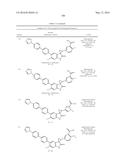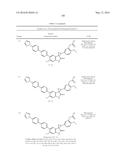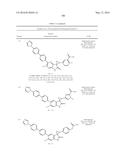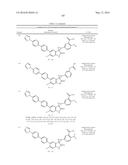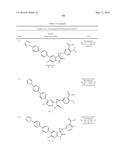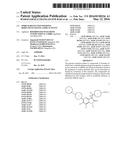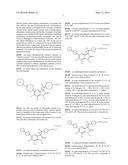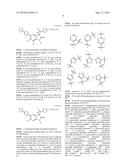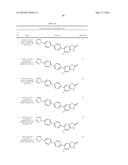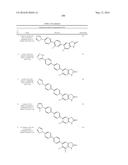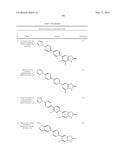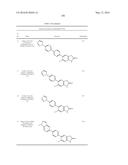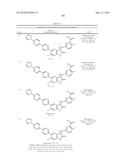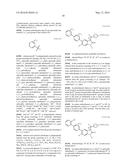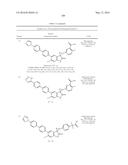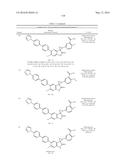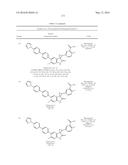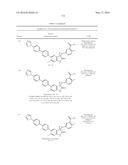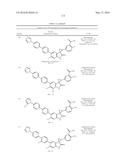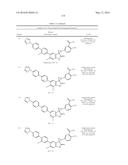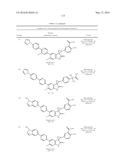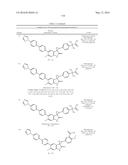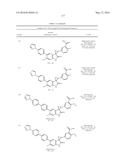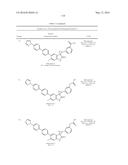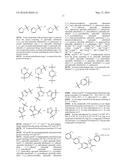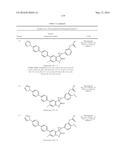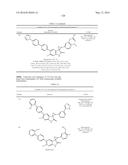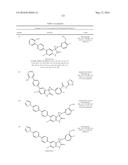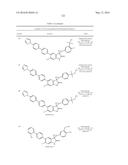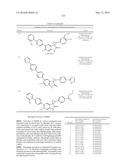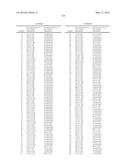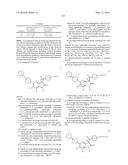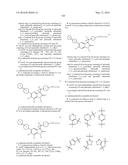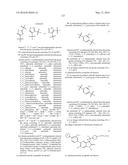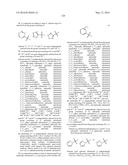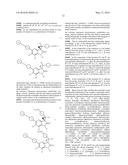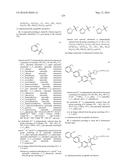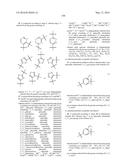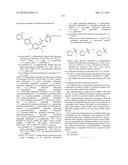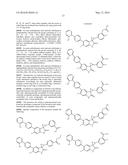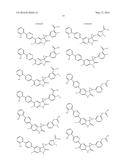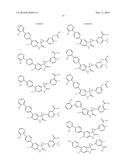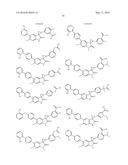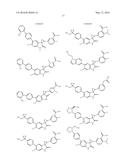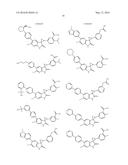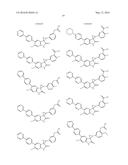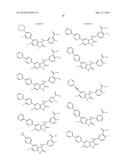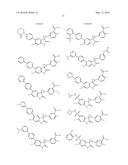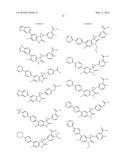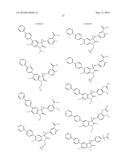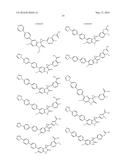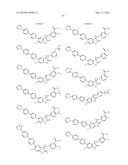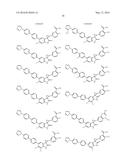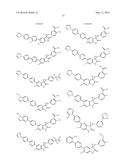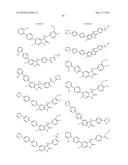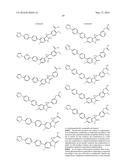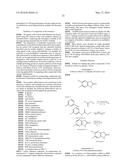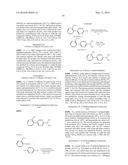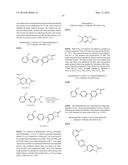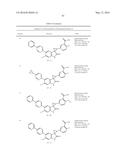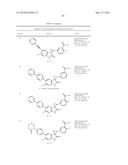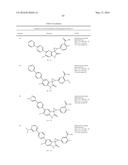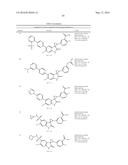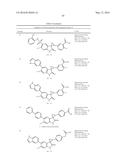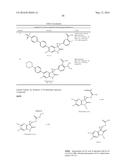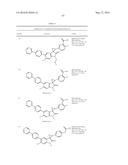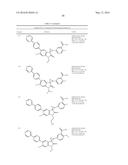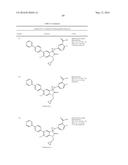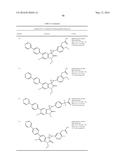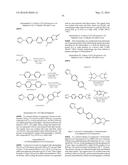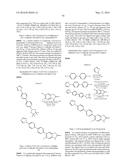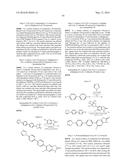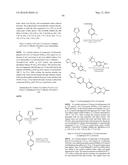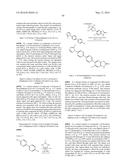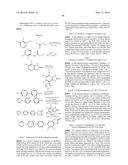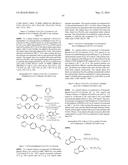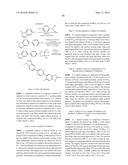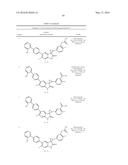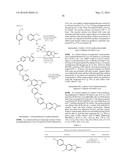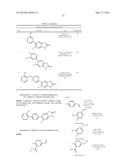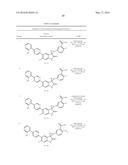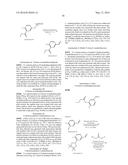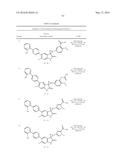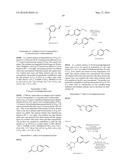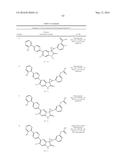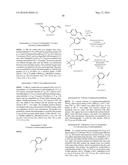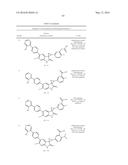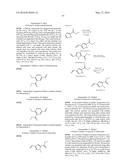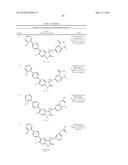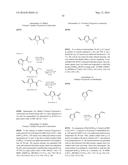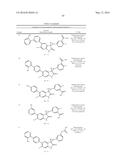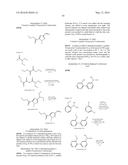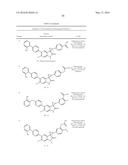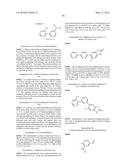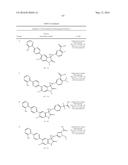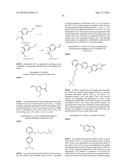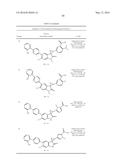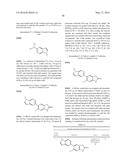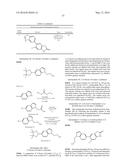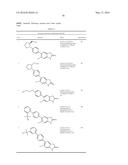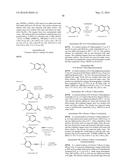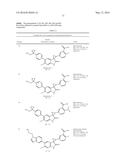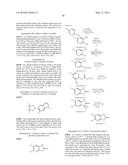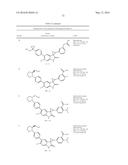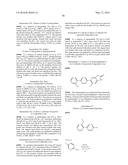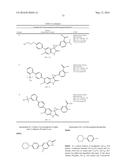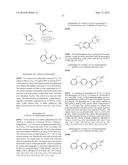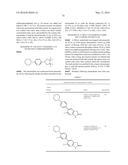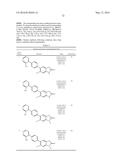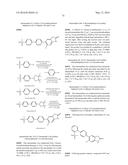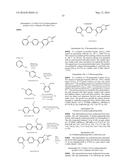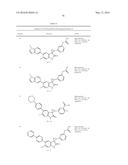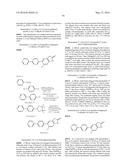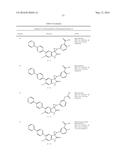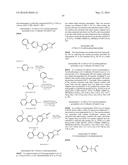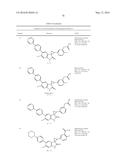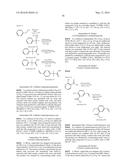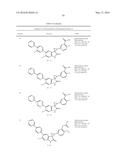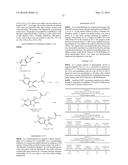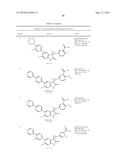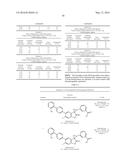Patent application title: SPIRO-SUBSTITUTED OXINDOLE DERIVATIVES HAVING AMPK ACTIVITY
Inventors:
Jagannath Madanahalli Ranganath Rao (Bangalore, IN)
Madhavan Gurram Ranga (Bangalore, IN)
Shanmugam Pachiyappan (Bangalore, IN)
IPC8 Class: AC07D20996FI
USPC Class:
5142352
Class name: Polycyclo ring system having the additional hetero ring as one of the cyclos bicyclo ring system having the additional hetero ring as one of the cyclos ring nitrogen in the bicyclo ring system
Publication date: 2016-05-12
Patent application number: 20160130226
Abstract:
The present invention relates to compounds of formula (I), which have
valuable pharmacological properties, in particular are activators of AMPK
and which are therefore useful in the treatment of certain disorders that
can be prevented or treated by activation of this receptor. The compounds
are suitable for treatment and prevention of diseases which can be
influenced by this receptor, such as metabolic diseases, in particular
diabetes type 2.
##STR00001##Claims:
1. A compound of formula I ##STR00380## wherein ring A is selected from
the group consisting of a bond, optionally substituted
C6-C18aryl and optionally substituted
C1-C18heteroaryl; ring B is selected from the group consisting
of optionally substituted C3-C12cycloalkyl, optionally
substituted C2-C12heterocycloalkyl, optionally substituted
C6-C18aryl and optionally substituted
C1-C18heteroaryl; ring C is selected from the group consisting
of optionally substituted C6-C18aryl and optionally substituted
C1-C18heteroaryl; X is selected from the group consisting of N
and CR3; Y is selected from the group consisting of H, OH,
optionally substituted C1-C18heteroaryl, C(═NH)R8 and
COR8; Z is a bond or a linking moiety; R1 and R2 are each
independently selected from the group consisting of H and optionally
substituted C1-C6 alkyl; R3 and R5 are each
independently selected from the group consisting of H, halogen, CN,
--NO2, SH, CF3, OH, CO2H, CONH2, OCF3, and
optionally substituted C1-C12alkyl; R4 is selected from
the group consisting of H, F, Cl, Br and I; R6 and R7 are each
independently selected from the group consisting of H and optionally
substituted C1-C6alkyl; R8 is selected from the group
consisting of H, OH, optionally substituted C1-C6alkyl and
--NR9R10; wherein R9 and R10 are each independently
selected from the group consisting of H, optionally substituted
C1-C6 alkyl, optionally substituted C1-C18heteroaryl,
and COOR10a, or R9 and R10 when taken together with the
nitrogen atom to which they are attached form an optionally substituted
C2-C12 heterocycloalkyl group; R10a is selected from the
group consisting of H and optionally substituted C1-C6alkyl; n
is an integer selected from the group consisting of 0, 1 and 2; wherein
the term "optionally substituted" used within the definitions
hereinbefore is not limited to but preferably means 1, 2 or 3 optional
substituents independently selected from F, Cl, Br, I, CH3,
CH2CH3, CH(CH3)2, C(CH3)3, OH, OCH3,
OCH2CH3, OCH(CH3)2, OC(CH3)3, CF3,
OCF3, NO2, SO3H, SO2CH3, NH2, NHCH3,
N(CH3)2 and CN; or a pharmaceutically acceptable salt, N-oxide,
or prodrug thereof.
2. A compound according to claim 1, wherein Z is a bond, providing compounds of substructure formula (Ia) ##STR00381## wherein ring A, ring B, ring C, X, R1, R2, R4, R5, R6, R7, Y and n are defined as in claim 1, or a pharmaceutically acceptable salt thereof.
3. A compound according to claim 1, wherein Y is H or COR8 and R8 is H, OH or NR9R10, wherein R9 and R10 are each independently selected from the group consisting of H, C1-C6 alkyl and a 5- or 6-membered C1-C5heteroaryl comprising 1 to 4 N-atoms or 1 O- or S-atom, with the proviso that only one of R9 and R10 denotes a heteroaryl group, or a pharmaceutically acceptable salt thereof;
4. A compound according to claim 3, wherein Y is COR8, and R8 is OH, providing compounds of substructure formula (Ib) ##STR00382## wherein ring A is selected from the group consisting of a bond, optionally substituted C6-C18aryl and optionally substituted C1-C18heteroaryl; ring B is selected from the group consisting of optionally substituted C3-C12cycloalkyl, optionally substituted C2-C12heterocycloalkyl, optionally substituted C6-C18aryl and optionally substituted C1-C18heteroaryl; ring C is selected from the group consisting of optionally substituted C6-C18aryl and optionally substituted C1-C18heteroaryl; X is selected from the group consisting of N and CR3; R1 and R2 are each independently selected from the group consisting of H and optionally substituted C1-C6 alkyl; R3 and R5 are each independently selected from the group consisting of H, halogen, CN, --NO2, SH, CF3, OH, CO2H, CONH2, OCF3, and optionally substituted C1-C12alkyl; R4 is selected from the group consisting of H, F, Cl, Br and I; R6 and R7 are each independently selected from the group consisting of H and optionally substituted C1-C6alkyl; n is an integer selected from the group consisting of 0, 1 and 2; or a pharmaceutically acceptable salt thereof.
5. A compound according to claim 4, wherein X is N, providing compounds of substructure formula (Ic) ##STR00383## or a pharmaceutically acceptable salt thereof.
6. A compound according to claim 4, wherein X is CR3 and R3 is H, providing compounds of substructure formula (Id) ##STR00384## or a pharmaceutically acceptable salt thereof.
7. A compound according to claim 5, wherein R1 and R2 independently are H or a C1-C6 alkyl group, preferably CH3, CH2CH3, CH(CH3)2, or C(CH3)3, and R5 is H, halogen, CN, NO2, SH, CF3, OH, CO2H, CONH2, OCF3 or C1-C12alkyl, or a pharmaceutically acceptable salt thereof.
8. A compound according to claim 5, wherein R1 is H, R2 is H and R5 is H, providing compounds of substructure formula (Ie) ##STR00385## wherein ring A is selected from the group consisting of a bond, optionally substituted C6-C18aryl and optionally substituted C1-C18heteroaryl; ring B is selected from the group consisting of optionally substituted C3-C12cycloalkyl, optionally substituted C2-C12heterocycloalkyl, optionally substituted C6-C18aryl and optionally substituted C1-C18heteroaryl; ring C is selected from the group consisting of optionally substituted C6-C18aryl and optionally substituted C1-C18heteroaryl; R4 is selected from the group consisting of H, F, Cl, Br and I; R6 and R7 are each independently selected from the group consisting of H and optionally substituted C1-C6alkyl; n is an integer selected from the group consisting of 0, 1 and 2; or a pharmaceutically acceptable salt thereof.
9. A compound according to claim 1, wherein ring A is selected from the group consisting of: ##STR00386## wherein V1, V2, V3 and V4 are each independently selected from the group consisting of N, and C(R11); W is selected from the group consisting of O, S and NR11; W1 and W2 are each independently selected from the group consisting of N and CR11; wherein each R11 is independently selected from the group consisting of H, halogen, OH, NO2, CN, SH, NH2, CF3, OCF3, optionally substituted C1-C12alkyl, optionally substituted C1-C12haloalkyl, optionally substituted C2-C12alkenyl, optionally substituted C2-C12haloalkenyl optionally substituted C2-C12alkynyl, optionally substituted C2-C12haloalkynyl, optionally substituted C2-C12heteroalkyl, optionally substituted C3-C12cycloalkyl, optionally substituted C3-C12cycloalkenyl, optionally substituted C2-C12heterocycloalkyl, optionally substituted C2-C12heterocycloalkenyl, optionally substituted C6-C18aryl, optionally substituted C1-C18heteroaryl, optionally C1-C12alkyloxy, optionally substituted C2-C12alkenyloxy, optionally substituted C2-C12alkynyloxy, optionally substituted C2-C10heteroalkyloxy, optionally substituted C3-C12cycloalkyloxy, optionally substituted C3-C12cycloalkenyloxy, optionally substituted C2-C12heterocycloalkyloxy, optionally substituted C2-C12 heterocycloalkenyloxy, optionally substituted C6-C18aryloxy, optionally substituted C1-C12heteroaryloxy, optionally substituted C1-C12alkylamino, SR111, SO3H, SO2NR111R112, SO2R111, SONR111R112, SOR111, COR111, COOH, COOR111, CONR111R112, NR111COR112, NR111COOR112, NR111SO2R112, NR111CONR112R113, NR111R112, and acyl; and each R111, R112 and R113 is independently selected from the group consisting of H, optionally substituted C1-C12alkyl, optionally substituted C2-C10heteroalkyl, optionally substituted C1-C12haloalkyl, optionally substituted C3-C12cycloalkyl, optionally substituted C6-C18aryl, and optionally substituted C1-C18heteroaryl, but wherein preferably each R11 is independently selected from the group consisting of OH, F, Br, Cl, methyl, CN, NO2, SH, CO2H, CONH2, OCF3, trifluoromethyl, ethyl, 2,2,2-trifluoroethyl, isopropyl, propyl, 2-ethyl-propyl, 3,3-dimethyl-propyl, butyl, isobutyl, 3,3-dimethyl-butyl, 2-ethyl-butyl, pentyl, 2-methyl-pentyl, pent-4-enyl, hexyl, heptyl, octyl, phenyl, NH2, phenoxy, hydroxy, methoxy, ethoxy, pyrrol-1-yl, and 3,5-dimethyl-pyrazol-1-yl, or a pharmaceutically acceptable salt thereof.
10. A compound according to claim 1, wherein ring A is an optionally substituted C6-C18aryl group of the formula (II) ##STR00387## wherein each R11 is independently selected from the group consisting of H, halogen, CN, OH, NH2, NO2, SH, CF3, CO2H, CONH2, C1-C12haloalkyl, C1-C12alkoxyl, and C1-C12haloalkoxyl, but preferably R11 is independently selected from the group consisting of H, halogen, CN, --NO2, SH, CF3, OH, CO2H, CONH2, OCF3, and optionally substituted C1-C12alkyl; and m is an integer selected from the group consisting of 0, 1, 2, 3, and 4, or a pharmaceutically acceptable salt thereof.
11. A compound according to claim 8, wherein ring A is an optionally substituted C6-C18aryl group of the formula (II) ##STR00388## wherein each R11 is independently selected from the group consisting of H, halogen, CN, OH, NH2, NO2, SH, CF3, CO2H, CONH2, C1-C12alkyl, C1-C12haloalkyl, C1-C12alkoxyl, and C1-C12haloalkoxyl, but preferably R11 is independently selected from the group consisting of H, halogen, CN, --NO2, SH, CF3, OH, CO2H, CONH2, OCF3, and optionally substituted C1-C12alkyl; and m is an integer selected from the group consisting of 0, 1, 2, 3, and 4, providing compounds of substructure formula (If) ##STR00389## or a pharmaceutically acceptable salt thereof.
12. A compound according to claim 1, wherein ring B is selected from the group consisting of: ##STR00390## wherein V5, V6, V7, V8 and V9 are each independently selected from the group consisting of N, and C(R12); W3 is selected from the group consisting of O, S and NR12; W4, W5, and W6 are each independently selected from the group consisting of N and CR12; wherein each R12 is independently selected from the group consisting of H, halogen, OH, NO2, CN, SH, NH2, CF3, OCF3, optionally substituted C1-C12alkyl, optionally substituted C1-C12haloalkyl, optionally substituted C2-C12alkenyl, optionally substituted C2-C12haloalkenyl optionally substituted C2-C12alkynyl, optionally substituted C2-C12haloalkynyl, optionally substituted C2-C12heteroalkyl, optionally substituted C3-C12cycloalkyl, optionally substituted C3-C12cycloalkenyl, optionally substituted C2-C12heterocycloalkyl, optionally substituted C2-C12heterocycloalkenyl, optionally substituted C6-C18aryl, optionally substituted C1-C18heteroaryl, optionally C1-C12alkyloxy, optionally substituted C2-C12alkenyloxy, optionally substituted C2-C12alkynyloxy, optionally substituted C2-C10heteroalkyloxy, optionally substituted C3-C12cycloalkyloxy, optionally substituted C3-C12cycloalkenyloxy, optionally substituted C2-C12heterocycloalkyloxy, optionally substituted C2-C12 heterocycloalkenyloxy, optionally substituted C6-C18aryloxy, optionally substituted C1-C12heteroaryloxy, optionally substituted C1-C12alkylamino, SR13, SO3H, SO2NR13R14, SO2R13, SONR13R14, SOR13, COR14, COOH, COOR13, CONR14R15, NR14COR15, NR14COOR15, NR14SO2R15, NR13CONR14R15, NR14R15, and acyl; each R13, R14 and R15 is independently selected from the group consisting of H, optionally substituted C1-C12alkyl, optionally substituted C2-C10heteroalkyl, optionally substituted C1-C12haloalkyl, optionally substituted C3-C12cycloalkyl, optionally substituted C6-C18aryl, and optionally substituted C1-C18heteroaryl; but preferably R12 is independently selected from the group consisting of OH, F, Br, Cl, methyl, CN, NO2, SH, CO2H, CONH2, OCF3, trifluoromethyl, ethyl, 2,2,2-trifluoroethyl, isopropyl, propyl, 2-ethyl-propyl, 3,3-dimethyl-propyl, butyl, isobutyl, 3,3-dimethyl-butyl, 2-ethyl-butyl, pentyl, 2-methyl-pentyl, pent-4-enyl, hexyl, heptyl, octyl, phenyl, NH2, phenoxy, hydroxy, methoxy, ethoxy, pyrrol-1-yl, and 3,5-dimethyl-pyrazol-1-yl, or a pharmaceutically acceptable salt thereof.
13. A compound according to claim 1, wherein ring B is an optionally substituted C6-C18aryl group of the formula (III) ##STR00391## wherein each R12 is independently selected from the group consisting of H, halogen, OH, NO2, CN, SH, NH2, CF3, OCF3, optionally substituted C1-C12alkyl, optionally substituted C1-C12haloalkyl, optionally substituted C2-C12alkenyl, optionally substituted C2-C12haloalkenyl optionally substituted C2-C12alkynyl, optionally substituted C2-C12haloalkynyl, optionally substituted C2-C12heteroalkyl, optionally substituted C3-C12cycloalkyl, optionally substituted C3-C12cycloalkenyl, optionally substituted C2-C12heterocycloalkyl, optionally substituted C2-C12heterocycloalkenyl, optionally substituted C6-C18aryl, optionally substituted C1-C18heteroaryl, optionally C1-C12alkyloxy, optionally substituted C2-C12alkenyloxy, optionally substituted C2-C12alkynyloxy, optionally substituted C2-C10heteroalkyloxy, optionally substituted C3-C12cycloalkyloxy, optionally substituted C3-C12cycloalkenyloxy, optionally substituted C2-C12heterocycloalkyloxy, optionally substituted C2-C12 heterocycloalkenyloxy, optionally substituted C6-C18aryloxy, optionally substituted C1-C12heteroaryloxy, optionally substituted C1-C12alkylamino, SR13, SO3H, SO2NR13R14, SO2R13, SONR13R14, SOR13, COR14, COOH, COOR13, CONR14R15, NR14COR15, NR14COOR15, NR14SO2R15, NR13CONR14R15, NR14R15, and acyl; but preferably R12 is independently selected from the group consisting of H, halogen, CN, --NO2, SH, CF3, OH, CO2H, CONH2, OCF3, and optionally substituted C1-C12alkyl; each R13, R14 and R15 independently selected from the group consisting of H, optionally substituted C1-C12alkyl, optionally substituted C2-C10heteroalkyl, optionally substituted C1-C12haloalkyl, optionally substituted C3-C12cycloalkyl, optionally substituted C6-C18aryl, and optionally substituted C1-C18heteroaryl; p is an integer selected from the group consisting of 0, 1, 2, 3, 4 and 5; wherein in a preferred embodiment p is 1 and R12 is an optionally substituted C1-C18heteroaryl selected from the group consisting of ##STR00392## wherein each optional substituent is independently selected from the group consisting of F, Cl, Br, I, CH3, CH2CH3, CH(CH3)2, C(CH3)3, OH, OCH3, OCH2CH3, OCH(CH3)2, OC(CH3)3, CF3, OCF3, NO2, SO3H, SO2CH3, NH2, NHCH3, N(CH3)2 and CN, or a pharmaceutically acceptable salt thereof.
14. A compound according to claim 11, wherein ring B is an optionally substituted C6-C18aryl group of the formula (III) ##STR00393## wherein each R12 is independently selected from the group consisting of H, halogen, OH, NO2, CN, SH, NH2, CF3, OCF3, optionally substituted C1-C12alkyl, optionally substituted C1-C12haloalkyl, optionally substituted C2-C12alkenyl, optionally substituted C2-C12haloalkenyl optionally substituted C2-C12alkynyl, optionally substituted C2-C12haloalkynyl, optionally substituted C2-C12heteroalkyl, optionally substituted C3-C12cycloalkyl, optionally substituted C3-C12cycloalkenyl, optionally substituted C2-C12heterocycloalkyl, optionally substituted C2-C12heterocycloalkenyl, optionally substituted C6-C18aryl, optionally substituted C1-C18heteroaryl, optionally C1-C12alkyloxy, optionally substituted C2-C12alkenyloxy, optionally substituted C2-C12alkynyloxy, optionally substituted C2-C10heteroalkyloxy, optionally substituted C3-C12cycloalkyloxy, optionally substituted C3-C12cycloalkenyloxy, optionally substituted C2-C12heterocycloalkyloxy, optionally substituted C2-C12 heterocycloalkenyloxy, optionally substituted C6-C18aryloxy, optionally substituted C1-C12heteroaryloxy, optionally substituted C1-C12alkylamino, SR13, SO3H, SO2NR13R14, SO2R13, SONR13R14, SOR13, COR14, COOH, COOR13, CONR14R15, NR14COR15, NR14COOR15, NR14SO2R15, NR13CONR14R15, NR14R15, and acyl; but preferably R12 is independently selected from the group consisting of H, halogen, CN, --NO2, SH, CF3, OH, CO2H, CONH2, OCF3, and optionally substituted C1-C12alkyl; each R13, R14 and R15 is independently selected from the group consisting of H, optionally substituted C1-C12alkyl, optionally substituted C2-C10heteroalkyl, optionally substituted C1-C12haloalkyl, optionally substituted C3-C12cycloalkyl, optionally substituted C6-C18aryl, and optionally substituted C1-C18heteroaryl; p is an integer selected from the group consisting of 0, 1, 2, 3, 4 and 5; wherein in a preferred embodiment p is 1 and R12 is an optionally substituted C1-C18heteroaryl selected from the group consisting of ##STR00394## wherein each optional substituent is independently selected from the group consisting of F, Cl, Br, I, CH3, CH2CH3, CH(CH3)2, C(CH3)3, OH, OCH3, OCH2CH3, OCH(CH3)2, OC(CH3)3, CF3, OCF3, NO2, SO3H, SO2CH3, NH2, NHCH3, N(CH3)2 and CN, providing compounds of substructure formula (Ig) ##STR00395## wherein each R11 is independently selected from the group consisting of H, halogen, CN, OH, NH2, NO2, SH, CF3, CO2H, CONH2, C1-C12alkyl, C1-C12haloalkyl, C1-C12alkoxyl, and C1-C12haloalkoxyl, but preferably R11 is independently selected from the group consisting of H, halogen, CN, --NO2, SH, CF3, OH, CO2H, CONH2, OCF3, and optionally substituted C1-C12alkyl; and m is an integer selected from the group consisting of 0, 1, 2, 3, and 4, or a pharmaceutically acceptable salt thereof.
15. A compound according to claim 14 of substructure formula (Iga) ##STR00396## or a pharmaceutically acceptable salt thereof.
16. A compound according to claim 1, wherein ring C is selected from the group consisting of: ##STR00397## wherein V10, V11, V12 and V13 are each independently selected from the group consisting of N, and C(R16); W7 is selected from the group consisting of O, S and NR16; W8 and W9 are each independently selected from the group consisting of N and CR16; wherein each R16 is independently selected from the group consisting of H, halogen, OH, NO2, CN, SH, NH2, CF3, OCF3, optionally substituted C1-C12alkyl, optionally substituted C1-C12haloalkyl, optionally substituted C2-C12alkenyl, optionally substituted C2-C12haloalkenyl optionally substituted C2-C12alkynyl, optionally substituted C2-C12haloalkynyl, optionally substituted C2-C12heteroalkyl, optionally substituted C3-C12cycloalkyl, optionally substituted C3-C12cycloalkenyl, optionally substituted C2-C12heterocycloalkyl, optionally substituted C2-C12heterocycloalkenyl, optionally substituted C6-C18aryl, optionally substituted C1-C18heteroaryl, optionally C1-C12alkyloxy, optionally substituted C2-C12alkenyloxy, optionally substituted C2-C12alkynyloxy, optionally substituted C2-C10heteroalkyloxy, optionally substituted C3-C12cycloalkyloxy, optionally substituted C3-C12cycloalkenyloxy, optionally substituted C2-C12heterocycloalkyloxy, optionally substituted C2-C12 heterocycloalkenyloxy, optionally substituted C6-C18aryloxy, optionally substituted C1-C12heteroaryloxy, optionally substituted C1-C12alkylamino, SR161, SO3H, SO2NR161R162, SO2R161, SONR161R162, SOR161, COR161, COOH, COOR161, CONR161R162, NR161COR162, NR161COOR162, NR161SO2R162, NR161CONR162R163, NR161R162, and acyl; each R161, R162 and R163 is independently selected from the group consisting of H, optionally substituted C1-C12alkyl, optionally substituted C2-C10heteroalkyl, optionally substituted C1-C12haloalkyl, optionally substituted C3-C12cycloalkyl, optionally substituted C6-C18aryl, and optionally substituted C1-C18heteroaryl; wherein each optional substituent is independently selected from the group consisting of F, Cl, Br, I, CH3, CH2CH3, CH(CH3)2, C(CH3)3, OH, OCH3, OCH2CH3, OCH(CH3)z, OC(CH3)3, CF3, OCF3, NO2, SO3H, SO2CH3, NH2, NHCH3, N(CH3)2 and CN, or a pharmaceutically acceptable salt thereof.
17. A compound according to claim 1, wherein ring C is an optionally substituted C6-C18aryl group of the formula (IV) ##STR00398## wherein each R16 is independently selected from the group consisting of H, halogen, CN, --NO2, SH, CF3, OH, CO2H, CONH2, OCF3, C1-C12alkyl and OC1-C12alkyl; and q is an integer selected from the group consisting of 0, 1, 2, 3, and 4, or a pharmaceutically acceptable salt thereof.
18. A compound according to claim 14 of substructure formula (Ih), wherein ring C is an optionally substituted C6-C18aryl group of the formula (IV) ##STR00399## wherein each R16 is independently selected from the group consisting of H, halogen, CN, --NO2, SH, CF3, OH, CO2H, CONH2, OCF3, C1-C12alkyl and OC1-C12alkyl; and q is an integer selected from the group consisting of 0, 1, 2, 3, and 4, providing compounds of substructure formula (Ih) ##STR00400## wherein each R11 is independently selected from the group consisting of H, halogen, CN, OH, NH2, NO2, SH, CF3, CO2H, CONH2, C1-C12alkyl, C1-C12haloalkyl, C1-C12alkoxyl, and C1-C12haloalkoxyl, but preferably R11 is independently selected from the group consisting of H, halogen, CN, --NO2, SH, CF3, OH, CO2H, CONH2, OCF3, and optionally substituted C1-C12alkyl; and m is an integer selected from the group consisting of 0, 1, 2, 3, and 4, each R12 is independently selected from the group consisting of H, halogen, OH, NO2, CN, SH, NH2, CF3, OCF3, optionally substituted C1-C12alkyl, optionally substituted C1-C12haloalkyl, optionally substituted C2-C12alkenyl, optionally substituted C2-C12haloalkenyl optionally substituted C2-C12alkynyl, optionally substituted C2-C12haloalkynyl, optionally substituted C2-C12heteroalkyl, optionally substituted C3-C12cycloalkyl, optionally substituted C3-C12cycloalkenyl, optionally substituted C2-C12heterocycloalkyl, optionally substituted C2-C12heterocycloalkenyl, optionally substituted C6-C18aryl, optionally substituted C1-C18heteroaryl, optionally C1-C12alkyloxy, optionally substituted C2-C12alkenyloxy, optionally substituted C2-C12alkynyloxy, optionally substituted C2-C10heteroalkyloxy, optionally substituted C3-C12cycloalkyloxy, optionally substituted C3-C12cycloalkenyloxy, optionally substituted C2-C12heterocycloalkyloxy, optionally substituted C2-C12 heterocycloalkenyloxy, optionally substituted C6-C18aryloxy, optionally substituted C1-C12heteroaryloxy, optionally substituted C1-C12alkylamino, SR13, SO3H SO2NR13R14, SO2R13, SONR13R14, SOR13, COR14, COOH, COOR13, CONR14R15, NR14COR15, NR14COOR15, NR14SO2R15, NR13CONR14R15, NR14R15, and acyl; but preferably R12 is independently selected from the group consisting of H, halogen, CN, --NO2, SH, CF3, OH, CO2H, CONH2, OCF3, and optionally substituted C1-C12alkyl; each R13, R14 and R15 is independently selected from the group consisting of H, optionally substituted C1-C12alkyl, optionally substituted C2-C10heteroalkyl, optionally substituted C1-C12haloalkyl, optionally substituted C3-C12cycloalkyl, optionally substituted C6-C18aryl, and optionally substituted C1-C18heteroaryl; p is an integer selected from the group consisting of 0, 1, 2, 3, 4 and 5; wherein in a preferred embodiment p is 1 and R12 is an optionally substituted C1-C18heteroaryl selected from the group consisting of ##STR00401## wherein each optional substituent is independently selected from the group consisting of F, Cl, Br, I, CH3, CH2CH3, CH(CH3)2, C(CH3)3, OH, OCH3, OCH2CH3, OCH(CH3)2, OC(CH3)3, CF3, OCF3, NO2, SO3H, SO2CH3, NH2, NHCH3, N(CH3)2 and CN, R4 is selected from the group consisting of H, F, Cl, Br and I; R6 and R7 are each independently selected from the group consisting of H and optionally substituted C1-C6alkyl; n is an integer selected from the group consisting of 0, 1 and 2; or a pharmaceutically acceptable salt thereof.
19. A pharmaceutical composition comprising one or more compounds according to claim 1, optionally together with one or more inert carriers and/or diluents.
20. A pharmaceutical composition according to claim 19 and one or more additional therapeutic agents, optionally together with one or more inert carriers and/or diluents.
21. A pharmaceutical composition according to claim 19 and one additional therapeutic agent selected from the group consisting of antidiabetic agents, agents for the treatment of overweight and/or obesity and agents for the treatment of high blood pressure, heart failure and/or atherosclerosis, optionally together with one or more inert carriers and/or diluents.
22. A method for treating diseases or conditions which can be influenced by the modulation of the function of AMP-activated protein kinase (AMPK), particularly, for the prophylaxis and/or therapy of metabolic diseases, such as diabetes, more specifically type 2 diabetes mellitus, and conditions associated with the disease, including insulin resistance, obesity, cardiovascular disease and dyslipidemia, comprising administering a compound of claim 1 to a patient in need thereof.
23. (canceled)
24. (canceled)
Description:
FIELD OF THE INVENTION
[0001] The present invention relates to heterocyclic organic compounds for therapeutic application in human medicine. The present invention more specifically relates to compounds that have the ability to activate 5' AMP-activated protein kinase (AMPK) which are therefore useful in the treatment of certain disorders that can be prevented or treated by activation of this enzyme. In addition the invention relates to the compounds, methods for their preparation, pharmaceutical compositions containing the compounds and the uses of these compounds in the treatment of certain disorders. It is expected that the compounds of the invention will find application in the treatment of conditions such as non-insulin dependent type 2 diabetes mellitus (NIDDM), insulin resistance, obesity, impaired fasting glucose, impaired glucose tolerance, lipid disorders such as dyslipidemia, hypertension, Cardiovascular diseases, Cancer, Inflammation, trauma and as well as other diseases and conditions.
BACKGROUND OF THE INVENTION
[0002] Metabolic disorders, more specifically Type 2 Diabetes, obesity, cardiovascular diseases that result from both environmental and genetic factors are considered to be some of the fastest growing public health problems globally. These conditions may be associated with reduced insulin action and impaired glucose and lipid metabolism.
[0003] AMPK, a heterotrimeric serine/threonine kinase widely recognized as a key regulator of fatty acid and glucose homeostasis is emerging as an attractive target for the treatment of these conditions since it is involved in the regulation of whole body energy metabolism. It not only plays a key role of an energy sensor by sensing intracellular ATP levels, but also acts as a regulator by being a crucial component in maintaining the energy balance within cells. Under conditions of energy depletion, AMPK inhibits ATP-consuming pathways such as fatty acid synthesis, cholesterol synthesis and gluconeogenesis and stimulates ATP-generating processes such as fatty acid oxidation and glycolysis thus restoring the overall cellular energy homeostasis. Through its central role in the regulation of glucose and lipid metabolism, AMPK has become a promising molecular target for the treatment of metabolic disorders. Moreover, the effects of AMPK activation are pleiotropic in key metabolically relevant tissues, such as liver, skeletal muscle, adipose, and hypothalamus.
[0004] AMPK is a heterotrimeric enzyme comprised of a catalytic (α1 or α2) subunit and two regulatory (β1 or β2 and γ1, γ2, or γ3) subunits, all of which are encoded by separate genes, making it possible to form a total of 12 complexes (Hardie, "AMPK-the fuel gauge of the eukaryotic cell, he FASEB Journal. 2008; 22:114.1).
[0005] A number of physiological processes have been shown to stimulate AMPK, including conditions that lead to alterations of the intracellular AMP/ATP ratio (e.g., hypoxia, glucose deprivation) and calcium concentration, as well as the action of various hormones, cytokines, and adipokines. In mammalian cells, AMPK is activated by increases in intracellular AMP by an allosteric mechanism and by regulating the level of AMPK phosphorylation by inhibiting the dephosphorylation of Thr 172 in the activation loop of the kinase domain (Xiao et al, "Structural basis for AMP binding to mammalian AMP-activated protein kinase", Nature 496, Vol. 449, September 2007).
[0006] The activated form of the enzyme is responsible for metabolic changes via phosphorylation of various downstream substrates. The net effect is a change in local and whole-body energy utilization from an energy consuming state to an energy-producing state in order to restore energy balance. These findings, coupled with reports that AMPK in muscle is activated in response to exercise have led to an intense interest in developing AMPK activators as potential therapies for T2DM and obesity (Zhang, Zhou and Li, "AMPK: An emerging Drug Target for Diabetes and the Metabolic Syndrome", Cell Metabolism 9, May 6, 2009).
[0007] Given the potential broad spectrum of diseases and disorders that can be addressed by activating AMPK, the inventors of this invention have provided a series of oxindole derivatives that activate AMPK and thus can be instrumental in the prophylaxis and treatment of metabolic conditions such as diabetes, obesity, hyperglycemia, glucose intolerance, insulin resistance, hyperinsulemia, hypercholesteremia, hypertension, hyperlipoproteinemia, hyperlipidemia, hypertriglyceridemia, dyslipedemia, metabolic syndrome X, atherosclerosis, diabetic neuropathy, diabetic retinopathy, and hypoglycaemia among others and other disease conditions such as Cancer and Inflammation.
OBJECTS OF INVENTION
[0008] The principal object of the invention is to provide compounds that are activators of 5' AMP-activated protein kinase. These compounds would be expected to be useful in the treatment of 5' AMP-activated protein kinase related conditions as discussed above.
[0009] Another object is to provide a pharmaceutical composition containing a compound that is an activator of 5' AMP-activated protein kinase and a pharmaceutically acceptable excipient, diluent or carrier.
[0010] A further object is to provide a method of prevention or treatment of a condition associated with 5' AMP-activated protein kinase activity in a mammal.
STATEMENT OF INVENTION
[0011] The present invention provides compounds of formula (I):
##STR00002##
wherein
[0012] ring A is selected from the group consisting of a bond, optionally substituted C6-C18aryl and optionally substituted C1-C18heteroaryl;
[0013] ring B is selected from the group consisting of optionally substituted C3-C12cycloalkyl, optionally substituted C2-C12heterocycloalkyl, optionally substituted C6-C18aryl and optionally substituted C1-C18heteroaryl;
[0014] ring C is selected from the group consisting of optionally substituted C6-C18aryl and optionally substituted C1-C18heteroaryl;
[0015] X is selected from the group consisting of N and CR3;
[0016] Y is selected from the group consisting of H, OH, optionally substituted C1-C18heteroaryl, C(═NH)R8 and COR8;
[0017] Z is a bond or a linking moiety;
[0018] R1 and R2 are each independently selected from the group consisting of H and optionally substituted C1-C6 alkyl;
[0019] each R3, and R5 are each independently selected from the group consisting of H, halogen, CN, --NO2, SH, CF3, OH, CO2H, CONH2, OCF3, and optionally substituted C1-C12alkyl;
[0020] R4 is selected from the group consisting of H, F, Cl, Br and I;
[0021] R6 and R7 are each independently selected from the group consisting of H and optionally substituted C1-C6 alkyl;
[0022] R8 is selected from the group consisting of H, OH, optionally substituted C1-C6 alkyl and --NR9R10;
[0023] wherein R9 and R10 are each independently selected from the group consisting of H and optionally substituted C1-C6 alkyl, and optionally substituted C1-C18heteroaryl and COOR10a, or R9 and R10 when taken together to the nitrogen atom to which they are attached form an optionally substituted C2-C12 heterocycloalkyl group,
[0024] R10a is selected from the group consisting of H and optionally substituted C1-C6 alkyl;
[0025] n is an integer selected from the group consisting of 0, 1 and 2;
or a pharmaceutically acceptable salt, N-oxide, or prodrug thereof.
[0026] In a further aspect the invention relates to a pharmaceutical composition containing a compound of the invention and a pharmaceutically acceptable diluent, excipient or carrier.
[0027] In yet an even further aspect the invention relates to a method of prevention or treatment of a condition associated with 5' AMP-activated protein kinase activity in a mammal, the method comprising administering an effective amount of a compound of the invention to the mammal.
[0028] In yet an even further aspect the invention relates to the use of a compound of the invention in the preparation of a medicament for the prevention or treatment of a condition associated with 5' AMP-activated protein kinase activity in a mammal.
[0029] Examples of conditions that may be treated include cancers, dermatological disorders, respiratory and pulmonary system disorders, metabolic disorders, inflammatory diseases and neurodegenerative diseases.
[0030] Examples of cancers include Breast Cancer, Cutaneous T-cell lymphoma (relapsed or refractory cutaneous T-cell lymphoma), Lung cancer, Liver cancer (hepatocellular carcinoma), Kaposi's Sarcoma (AIDS related Kaposi's sarcoma), Cutaneous T-cell lymphoma, Skin cancer (basal cell carcinoma), Non-small cell Lung Cancer, Kidney cancer (advanced renal cell cancer), Gastrointestinal (stomach) cancer (advanced aerodigestive tract cancer), Mesothelioma, and Non-small-cell lung cancer.
[0031] Examples of dermatological disorders include Dermatitis (severe chronic hand eczema in adults), Psoriasis (Severe Plaque Psoriasis), Psoriasis (moderate to severe psoriasis) and alopecia.
[0032] Examples of respiratory and pulmonary system disorders include Bronchial Metaplasia and Pulmonary Fibrosis (Fibrosis).
[0033] Examples of metabolic diseases include Pre diabetes, Type 2 diabetes, Obesity, Hypercholesteriolemia, Hypertriglyceridemia, Hypertension, Dyslipidemia, Liver diseases, NASH, and Atherosclerosis.
[0034] Examples of inflammatory disorders include Renal fibrosis, Hepatic diseases such as steatosis, steatohepatitis (alcoholic and non alcoholic), Hepatic fibrosis and cirrhosis, and Experimental autoimmune encephalomyelitis.
[0035] An example of a neurodegenerative disorder is Alzheimer's disease.
[0036] These and other teachings of the invention are set forth herein.
DETAILED DESCRIPTION OF THE INVENTION
[0037] In this specification a number of terms are used which are well known to a skilled addressee. Nevertheless for the purposes of clarity a number of terms will be defined.
[0038] As used herein, the term "unsubstituted" means that there is no substituent or that the only substituents are hydrogen.
[0039] The term "optionally substituted" as used throughout the specification denotes that the group may or may not be further substituted or fused (so as to form a condensed polycyclic system), with one or more non-hydrogen substituent groups. In certain embodiments the substituent groups are one or more groups independently selected from the group consisting of halogen, ═O, ═S, --CN, --NO2, --CF3, --OCF3, alkyl, alkenyl, alkynyl, haloalkyl, haloalkenyl, haloalkynyl, heteroalkyl, cycloalkyl, cycloalkenyl, heterocycloalkyl, heterocycloalkenyl, aryl, heteroaryl, cycloalkylalkyl, heterocycloalkylalkyl, heteroarylalkyl, arylalkyl, cycloalkylalkenyl, heterocycloalkylalkenyl, arylalkenyl, heteroarylalkenyl, cycloalkylheteroalkyl, heterocycloalkylheteroalkyl, arylheteroalkyl, heteroarylheteroalkyl, hydroxy, hydroxyalkyl, alkyloxy, alkyloxyalkyl, alkyloxycycloalkyl, alkyloxyheterocycloalkyl, alkyloxyaryl, alkyloxyheteroaryl, alkyloxycarbonyl, alkylaminocarbonyl, alkenyloxy, alkynyloxy, cycloalkyloxy, cycloalkenyloxy, heterocycloalkyloxy, heterocycloalkenyloxy, aryloxy, phenoxy, benzyloxy, heteroaryloxy, arylalkyloxy, amino, alkylamino, acylamino, aminoalkyl, arylamino, sulfonylamino, sulfinylamino, sulfonyl, alkylsulfonyl, arylsulfonyl, aminosulfonyl, sulfinyl, alkylsulfinyl, arylsulfinyl, aminosulfinylaminoalkyl, --C(═O)OH, --C(═O)Re, --C(═O)ORe, C(═O)NReRf, C(═NOH)Re, C(═NRe)NRfRg, NReRf, NReC(═O)Rf, NReC(═O)ORf, NReC(═O)NRfRg, NReC(═NRf)NRgRh, NReSO2Rf, --SRe, SO2NReRf, --ORe, OC(═O)NReRf, OC(═O)Re and acyl,
[0040] wherein Re, Rf, Rg and Rh are each independently selected from the group consisting of H, C1-C12alkyl, C1-C12haloalkyl, C2-C12alkenyl, C2-C12alkynyl, C1-C10heteroalkyl, C3-C12cycloalkyl, C3-C12cycloalkenyl, C1-C12heterocycloalkyl, C1-C12heterocycloalkenyl, C6-C18aryl, C1-C18heteroaryl, and acyl, or any two or more of Ra, Rb, Rc and Rd, when taken together with the atoms to which they are attached form a heterocyclic ring system with 3 to 12 ring atoms.
[0041] In some embodiments each optional substituent is independently selected from the group consisting of: halogen, ═O, ═S, --CN, --NO2, --CF3, --OCF3, alkyl, alkenyl, alkynyl, haloalkyl, haloalkenyl, haloalkynyl, heteroalkyl, cycloalkyl, cycloalkenyl, heterocycloalkyl, heterocycloalkenyl, aryl, heteroaryl, hydroxy, hydroxyalkyl, alkyloxy, alkyloxyalkyl, alkyloxyaryl, alkyloxyheteroaryl, alkenyloxy, alkynyloxy, cycloalkyloxy, cycloalkenyloxy, heterocycloalkyloxy, heterocycloalkenyloxy, aryloxy, heteroaryloxy, arylalkyl, heteroarylalkyl, arylalkyloxy, amino, alkylamino, acylamino, aminoalkyl, arylamino, sulfonyl, alkylsulfonyl, arylsulfonyl, aminosulfonyl, aminoalkyl, --COOH, --SH, and acyl.
[0042] Examples of particularly suitable optional substituents include F, Cl, Br, I, CH3, CH2CH3, CH(CH3)2, C(CH3)3, OH, OCH3, OCH2CH3, OCH(CH3)2, OC(CH3)3, CF3, OCF3, NO2, SO3H, SO2CH3, NH2, NHCH3, N(CH3)2 and CN.
[0043] In the definitions of a number of substituents below it is stated that "the group may be a terminal group or a bridging group". This is intended to signify that the use of the term is intended to encompass the situation where the group is a linker between two other portions of the molecule as well as where it is a terminal moiety. Using the term alkyl as an example, some publications would use the term "alkylene" for a bridging group and hence in these other publications there is a distinction between the terms "alkyl" (terminal group) and "alkylene" (bridging group). In the present application no such distinction is made and most groups may be either a bridging group or a terminal group. The expressions linker, linking moiety and bridging group are interchangeably used herein.
[0044] "Acyl" means an R--C(═O)-- group in which the R group may be an alkyl, cycloalkyl, heterocycloalkyl, aryl or heteroaryl group as defined herein. Examples of acyl include acetyl and benzoyl. The group may be a terminal group or a bridging group. If the group is a terminal group it is bonded to the remainder of the molecule through the carbonyl carbon.
[0045] "Acylamino" means an R--C(═O)--NH-- group in which the R group may be an alkyl, cycloalkyl, heterocycloalkyl, aryl or heteroaryl group as defined herein. The group may be a terminal group or a bridging group. If the group is a terminal group it is bonded to the remainder of the molecule through the nitrogen atom.
[0046] "Alkenyl" as a group or part of a group denotes an aliphatic hydrocarbon group containing at least one carbon-carbon double bond and which may be straight or branched preferably having 2-12 carbon atoms, more preferably 2-10 carbon atoms, most preferably 2-6 carbon atoms, in the normal chain. The group may contain a plurality of double bonds in the normal chain and the orientation about each is independently E or Z. The alkenyl group is preferably a 1-alkenyl group. Exemplary alkenyl groups include, but are not limited to, ethenyl, propenyl, butenyl, pentenyl, hexenyl, heptenyl, octenyl and nonenyl. The group may be a terminal group or a bridging group.
[0047] "Alkenyloxy" refers to an alkenyl-O-- group in which alkenyl is as defined herein. Preferred alkenyloxy groups are C1-C6 alkenyloxy groups. The group may be a terminal group or a bridging group. If the group is a terminal group it is bonded to the remainder of the molecule through the oxygen atom.
[0048] "Alkyl" as a group or part of a group refers to a straight or branched aliphatic hydrocarbon group, preferably a C1-C12 alkyl, more preferably a C1-C10 alkyl, most preferably C1-C6 unless otherwise noted. Examples of suitable straight and branched C1-C6 alkyl substituents include methyl, ethyl, n-propyl, 2-propyl, n-butyl, sec-butyl, t-butyl, hexyl, and the like. The group may be a terminal group or a bridging group.
[0049] "Alkylamino" includes both mono-alkylamino and dialkylamino, unless specified. "Mono-alkylamino" means an Alkyl-NH-- group, in which alkyl is as defined herein. "Dialkylamino" means a (alkyl)2N-- group, in which each alkyl may be the same or different and are each as defined herein for alkyl. The alkyl group is preferably a C1-C6alkyl group. The group may be a terminal group or a bridging group. If the group is a terminal group it is bonded to the remainder of the molecule through the nitrogen atom.
[0050] "Alkylaminocarbonyl" refers to a group of the formula (Alkyl)x(H)yNC(═O)-- in which alkyl is as defined herein, x is 1 or 2, and the sum of X+Y=2. The group may be a terminal group or a bridging group. If the group is a terminal group it is bonded to the remainder of the molecule through the carbonyl carbon.
[0051] "Alkyloxy" refers to an alkyl-O-- group in which alkyl is as defined herein. Preferably the alkyloxy is a C1-C6alkyloxy. Examples include, but are not limited to, methoxy and ethoxy. The group may be a terminal group or a bridging group.
[0052] "Alkyloxyalkyl" refers to an alkyloxy-alkyl- group in which the alkyloxy and alkyl moieties are as defined herein. The group may be a terminal group or a bridging group. If the group is a terminal group it is bonded to the remainder of the molecule through the alkyl group.
[0053] "Alkyloxyaryl" refers to an alkyloxy-aryl- group in which the alkyloxy and aryl moieties are as defined herein. The group may be a terminal group or a bridging group. If the group is a terminal group it is bonded to the remainder of the molecule through the aryl group.
[0054] "Alkyloxycarbonyl" refers to an alkyl-O--C(═O)-- group in which alkyl is as defined herein. The alkyl group is preferably a C1-C6 alkyl group. Examples include, but are not limited to, methoxycarbonyl and ethoxycarbonyl. The group may be a terminal group or a bridging group. If the group is a terminal group it is bonded to the remainder of the molecule through the carbonyl carbon.
[0055] "Alkyloxycycloalkyl" refers to an alkyloxy-cycloalkyl- group in which the alkyloxy and cycloalkyl moieties are as defined herein. The group may be a terminal group or a bridging group. If the group is a terminal group it is bonded to the remainder of the molecule through the cycloalkyl group.
[0056] "Alkyloxyheteroaryl" refers to an alkyloxy-heteroaryl- group in which the alkyloxy and heteroaryl moieties are as defined herein. The group may be a terminal group or a bridging group. If the group is a terminal group it is bonded to the remainder of the molecule through the heteroaryl group.
[0057] "Alkyloxyheterocycloalkyl" refers to an alkyloxy-heterocycloalkyl- group in which the alkyloxy and heterocycloalkyl moieties are as defined herein. The group may be a terminal group or a bridging group. If the group is a terminal group it is bonded to the remainder of the molecule through the heterocycloalkyl group.
[0058] "Alkylsulfinyl" means an alkyl-S-(═O)-- group in which alkyl is as defined herein. The alkyl group is preferably a C1-C6 alkyl group. Exemplary alkylsulfinyl groups include, but not limited to, methylsulfinyl and ethylsulfinyl. The group may be a terminal group or a bridging group. If the group is a terminal group it is bonded to the remainder of the molecule through the sulfur atom.
[0059] "Alkylsulfonyl" refers to an alkyl-S(═O)2-- group in which alkyl is as defined above. The alkyl group is preferably a C1-C6alkyl group. Examples include, but not limited to methylsulfonyl and ethylsulfonyl. The group may be a terminal group or a bridging group. If the group is a terminal group it is bonded to the remainder of the molecule through the sulfur atom.
[0060] "Alkynyl" as a group or part of a group means an aliphatic hydrocarbon group containing a carbon-carbon triple bond and which may be straight or branched preferably having from 2-12 carbon atoms, more preferably 2-10 carbon atoms, more preferably 2-6 carbon atoms in the normal chain. Exemplary structures include, but are not limited to, ethynyl and propynyl. The group may be a terminal group or a bridging group.
[0061] "Alkynyloxy" refers to an alkynyl-O-- group in which alkynyl is as defined herein. Preferred alkynyloxy groups are C1-C6alkynyloxy groups. The group may be a terminal group or a bridging group. If the group is a terminal group it is bonded to the remainder of the molecule through the oxygen atom.
[0062] "Aminoalkyl" means an NH2-alkyl- group in which the alkyl group is as defined herein. The group may be a terminal group or a bridging group. If the group is a terminal group it is bonded to the remainder of the molecule through the alkyl group.
[0063] "Aminosulfonyl" means an NH2--S(═O)2-- group. The group may be a terminal group or a bridging group. If the group is a terminal group it is bonded to the remainder of the molecule through the sulfur atom.
[0064] "Aryl" as a group or part of a group denotes (i) an optionally substituted monocyclic, or fused polycyclic, aromatic carbocycle (ring structure having ring atoms that are all carbon) preferably having from 5 to 12 atoms per ring. Examples of aryl groups include phenyl, naphthyl, and the like; (ii) an optionally substituted partially saturated bicyclic aromatic carbocyclic moiety in which a phenyl and a C5-7cycloalkyl or C5-7cycloalkenyl group are fused together to form a cyclic structure, such as tetrahydronaphthyl, indenyl or indanyl. The group may be a terminal group or a bridging group. Typically an aryl group is a C6-C18 aryl group.
[0065] "Arylalkenyl" means an aryl-alkenyl- group in which the aryl and alkenyl are as defined herein. Exemplary arylalkenyl groups include phenylallyl. The group may be a terminal group or a bridging group. If the group is a terminal group it is bonded to the remainder of the molecule through the alkenyl group.
[0066] "Arylalkyl" means an aryl-alkyl- group in which the aryl and alkyl moieties are as defined herein. Preferred arylalkyl groups contain a C1-5alkyl moiety. Exemplary arylalkyl groups include benzyl, phenethyl, 1-naphthalenemethyl and 2-naphthalenemethyl. The group may be a terminal group or a bridging group. If the group is a terminal group it is bonded to the remainder of the molecule through the alkyl group.
[0067] "Arylalkyloxy" refers to an aryl-alkyl-O-- group in which the alkyl and aryl are as defined herein. The group may be a terminal group or a bridging group. If the group is a terminal group it is bonded to the remainder of the molecule through the oxygen atom.
[0068] "Arylamino" includes both mono-arylamino and di-arylamino unless specified. Mono-arylamino means a group of formula arylNH--, in which aryl is as defined herein. Di-arylamino means a group of formula (aryl)2N-- where each aryl may be the same or different and are each as defined herein for aryl. The group may be a terminal group or a bridging group. If the group is a terminal group it is bonded to the remainder of the molecule through the nitrogen atom.
[0069] "Arylheteroalkyl" means an aryl-heteroalkyl- group in which the aryl and heteroalkyl moieties are as defined herein. The group may be a terminal group or a bridging group. If the group is a terminal group it is bonded to the remainder of the molecule through the heteroalkyl group.
[0070] "Aryloxy" refers to an aryl-O-- group in which the aryl is as defined herein. Preferably the aryloxy is a C6-C18aryloxy, more preferably a C6-C10aryloxy. The group may be a terminal group or a bridging group. If the group is a terminal group it is bonded to the remainder of the molecule through the oxygen atom.
[0071] "Arylsulfonyl" means an aryl-S(═O)2-- group in which the aryl group is as defined herein. The group may be a terminal group or a bridging group. If the group is a terminal group it is bonded to the remainder of the molecule through the sulfur atom.
[0072] A "bond" is a linkage between atoms in a compound or molecule. The bond may be a single bond, a double bond, or a triple bond.
[0073] "Cycloalkenyl" means a non-aromatic monocyclic or multicyclic ring system containing at least one carbon-carbon double bond and preferably having from 5-10 carbon atoms per ring. Exemplary monocyclic cycloalkenyl rings include cyclopentenyl, cyclohexenyl or cycloheptenyl. The cycloalkenyl group may be substituted by one or more substituent groups. A cycloalkenyl group typically is a C3-C12 alkenyl group. The group may be a terminal group or a bridging group.
[0074] "Cycloalkyl" refers to a saturated monocyclic or fused or spiro polycyclic, carbocycle preferably containing from 3 to 9 carbons per ring, such as cyclopropyl, cyclobutyl, cyclopentyl, cyclohexyl and the like, unless otherwise specified. It includes monocyclic systems such as cyclopropyl and cyclohexyl, bicyclic systems such as decalin, and polycyclic systems such as adamantane. A cycloalkyl group typically is a C3-C12 alkyl group. The group may be a terminal group or a bridging group.
[0075] "Cycloalkylalkyl" means a cycloalkyl-alkyl- group in which the cycloalkyl and alkyl moieties are as defined herein. Exemplary monocycloalkylalkyl groups include cyclopropylmethyl, cyclopentylmethyl, cyclohexyl methyl and cycloheptylmethyl. The group may be a terminal group or a bridging group. If the group is a terminal group it is bonded to the remainder of the molecule through the alkyl group.
[0076] "Cycloalkylalkenyl" means a cycloalkyl-alkenyl- group in which the cycloalkyl and alkenyl moieties are as defined herein. The group may be a terminal group or a bridging group. If the group is a terminal group it is bonded to the remainder of the molecule through the alkenyl group.
[0077] "Cycloalkylheteroalkyl" means a cycloalkyl-heteroalkyl- group in which the cycloalkyl and heteroalkyl moieties are as defined herein. The group may be a terminal group or a bridging group. If the group is a terminal group it is bonded to the remainder of the molecule through the heteroalkyl group.
[0078] "Cycloalkyloxy" refers to a cycloalkyl-O-- group in which cycloalkyl is as defined herein. Preferably the cycloalkyloxy is a C1-C6cycloalkyloxy. Examples include, but are not limited to, cyclopropanoxy and cyclobutanoxy. The group may be a terminal group or a bridging group. If the group is a terminal group it is bonded to the remainder of the molecule through the oxygen atom.
[0079] "Cycloalkenyloxy" refers to a cycloalkenyl-O-- group in which the cycloalkenyl is as defined herein. Preferably the cycloalkenyloxy is a C1-C6cycloalkenyloxy. The group may be a terminal group or a bridging group. If the group is a terminal group it is bonded to the remainder of the molecule through the oxygen atom.
[0080] "Haloalkyl" refers to an alkyl group as defined herein in which one or more of the hydrogen atoms has been replaced with a halogen atom selected from the group consisting of fluorine, chlorine, bromine and iodine. A haloalkyl group typically has the formula CnH.sub.(2n+1-m)Xm wherein each X is independently selected from the group consisting of F, Cl, Br and I. In groups of this type n is typically from 1 to 10, more preferably from 1 to 6, most preferably 1 to 3. m is typically 1 to 6, more preferably 1 to 3. Examples of haloalkyl include fluoromethyl, difluoromethyl and trifluoromethyl.
[0081] "Haloalkenyl" refers to an alkenyl group as defined herein in which one or more of the hydrogen atoms has been replaced with a halogen atom independently selected from the group consisting of F, Cl, Br and I.
[0082] "Haloalkynyl" refers to an alkynyl group as defined herein in which one or more of the hydrogen atoms has been replaced with a halogen atom independently selected from the group consisting of F, Cl, Br and I.
[0083] "Halogen" represents chlorine, fluorine, bromine or iodine.
[0084] "Heteroalkyl" refers to a straight- or branched-chain alkyl group preferably having from 2 to 12 carbons, more preferably 2 to 6 carbons in the chain, in which one or more of the carbon atoms (and any associated hydrogen atoms) are each independently replaced by a heteroatomic group selected from S, O, P and NR' where R' is selected from the group consisting of H, optionally substituted C1-C12alkyl, optionally substituted C3-C12cycloalkyl, optionally substituted C6-C18aryl, and optionally substituted C1-C18heteroaryl. Exemplary heteroalkyls include alkyl ethers, secondary and tertiary alkyl amines, amides, alkyl sulfides, and the like. Examples of heteroalkyl also include hydroxyC1-C6alkyl, C1-C6alkyloxyC1-C6alkyl, aminoC1-C6alkyl, C1-C6alkylaminoC1-C6alkyl, and di(C1-C6alkyl)aminoC1-C6alkyl. The group may be a terminal group or a bridging group.
[0085] "Heteroalkyloxy" refers to a heteroalkyl-O-- group in which heteroalkyl is as defined herein. Preferably the heteroalkyloxy is a C2-C6heteroalkyloxy. The group may be a terminal group or a bridging group.
[0086] "Heteroaryl" either alone or part of a group refers to groups containing an aromatic ring (preferably a 5 or 6 membered aromatic ring) having one or more heteroatoms as ring atoms in the aromatic ring with the remainder of the ring atoms being carbon atoms. Suitable heteroatoms include nitrogen, oxygen and sulphur. The group may be a monocyclic or bicyclic heteroaryl group. Examples of heteroaryl include thiophene, benzothiophene, benzofuran, benzimidazole, benzoxazole, benzothiazole, benzisothiazole, naphtho[2,3-b]thiophene, furan, isoindolizine, xantholene, phenoxatine, pyrrole, imidazole, pyrazole, pyridine, pyrazine, pyrimidine, pyridazine, tetrazole, indole, isoindole, 1H-indazole, purine, quinoline, isoquinoline, phthalazine, naphthyridine, quinoxaline, cinnoline, carbazole, phenanthridine, acridine, phenazine, thiazole, isothiazole, phenothiazine, oxazole, isooxazole, furazane, phenoxazine, 2-, 3- or 4-pyridyl, 2-, 3-, 4-, 5-, or 8-quinolyl, 1-, 3-, 4-, or 5-isoquinolinyl 1-, 2-, or 3-indolyl, and 2-, or 3-thienyl. A heteroaryl group is typically a C1-C18heteroaryl group. The group may be a terminal group or a bridging group.
[0087] "Heteroarylalkyl" means a heteroaryl-alkyl group in which the heteroaryl and alkyl moieties are as defined herein. Preferred heteroarylalkyl groups contain a lower alkyl moiety. Exemplary heteroarylalkyl groups include pyridylmethyl. The group may be a terminal group or a bridging group. If the group is a terminal group it is bonded to the remainder of the molecule through the alkyl group.
[0088] "Heteroarylalkenyl" means a heteroaryl-alkenyl- group in which the heteroaryl and alkenyl moieties are as defined herein. The group may be a terminal group or a bridging group. If the group is a terminal group it is bonded to the remainder of the molecule through the alkenyl group.
[0089] "Heteroarylheteroalkyl" means a heteroaryl-heteroalkyl- group in which the heteroaryl and heteroalkyl moieties are as defined herein. The group may be a terminal group or a bridging group. If the group is a terminal group it is bonded to the remainder of the molecule through the heteroalkyl group.
[0090] "Heteroaryloxy" refers to a heteroaryl-O-- group in which the heteroaryl is as defined herein. Preferably the heteroaryloxy is a C1-C18heteroaryloxy. The group may be a terminal group or a bridging group. If the group is a terminal group it is bonded to the remainder of the molecule through the oxygen atom.
[0091] "Heterocyclic" refers to saturated, partially unsaturated or fully unsaturated monocyclic, bicyclic or polycyclic ring system containing at least one heteroatom selected from the group consisting of nitrogen, sulfur and oxygen as a ring atom. Examples of heterocyclic moieties include heterocycloalkyl, heterocycloalkenyl and heteroaryl.
[0092] "Heterocycloalkenyl" refers to a heterocycloalkyl group as defined herein but containing at least one double bond. A heterocycloalkenyl group typically is a C2-C12heterocycloalkenyl group. The group may be a terminal group or a bridging group.
[0093] "Heterocycloalkyl" refers to a saturated monocyclic, bicyclic, or polycyclic ring containing at least one heteroatom selected from nitrogen, sulfur, oxygen, preferably from 1 to 3 heteroatoms in at least one ring. Each ring is preferably from 3 to 10 membered, more preferably 4 to 7 membered. Examples of suitable heterocycloalkyl substituents include pyrrolidyl, tetrahydrofuryl, tetrahydrothiofuranyl, piperidyl, piperazyl, tetrahydropyranyl, morphilino, 1,3-diazapane, 1,4-diazapane, 1,4-oxazepane, and 1,4-oxathiapane. A heterocycloalkyl group typically is a C2-C12heterocycloalkyl group. The group may be a terminal group or a bridging group.
[0094] "Heterocycloalkylalkyl" refers to a heterocycloalkyl-alkyl- group in which the heterocycloalkyl and alkyl moieties are as defined herein. Exemplary heterocycloalkylalkyl groups include (2-tetrahydrofuryl)methyl, (2-tetrahydrothiofuranyl) methyl. The group may be a terminal group or a bridging group. If the group is a terminal group it is bonded to the remainder of the molecule through the alkyl group.
[0095] "Heterocycloalkylalkenyl" refers to a heterocycloalkyl-alkenyl- group in which the heterocycloalkyl and alkenyl moieties are as defined herein. The group may be a terminal group or a bridging group. If the group is a terminal group it is bonded to the remainder of the molecule through the alkenyl group.
[0096] "Heterocycloalkylheteroalkyl" means a heterocycloalkyl-heteroalkyl- group in which the heterocycloalkyl and heteroalkyl moieties are as defined herein. The group may be a terminal group or a bridging group. If the group is a terminal group it is bonded to the remainder of the molecule through the heteroalkyl group.
[0097] "Heterocycloalkyloxy" refers to a heterocycloalkyl-O-- group in which the heterocycloalkyl is as defined herein. Preferably the heterocycloalkyloxy is a C1-C6heterocycloalkyloxy. The group may be a terminal group or a bridging group. If the group is a terminal group it is bonded to the remainder of the molecule through the oxygen atom.
[0098] "Heterocycloalkenyloxy" refers to a heterocycloalkenyl-O-- group in which heterocycloalkenyl is as defined herein. Preferably the Heterocycloalkenyloxy is a C1-C6 Heterocycloalkenyloxy. The group may be a terminal group or a bridging group. If the group is a terminal group it is bonded to the remainder of the molecule through the oxygen atom.
[0099] "Hydroxyalkyl" refers to an alkyl group as defined herein in which one or more of the hydrogen atoms has been replaced with an OH group. A hydroxyalkyl group typically has the formula CnH.sub.(2n+1-x)(OH)x. In groups of this type n is typically from 1 to 10, more preferably from 1 to 6, most preferably 1 to 3. x is typically 1 to 6, more preferably 1 to 3.
[0100] "Sulfinyl" means an R--S(═O)-- group in which the R group may be OH, alkyl, cycloalkyl, heterocycloalkyl; aryl or heteroaryl group as defined herein. The group may be a terminal group or a bridging group. If the group is a terminal group it is bonded to the remainder of the molecule through the sulfur atom.
[0101] "Sulfinylamino" means an R--S(═O)--NH-- group in which the R group may be OH, alkyl, cycloalkyl, heterocycloalkyl; aryl or heteroaryl group as defined herein. The group may be a terminal group or a bridging group. If the group is a terminal group it is bonded to the remainder of the molecule through the nitrogen atom.
[0102] "Sulfonyl" means an R--S(═O)2-- group in which the R group may be OH, alkyl, cycloalkyl, heterocycloalkyl; aryl or heteroaryl group as defined herein. The group may be a terminal group or a bridging group. If the group is a terminal group it is bonded to the remainder of the molecule through the sulfur atom.
[0103] "Sulfonylamino" means an R--S(═O)2--NH-- group. The group may be a terminal group or a bridging group. If the group is a terminal group it is bonded to the remainder of the molecule through the nitrogen atom.
[0104] The term "prodrug" as used herein refers to (i) an inactive form of a drug that exerts its effects after metabolic processes within the body converting it to a usable or active form, or (ii) a substance that gives rise to a pharmacologically active metabolite, although not itself active (i.e. an inactive precursor). The terms "prodrug" or "prodrug derivative" mean a covalently-bonded derivative, carrier or precursor of the parent compound or active drug substance which undergoes at least some biotransformation prior to exhibiting its pharmacological effect(s). Such prodrugs either have metabolically cleavable or otherwise convertible groups and are rapidly transformed in vivo to yield the parent compound, for example, by hydrolysis in blood or by activation via oxidation as in case of thioether groups. Most common prodrugs include esters and amide analogs of the parent compounds. The prodrug is formulated with the objectives of improved chemical stability, improved patient acceptance and compliance, improved bioavailability, prolonged duration of action, improved organ selectivity, improved formulation (e.g., increased hydrosolubility), and/or decreased side effects (e.g., toxicity). In general, prodrugs themselves have weak or no biological activity and are stable under ordinary conditions. Prodrugs can be readily prepared from the parent compounds using methods known in the art, such as those described in A Textbook of Drug Design and Development, Krogsgaard-Larsen and H. Bundgaard (eds.), Gordon & Breach, 1991, particularly Chapter 5: "Design and Applications of Prodrugs"; Design of Prodrugs, H. Bundgaard (ed.), Elsevier, 1985; Prodrugs: Topical and Ocular Drug Delivery, K. B. Sloan (ed.), Marcel Dekker, 1998; Methods in Enzymology, K. Widder et al. (eds.), Vol. 42, Academic Press, 1985, particularly pp. 309-396; Burger's Medicinal Chemistry and Drug Discovery, 5th Ed., M. Wolff (ed.), John Wiley & Sons, 1995, particularly Vol. 1 and pp. 172-178 and pp. 949-982; Pro-Drugs as Novel Delivery Systems, T. Higuchi and V. Stella (eds.), Am. Chem. Soc., 1975; Bioreversible Carriers in Drug Design, E. B. Roche (ed.), Elsevier, 1987, each of which is incorporated herein by reference in their entireties.
[0105] It is understood that included in the family of compounds of Formula (I) are isomeric forms including diastereoisomers, enantiomers, tautomers, and geometrical isomers in "E" or "Z" configurational isomer or a mixture of E and Z isomers. It is also understood that some isomeric forms such as diastereomers, enantiomers, and geometrical isomers can be separated by physical and/or chemical methods and by those skilled in the art. For those compounds where there is the possibility of geometric isomerism the applicant has drawn the isomer that the compound is thought to be although it will be appreciated that the other isomer may be the correct structural assignment. Where the structural isomer is not known or where the compound is thought to be a mixture of the two isomers the attachment to the double bond is shown as a wavy line.
[0106] Some of the compounds of the disclosed embodiments may exist as single stereoisomers, racemates, and/or mixtures of enantiomers and/or diastereomers. All such single stereoisomers, racemates and mixtures thereof, are intended to be within the scope of the subject matter described and claimed.
[0107] Additionally, Formula (I) is intended to cover, where applicable, solvated as well as unsolvated forms of the compounds. Thus, each formula includes compounds having the indicated structure, including the hydrated as well as the non-hydrated forms.
[0108] The term "pharmaceutically acceptable salts" refers to salts that retain the desired biological activity of the above-identified compounds, and include pharmaceutically acceptable acid addition salts and base addition salts. Suitable pharmaceutically acceptable acid addition salts of compounds of Formula (I) may be prepared from an inorganic acid or from an organic acid. Examples of such inorganic acids are hydrochloric, sulfuric, and phosphoric acid. Appropriate organic acids may be selected from aliphatic, cycloaliphatic, aromatic, heterocyclic carboxylic and sulfonic classes of organic acids, examples of which are formic, acetic, propanoic, succinic, glycolic, gluconic, lactic, malic, tartaric, citric, fumaric, maleic, alkyl sulfonic, arylsulfonic. In a similar vein base addition salts may be prepared by ways well known in the art using organic or inorganic bases. Example of suitable organic bases include simple amines such as methylamine, ethylamine, triethylamine and the like. Examples of suitable inorganic bases include NaOH, KOH, and the like. Additional information on pharmaceutically acceptable salts can be found in Remington's Pharmaceutical Sciences, 19th Edition, Mack Publishing Co., Easton, Pa. 1995. In the case of agents that are solids, it is understood by those skilled in the art that the inventive compounds, agents and salts may exist in different crystalline or polymorphic forms, all of which are intended to be within the scope of the present invention and specified formulae.
[0109] The term "therapeutically effective amount" or "effective amount" is an amount sufficient to effect beneficial or desired clinical results. An effective amount can be administered in one or more administrations. An effective amount is typically sufficient to palliate, ameliorate, stabilize, reverse, slow or delay the progression of the disease state.
[0110] As stated above the compounds of the invention have the formula:
##STR00003##
[0111] As with any group of structurally related compounds which possess a particular utility, certain embodiments of variables of the compounds of the Formula (I), are particularly useful in their end use application.
[0112] In certain embodiments of the invention Z is a bond. This provides compounds of formula (Ia).
##STR00004##
[0113] or a pharmaceutically acceptable salt thereof;
[0114] wherein ring A, Ring B, Ring C, X, R1, R2, R4, R5, R6, R7, Y and n are as defined above.
[0115] In some embodiments Y is H. In some embodiments Y is COR8.
[0116] In some embodiments R8 is H. In certain embodiments R8 is NR9R10. In certain embodiments R8 is OH.
[0117] In certain embodiments of the invention Z is a bond, Y is COR8, and R8 is OH. This provides compounds of formula (Ib).
##STR00005##
[0118] or a pharmaceutically acceptable salt thereof;
[0119] wherein ring A, Ring B, Ring C, X, R1, R2, R4, R5, R6, R7 and n are as defined above.
[0120] In some embodiments of the invention X is N. In some embodiments of the invention X is CR3.
[0121] As stated above R3 is selected from the group consisting of H, halogen, CN, --NO2, SH, CF3, OH, CO2H, CONH2, OCF3, and optionally substituted C1-C12alkyl.
[0122] In some embodiments R3 is H. In some embodiments R3 is halogen. In some embodiments R3 is CN. In some embodiments R3 is NO2. In some embodiments R3 is SH. In some embodiments R3 is CF3. In some embodiments R3 is OH. In some embodiments R3 is CO2H. In some embodiments R3 is CONH2. In some embodiments R3 is OCF3. In some embodiments R3 is C1-C12alkyl.
[0123] In some embodiments Z is a bond, Y is COR8, R8 is OH and X is N. This provides compounds of formula (Ic).
##STR00006##
[0124] or a pharmaceutically acceptable salt thereof;
[0125] wherein ring A, Ring B, Ring C, R1, R2, R4, R5, R6, R7 and n are as defined above.
[0126] In some embodiments Z is a bond, Y is COR8, R8 is OH, X is CR3 and R3 is H. This provides compounds of formula (Id).
##STR00007##
[0127] or a pharmaceutically acceptable salt thereof;
[0128] wherein ring A, Ring B, Ring C, R1, R2, R4, R5, R6, R7 and n are as defined above.
[0129] In some embodiments R1 is H. In some embodiments R1 is an optionally substituted C1-C6 alkyl. In some embodiments R1 is CH3. In some embodiments R1 is CH2CH3. In some embodiments R1 is CH(CH3)2. In some embodiments R1 is C(CH3)3.
[0130] In some embodiments R2 is H. In some embodiments R2 is and optionally substituted C1-C6 alkyl. In some embodiments R2 is CH3. In some embodiments R2 is CH2CH3. In some embodiments R2 is CH(CH3)2. In some embodiments R2 is C(CH3)3.
[0131] In some embodiments R5 is H. In some embodiments R5 is halogen. In some embodiments R5 is CN. In some embodiments R5 is NO2. In some embodiments R5 is SH. In some embodiments R5 is CF3. In some embodiments R5 is OH. In some embodiments R5 is CO2H. In some embodiments R5 is CONH2. In some embodiments R5 is OCF3. In some embodiments R5 is C1-C12alkyl.
[0132] In some embodiments Z is a bond, Y is COW, R8 is OH, X is CR3, R1 is H, R2 is H, R3 is H and R5 is H. This provides compounds of formula (Ie):
##STR00008##
[0133] or a pharmaceutically acceptable salt thereof;
[0134] wherein ring A, Ring B, Ring C, R4, R6, R7 and n are as defined above.
[0135] In the compounds of the invention ring A is selected from the group consisting of a bond, optionally substituted C6-C18aryl and optionally substituted C1-C18heteroaryl. In certain embodiments ring A is a bond. In certain embodiments ring A is optionally substituted C6-C18aryl. In certain embodiments ring A is optionally substituted C1-C18heteroaryl. Ring A may be a monocyclic, bicyclic or polycyclic moiety. In certain embodiments ring A is a monocyclic moiety. In certain embodiments ring A is bicyclic moiety.
[0136] In certain embodiments ring A is selected from the group consisting of:
##STR00009##
[0137] wherein V1, V2, V3 and V4 are each independently selected from the group consisting of N, and C(R11);
[0138] W is selected from the group consisting of O, S and NR11;
[0139] W1 and W2 are each independently selected from the group consisting of N and CR11;
[0140] wherein each R11 is independently selected from the group consisting of H, halogen, OH, NO2, CN, SH, NH2, CF3, OCF3, optionally substituted C1-C12alkyl, optionally substituted C1-C12haloalkyl, optionally substituted C2-C12alkenyl, optionally substituted C2-C12haloalkenyl optionally substituted C2-C12alkynyl, optionally substituted C2-C12haloalkynyl, optionally substituted C2-C12heteroalkyl, optionally substituted C3-C12cycloalkyl, optionally substituted C3-C12cycloalkenyl, optionally substituted C2-C12heterocycloalkyl, optionally substituted C2-C12heterocycloalkenyl, optionally substituted C6-C18aryl, optionally substituted C1-C18heteroaryl, optionally C1-C12alkyloxy, optionally substituted C2-C12alkenyloxy, optionally substituted C2-C12alkynyloxy, optionally substituted C2-C10heteroalkyloxy, optionally substituted C3-C12cycloalkyloxy, optionally substituted C3-C12cycloalkenyloxy, optionally substituted C2-C12heterocycloalkyloxy, optionally substituted C2-C12 heterocycloalkenyloxy, optionally substituted C6-C18aryloxy, optionally substituted C1-C12heteroaryloxy, optionally substituted C1-C12alkylamino, SR111, SO3H, SO2NR111R112, SO2R111, SONR111R112, SOR111, COR111, COOH, COOR111, CONR111R112, NR111COR112, NR111COOR112, NR111SO2R112, NR111CONR112R113, NR111R112, and acyl;
[0141] each R111, R112 and R113 is independently selected from the group consisting of H, optionally substituted C1-C12alkyl, optionally substituted C2-C10heteroalkyl, optionally substituted C1-C12haloalkyl, optionally substituted C3-C12cycloalkyl, optionally substituted C6-C18aryl, and optionally substituted C1-C18heteroaryl.
[0142] Examples of particularly values of R11 include, but are not limited to OH, F, Br, Cl, methyl, CN, NO2, SH, CO2H, CONH2, OCF3, trifluoromethyl, ethyl, 2,2,2-trifluoroethyl, isopropyl, propyl, 2-ethyl-propyl, 3,3-dimethyl-propyl, butyl, isobutyl, 3,3-dimethyl-butyl, 2-ethyl-butyl, pentyl, 2-methyl-pentyl, pent-4-enyl, hexyl, heptyl, octyl, phenyl, NH2, phenoxy, hydroxy, methoxy, ethoxy, pyrrol-1-yl, and 3,5-dimethyl-pyrazol-1-yl.
[0143] In certain embodiments ring A is an optionally substituted C6-C18aryl group of the formula (II):
##STR00010##
[0144] wherein each R11 is independently selected from the group consisting of H, halogen, CN, OH, NH2, NO2, SH, CF3, CO2H, CONH2, C1-C12alkyl, C1-C12haloalkyl, C1-C12alkoxyl, and C1-C12haloalkoxyl,
[0145] m is an integer selected from the group consisting of 0, 1, 2, 3, and 4.
[0146] In certain embodiments each R11 is independently selected from the group consisting of H, halogen, CN, --NO2, SH, CF3, OH, CO2H, CONH2, OCF3, and optionally substituted C1-C12alkyl;
[0147] In the compounds of the invention m is an integer selected from the group consisting of 0, 1, 2, 3 and 4. In some embodiments m is 0. In some embodiments m is 1. In some embodiments m is 2. In some embodiments m is 3. In some embodiments m is 4.
[0148] In some embodiments Z is a bond, Y is COR8, R8 is OH, X is CR3, R1 is H, R2 is H, R3 is H, R5 is H and ring A is a compound of formula (II). This provides compounds of formula (If).
##STR00011##
[0149] or a pharmaceutically acceptable salt thereof;
[0150] wherein Ring B, Ring C, R4, R6, R7, R11, n and m are as defined above.
[0151] In the compounds of the invention ring B is selected from the group consisting of optionally substituted C3-C12cycloalkyl, optionally substituted C2-C12heterocycloalkyl, optionally substituted C6-C18aryl and optionally substituted C1-C18heteroaryl. In certain embodiments ring B is optionally substituted C3-C12cycloalkyl. In certain embodiments ring B is optionally substituted C2-C12heterocycloalkyl. In certain embodiments ring B is optionally substituted C6-C18aryl. In certain embodiments ring B is optionally substituted C1-C18heteroaryl. Ring B may be a monocyclic, bicyclic or polycyclic moiety. In certain embodiments ring B is a monocyclic moiety. In certain embodiments ring B is a bicyclic moiety.
[0152] In certain embodiments ring B is selected from the group consisting of:
##STR00012##
wherein V5, V6, V7, V8 and V9 are each independently selected from the group consisting of N, and C(R12);
[0153] W3 is selected from the group consisting of O, S and NR12;
[0154] W4, W5, and W6 are each independently selected from the group consisting of N and CR12;
[0155] wherein each R12 is independently selected from the group consisting of H, halogen, OH, NO2, CN, SH, NH2, CF3, OCF3, optionally substituted C1-C12alkyl, optionally substituted C1-C12haloalkyl, optionally substituted C2-C12alkenyl, optionally substituted C2-C12haloalkenyl optionally substituted C2-C12alkynyl, optionally substituted C2-C12haloalkynyl, optionally substituted C2-C12heteroalkyl, optionally substituted C3-C12cycloalkyl, optionally substituted C3-C12cycloalkenyl, optionally substituted C2-C12heterocycloalkyl, optionally substituted C2-C12heterocycloalkenyl, optionally substituted C6-C18aryl, optionally substituted C1-C18heteroaryl, optionally C1-C12alkyloxy, optionally substituted C2-C12alkenyloxy, optionally substituted C2-C12alkynyloxy, optionally substituted C2-C10heteroalkyloxy, optionally substituted C3-C12cycloalkyloxy, optionally substituted C3-C12cycloalkenyloxy, optionally substituted C2-C12heterocycloalkyloxy, optionally substituted C2-C12 heterocycloalkenyloxy, optionally substituted C6-C18aryloxy, optionally substituted C1-C12heteroaryloxy, optionally substituted C1-C12alkylamino, SR13, SO3H, SO2NR13R14, SO2R13, SONR13R14, SOR13, COR14, COOH, COOR13, CONR14R15, NR14COR15, NR14COOR15, NR14SO2R15, NR13CONR14R15, NR14R15, and acyl;
[0156] each R13, R14 and R15 is independently selected from the group consisting of H, optionally substituted C1-C12alkyl, optionally substituted C2-C10heteroalkyl, optionally substituted C1-C12haloalkyl, optionally substituted C3-C12cycloalkyl, optionally substituted C6-C18aryl, and optionally substituted C1-C18heteroaryl;
[0157] Examples of particularly values of R12 include, but are not limited to OH, F, Br, Cl, methyl, CN, NO2, SH, CO2H, CONH2, OCF3, trifluoromethyl, ethyl, 2,2,2-trifluoroethyl, isopropyl, propyl, 2-ethyl-propyl, 3,3-dimethyl-propyl, butyl, isobutyl, 3,3-dimethyl-butyl, 2-ethyl-butyl, pentyl, 2-methyl-pentyl, pent-4-enyl, hexyl, heptyl, octyl, phenyl, NH2, phenoxy, hydroxy, methoxy, ethoxy, pyrrol-1-yl, and 3,5-dimethyl-pyrazol-1-yl.
[0158] In certain embodiments ring B is an optionally substituted C6-C18aryl group of the formula (III):
##STR00013##
[0159] wherein each R12 is independently selected from the group consisting of H, halogen, OH, NO2, CN, SH, NH2, CF3, OCF3, optionally substituted C1-C12alkyl, optionally substituted C1-C12haloalkyl, optionally substituted C2-C12alkenyl, optionally substituted C2-C12haloalkenyl optionally substituted C2-C12alkynyl, optionally substituted C2-C12haloalkynyl, optionally substituted C2-C12heteroalkyl, optionally substituted C3-C12cycloalkyl, optionally substituted C3-C12cycloalkenyl, optionally substituted C2-C12heterocycloalkyl, optionally substituted C2-C12heterocycloalkenyl, optionally substituted C6-C18aryl, optionally substituted C1-C18heteroaryl, optionally C1-C12alkyloxy, optionally substituted C2-C12alkenyloxy, optionally substituted C2-C12alkynyloxy, optionally substituted C2-C10heteroalkyloxy, optionally substituted C3-C12cycloalkyloxy, optionally substituted C3-C12cycloalkenyloxy, optionally substituted C2-C12heterocycloalkyloxy, optionally substituted C2-C12 heterocycloalkenyloxy, optionally substituted C6-C18aryloxy, optionally substituted C1-C12heteroaryloxy, optionally substituted C1-C12alkylamino, SR13, SO3H, SO2NR13R14, SO2R13, SONR13R14, SOR13, COR14, COOH, COOR13, CONR14R15, NR14COR15, NR14COOR15, NR14SO2R15, NR13CONR14R15, NR14R15, and acyl;
[0160] each R13, R14 and R15 is independently selected from the group consisting of H, optionally substituted C1-C12alkyl, optionally substituted C2-C10heteroalkyl, optionally substituted C1-C12haloalkyl, optionally substituted C3-C12cycloalkyl, optionally substituted C6-C18aryl, and optionally substituted C1-C18heteroaryl;
[0161] p is an integer selected from the group consisting of 0, 1, 2, 3, 4 and 5;
[0162] wherein each optional substituent is independently selected from the group consisting of F, Cl, Br, I, CH3, CH2CH3, CH(CH3)2, C(CH3)3, OH, OCH3, OCH2CH3, OCH(CH3)2, OC(CH3)3, CF3, OCF3, NO2, SO3H, SO2CH3, NH2, NHCH3, N(CH3)2 and CN.
[0163] In some embodiments Z is a bond, Y is COR8, R8 is OH, X is CR3, R1 is H, R2 is H, R3 is H, R5 is H, ring A is a compound of formula (II) and ring B is a compound of formula (III). This provides compounds of formula (Ig).
##STR00014##
[0164] or a pharmaceutically acceptable salt thereof;
[0165] wherein Ring C, R4, R6, R7, R11, R12, m, n and p are as defined above.
[0166] In the compounds of the invention p is an integer selected from the group consisting of 0, 1, 2, 3, 4 and 5. In some embodiments p is 0. In some embodiments p is 1. In some embodiments p is 2. In some embodiments p is 3. In some embodiments p is 4. In some embodiments P is 5.
[0167] In certain embodiments each R12 is independently selected from the group consisting of H, halogen, CN, --NO2, SH, CF3, OH, CO2H, CONH2, OCF3, and optionally substituted C1-C12alkyl.
[0168] In embodiments where p is 1 the R12 group may be at any location around the aromatic ring. In certain embodiments the R12 group is located ortho to the point of attachment to the A ring. In certain embodiment the R12 group is located meta to the point of attachment to the A ring. In certain embodiments the R12 group is located para to the point of attachment to the A ring.
[0169] In certain embodiments p is 1 and R12 is OH. In certain embodiments where p is 1 and R12 is OH, the OH group is located at the ortho position. This provides compounds of formula (Iga):
##STR00015##
[0170] wherein Ring C, R4, R6, R7, R11, R12, m and n are as defined above.
[0171] In certain embodiments p is 1 and R12 is optionally substituted C1-C18heteroaryl. In certain embodiments R12 is an optionally substituted C1-C18heteroaryl selected from the group consisting of:
##STR00016##
[0172] In the compounds of the invention ring C is selected from the group consisting of optionally substituted C6-C18aryl and optionally substituted C1-C18heteroaryl. In certain embodiments ring C is optionally substituted C6-C18aryl. In certain embodiments ring C is optionally substituted C1-C18heteroaryl. Ring C may be a monocyclic, bicyclic or polycyclic moiety. In certain embodiments ring C is a monocyclic moiety. In certain embodiments each of ring C is bicyclic moiety.
[0173] In certain embodiments ring C is selected from the group consisting of:
##STR00017##
[0174] wherein V10, V11, V12 and V13 are each independently selected from the group consisting of N, and C(R16);
[0175] W7 is selected from the group consisting of O, S and NR16;
[0176] W8 and W9 are each independently selected from the group consisting of N and CR16;
[0177] wherein each R16 is independently selected from the group consisting of H, halogen, OH, NO2, CN, SH, NH2, CF3, OCF3, optionally substituted C1-C12alkyl, optionally substituted C1-C12haloalkyl, optionally substituted C2-C12alkenyl, optionally substituted C2-C12haloalkenyl optionally substituted C2-C12alkynyl, optionally substituted C2-C12haloalkynyl, optionally substituted C2-C12heteroalkyl, optionally substituted C3-C12cycloalkyl, optionally substituted C3-C12cycloalkenyl, optionally substituted C2-C12heterocycloalkyl, optionally substituted C2-C12heterocycloalkenyl, optionally substituted C6-C18aryl, optionally substituted C1-C18heteroaryl, optionally C1-C12alkyloxy, optionally substituted C2-C12alkenyloxy, optionally substituted C2-C12alkynyloxy, optionally substituted C2-C10heteroalkyloxy, optionally substituted C3-C12cycloalkyloxy, optionally substituted C3-C12cycloalkenyloxy, optionally substituted C2-C12heterocycloalkyloxy, optionally substituted C2-C12 heterocycloalkenyloxy, optionally substituted C6-C18aryloxy, optionally substituted C1-C12heteroaryloxy, optionally substituted C1-C12alkylamino, SR161, SO3H, SO2NR161R162, SO2R161, SONR161R162, SOR161, COR161, COOH, COOR161, CONR161R162, NR161COR162, NR161COOR162, NR161SO2R162, NR161CONR162R163, NR161R162, and acyl;
[0178] each R161, R162 and R163 is independently selected from the group consisting of H, optionally substituted C1-C12alkyl, optionally substituted C2-C10heteroalkyl, optionally substituted C1-C12haloalkyl, optionally substituted C3-C12cycloalkyl, optionally substituted C6-C18aryl, and optionally substituted C1-C18heteroaryl.
[0179] In certain embodiments ring C is an optionally substituted C6-C18aryl group of the formula (IV):
##STR00018##
[0180] wherein each R16 is independently selected from the group consisting of H, halogen, CN, --NO2, SH, CF3, OH, CO2H, CONH2, OCF3, C1-C12alkyl and O C1-C12alkyl;
[0181] q is an integer selected from the group consisting of 0, 1, 2, 3, and 4.
[0182] In the compounds of the invention q is an integer selected from the group consisting of 0, 1, 2, 3, and 4. In some embodiments q is 0. In some embodiments q is 1. In some embodiments q is 2. In some embodiments q is 3. In some embodiments q is 4
[0183] In some embodiments Z is a bond, Y is COR8, R8 is OH, X is CR3, R1 is H, R2 is H, R3 is H, R5 is H, ring A is a compound of formula (II), ring B is a compound of formula (III) and ring C is a compound of formula (IV). This provides compounds of formula (Ih).
##STR00019##
[0184] or a pharmaceutically acceptable salt thereof;
[0185] wherein R4, R6, R7, R11, R12, R16, m, n, p and q are as defined above.
[0186] In one embodiment the invention relates to compounds of formula I.I, as a substructure of formula I,
##STR00020##
wherein the ring C and the C(═O)NR1 moiety are located on the same face of the cyclopropane ring (cis relationship) and all other variables are defined as mentioned hereinbefore under formula I, the isoforms, tautomers, stereoisomers, metabolites, prodrugs, solvates, hydrates, and the salts thereof, particularly the physiologically acceptable salts thereof with inorganic or organic acids or bases, or the combinations thereof.
[0187] In another embodiment the invention relates to compounds of formula I.II, as a substructure of formula I,
##STR00021##
wherein the ring C and the C(═O)NR1 moiety are located on opposite faces of the cyclopropane ring (trans relationship) and all other variables are defined as mentioned hereinbefore under formula I, the isoforms, tautomers, stereoisomers, metabolites, prodrugs, solvates, hydrates, and the salts thereof, particularly the physiologically acceptable salts thereof with inorganic or organic acids or bases, or the combinations thereof.
[0188] This cis relationship and trans relationship applies accordingly to any of the substructures defined herein by formulas Ia, Ib, Ic, Id, Ie, If, Ig, Iga and Ih.
[0189] In the compounds of the invention n is an integer selected from the group consisting of 0, 1, and 2. In some embodiments n is 0. In some embodiments n is 1. In some embodiments n is 2.
[0190] In the compounds of the invention R6 and R7 are each independently is selected from the group consisting of H and optionally substituted C1-C6 alkyl. In some embodiments R6 is H. In some embodiments R6 is C1-C6 alkyl. In some embodiments R6 is methyl. In some embodiments R7 is H. In some embodiments R7 is C1-C6 alkyl. In some embodiments R7 is methyl. In some embodiments R6 and R7 are both H. In some embodiments R6 and R7 are both C1-C6 alkyl. In some embodiments one of R6 and R7 is H and the other is C1-C6 alkyl
[0191] In the compounds of the invention R4 is selected from the group consisting of H, F, Cl, Br and I. In some embodiments R4 is H. In some embodiments R4 is F. In some embodiments R4 is Cl. In some embodiments R4 is Br. In some embodiments R4 is I.
[0192] Many if not all of the variables discussed above may be optionally substituted. If the variable is optionally substituted then in some embodiments each optional substituent is independently selected from the group consisting of halogen, ═O, ═S, --CN, --NO2, --CF3, --OCF3, alkyl, alkenyl, alkynyl, haloalkyl, haloalkenyl, haloalkynyl, heteroalkyl, cycloalkyl, cycloalkenyl, heterocycloalkyl, heterocycloalkenyl, aryl, heteroaryl, cycloalkylalkyl, heterocycloalkylalkyl, heteroarylalkyl, arylalkyl, cycloalkylalkenyl, heterocycloalkylalkenyl, arylalkenyl, heteroarylalkenyl, cycloalkyl-heteroalkyl, heterocycloalkylheteroalkyl, arylheteroalkyl, heteroarylheteroalkyl, hydroxy, hydroxyalkyl, alkyloxy, alkyloxyalkyl, alkyloxycycloalkyl, alkyloxyheterocycloalkyl, alkyloxyaryl, alkyloxyheteroaryl, alkyloxycarbonyl, alkylaminocarbonyl, alkenyloxy, alkynyloxy, cycloalkyloxy, cycloalkenyloxy, heterocycloalkyloxy, heterocycloalkenyloxy, aryloxy, phenoxy, benzyloxy, heteroaryloxy, arylalkyloxy, amino, alkylamino, acylamino, aminoalkyl, arylamino, sulfonylamino, sulfinylamino, sulfonyl, alkylsulfonyl, arylsulfonyl, aminosulfonyl, sulfinyl, alkylsulfinyl, arylsulfinyl, aminosulfinylaminoalkyl, --C(═O)OH, --C(═O)Re, --C(═O)ORe, C(═O)NReRf, C(═NOH)Re, C(═NRe)NRfRg, NReRf, NReC(═O)Rf, NReC(═O)ORf, NReC(═O)NRfRg, NReC(═NRf)NRgRh, NReSO2Rf, --SRe, SO2NReRf, --ORe, OC(═O)NReRf, OC(═O)Re and acyl,
[0193] wherein Re, Rf, Rg and Rh are each independently selected from the group consisting of H, C1-C12alkyl, C1-C12haloalkyl, C2-C12alkenyl, C2-C12alkynyl, C1-C10heteroalkyl, C3-C12cycloalkyl, C3-C12cycloalkenyl, C1-C12heterocycloalkyl, C1-C12heterocycloalkenyl, C6-C18aryl, C1-C18heteroaryl, and acyl, or any two or more of Ra, Rb, Rc and Rd, when taken together with the atoms to which they are attached form a heterocyclic ring system with 3 to 12 ring atoms.
[0194] In some embodiments each optional substituent is independently selected from the group consisting of: F, Cl, Br, ═O, ═S, --CN, --NO2, alkyl, alkenyl, heteroalkyl, haloalkyl, alkynyl, aryl, cycloalkyl, heterocycloalkyl, heteroaryl, hydroxy, hydroxyalkyl, alkoxy, alkylamino, aminoalkyl, acylamino, phenoxy, alkoxyalkyl, benzyloxy, alkylsulfonyl, arylsulfonyl, aminosulfonyl, --C(O)ORa, COOH, SH, and acyl.
[0195] In some embodiments each optional substituent is independently selected from the group consisting of: F, Br, Cl, ═O, ═S, --CN methyl, trifluoro-methyl, ethyl, 2,2,2-trifluoroethyl, isopropyl, propyl, 2-ethyl-propyl, 3,3-dimethyl-propyl, butyl, isobutyl, 3,3-dimethyl-butyl, 2-ethyl-butyl, pentyl, 2-methyl-pentyl, pent-4-enyl, hexyl, heptyl, octyl, phenyl, NH2, --NO2, phenoxy, hydroxy, methoxy, trifluoro-methoxy, ethoxy, and methylenedioxy.
[0196] In some embodiments each optional substituent is independently selected from the group consisting of H, CH3, CH2CH3, CH2CH2CH3, CH(CH3)2, (CH2)3CH3, Cl, Br, F, I, OH, NO2, NH2, CN, OCH3, OCH2CH2CH3, CF3, and OCF3.
[0197] Alternatively, two optional substituents on the same moiety when taken together may be joined to form a fused cyclic substituent attached to the moiety that is optionally substituted. Accordingly the term optionally substituted includes a fused ring such as a cycloalkyl ring, a heterocycloalkyl ring, an aryl ring or a heteroaryl ring.
[0198] In addition to compounds of formula I, the embodiments disclosed are also directed to pharmaceutically acceptable salts, pharmaceutically acceptable N-oxides, pharmaceutically acceptable prodrugs, and pharmaceutically active metabolites of such compounds, and pharmaceutically acceptable salts of such metabolites.
[0199] The invention also relates to pharmaceutical compositions including a compound of the invention and a pharmaceutically acceptable carrier, diluent or excipient.
[0200] Specific compounds of the invention include the following:
##STR00022## ##STR00023## ##STR00024## ##STR00025## ##STR00026## ##STR00027## ##STR00028## ##STR00029## ##STR00030## ##STR00031## ##STR00032## ##STR00033## ##STR00034## ##STR00035## ##STR00036## ##STR00037## ##STR00038## ##STR00039## ##STR00040## ##STR00041## ##STR00042## ##STR00043## ##STR00044## ##STR00045## ##STR00046## ##STR00047## ##STR00048## ##STR00049## ##STR00050## ##STR00051## ##STR00052## ##STR00053## ##STR00054## ##STR00055## ##STR00056## ##STR00057## ##STR00058## ##STR00059## ##STR00060## ##STR00061## ##STR00062## ##STR00063## ##STR00064## ##STR00065##
or a pharmaceutically acceptable salt thereof.
[0201] The present invention also relates to a pharmaceutical composition comprising a compound according to the invention and a pharmaceutically acceptable diluent, excipient or carrier. In one variation, the composition is a solid formulation adapted for oral administration. In another variation, the composition is a liquid formulation adapted for oral administration. In yet another variation, the composition is a tablet. In still another variation, the composition is a liquid formulation adapted for parenteral administration.
[0202] In one aspect of the present invention, there is provided a pharmaceutical composition comprising a compound according to any one of the above compounds, wherein the composition is adapted for administration by a route selected from the group consisting of orally, parenterally, intraperitoneally, intravenously, intraarterially, transdermally, sublingually, intramuscularly, rectally, transbuccally, intranasally, liposomally, via inhalation, vaginally, intraoccularly, via local delivery (for example by catheter or stent), subcutaneously, intraadiposally, intraarticularly, and intrathecally.
[0203] In another aspect, there is provided a kit comprising any one or more of the above compounds and instructions which comprise one or more forms of information selected from the group consisting of indicating a disease state for which the compound is to be administered, storage information for the compound, dosing information and instructions regarding how to administer the compound. In one aspect, the kit comprises the compound in a multiple dose form.
[0204] In yet another aspect there is provided an article of manufacture comprising any one or more of the above compounds and packaging materials. In one variation, the packaging material comprises a container for housing the compound. In one particular variation, the container comprises a label indicating one or more members of the group consisting of a disease state for which the compound is to be administered, storage information, dosing information and/or instructions regarding how to administer the composition. In another variation, the article of manufacture comprises the compound in a multiple dose form.
[0205] The compounds have the ability to activate AMPK. The ability activate the receptors may be a result of the compounds acting directly and solely on the receptor to modulate/potentiate biological activity. However, it is understood that the compounds may also act at least partially on other factors associated with the activity of the receptor.
[0206] Regulating energy levels is a fundamental process in every living organism and at cellular level. ATP must be maintained at 10-fold excess of ADP concentration to drive essential metabolic processes. AMPK, AMP-activated protein kinase, is emerging as a key player in overall regulation of energy balance. AMPK is activated by ATP depletion and an increase in the AMP/ATP ratio.
[0207] AMPK is a heterotrimer complex consisting of a catalytic subunit a and regulatory subunits β and γ. The heterotrimer is assembled from out of α 1, α 2, β1, β2, β3, γ 1, γ 2 and γ 3 subunits. The α subunit has the serine threonine protein kinase activity in the N-terminus. The β subunit binds both α and γ subunits and has a sequence similarity to N-isoamylase domain that metabolizes α 1-6 branch points in α 1-4 linked glucans. The γ subunit is reported to bind AMP.
[0208] Upon binding AMP, the a subunit is phosphorylated by LKB1 (STK11) at threonine 172 and activated AMPK phosphorylates downstream target proteins. The physiological effect of activation of AMPK appears to be extremely divergent depending on the tissue/organ in which it is activated. Activation of AMPK in the hypothalamus leads to increased food intake by increased expression of neuropeptide Y while inhibition of AMPK (by leptin) reduces food intake. In muscle AMPK activation increases beta-oxidation and energy expenditure.
[0209] AMPK is activated in muscle by increase in AMP:ATP ratio and decrease in phosphocreatinine content, both of which occur during exercise. Long term exercise and activation of AMPK in muscle leads to activation of NRF-1 and transcription of genes involved in mitochondrial biogenesis like ALAS-1 and cytochrome C. In muscle AMPK is required for expression of Ca2.sup.+/Calmodulin activated protein kinase IV (CAMK4). CAMK4 in turn induces expression of PPARGC-1. PPARGC-1 induces expression of and also co-activates NRF1 for the transcription of increased mitochondrial biogenesis which results in enhanced fatty acid oxidation. AMPK phosphorylates ACACB and thereby activates CPT1 and fatty acid oxidation. AMPK enhances transcription of GLUT4 and increases glucose uptake. AMPK enhances expression of glucokinase and activates PK2 by phosphorylation. PFK2 stimulates production of fructose 2,6-bisphosphate which is a physiological activator of 6 phosphofructokinase.
[0210] It has been stipulated that AMPK controls gluconeogenesis in multiple ways. AMPK phosphorylates TORC2, a co-activator of CREB that is required for expression of PPARGC1, and sequesters it in the cytoplasm. PPARGC1 is absolutely required for transcription of PCK and G6PC genes. Activated AMPK is also reported to cause degradation of FOXO1 protein and phosphorylation and inactivation of MLLT7, two other transcription factors of PCK gene. Additionally, activated AMPK phosphorylates and inhibits HNF4α and thus shuts off the program of gluconeogenesis in liver. Phosphorylation of HNF4α also results in reduced transcription of ApoB and ApoCIII that results in reduced triglyceride concentration in plasma in vivo.
[0211] Cholesterol synthesis is inhibited by AMPK by phosphorylation and inactivation of HMGCoA reductase. AMPK also inhibits lipid synthesis by reduced transcription of SREBP1, phosphorylation and inhibition of WBSCR14, and phosphorylation of ACACA. AMPK also inhibits triacylglycerol formation by phosphorylation of GPAT. AMPK is also known to reduce the mRNA levels of GCK, ALDOB, PKLR and SLC2A2 and thus reduce glucose uptake and metabolism. Glycogen synthase is also phosphorylated and inhibited by activated AMPK. Activated AMPK thus switches off ATP utilizing synthesis pathways.
[0212] Simultaneously, activated AMPK phosphorylates and inhibits ACACB (reducing melanoyl CoA production) and also phosphorylates and activates MYCLD (that metabolizes melanoyl CoA) resulting in activation of CPT1. CPT1 (Carnitine Palmitoyl Transferase 1) controls the entry of fatty acids into mitochondria for oxidation.
[0213] AMPK controls protein synthesis by targeting protein synthesis initiation and elongation. AMPK phosphorylates and activates eukaryotic elongation factor 2 kinase (eEF2 kinase) that phosphorylates and inactivates elongation factor 2 (eEF2). Simultaneously, AMPK phosphorylates and activates tuberous sclerosis complex 2 (TSC2). TSC2 in turn prevents FRAP1 (mTOR) activation which results in EIF4EBP1 remaining unphosphorylated and active and thereby inhibiting translation initiation. Activated TSC2 also results in inhibition of RPS6KB1 and thus protein synthesis is inhibited. Sustained activation of AMPK in liver results in enhancement of apoptosis by increase in activity of caspase 3 (CASP3) and c-JUN.
[0214] Furthermore, in adipose tissue, activation of AMPK results in an increase in beta-oxidation of fatty acids and reduces the triacylglycerol accumulation that enhances insulin sensitivity of the organ.
[0215] Activated AMPK causes a decrease in the transcription of PPARy and C/EBPα mRNA levels that directly affects lipogenesis and decreases accumulation of triacylglycerol in adipocytes. At the same time AMPK also phosphorylates eIF2α, AGPAT and DGAT and reduces triacylglycerol synthesis. As in liver, AMPK phosphorylates and inactivates ACACA (reducing melanoyl CoA production) and phosphorylates and activates MLYCD (thereby increasing melanoyl CoA metabolism) to effectively reduce melanoyl concentration that is essential to activate CPT1 and mitochondrial fatty acid oxidation. In keeping with its role to increase beta-oxidation, AMPK phosphorylates and inactivates hormone sensitive lipase, LIPE, and inhibits lipolysis and reduces free fatty acids in circulation. AMPK also increases GLUT4 mRNA and increases glucose uptake. AMPK reduces inflammatory process in adipocytes by inhibiting, post-transcriptionally, inducible nitric oxide synthase (NOS2A) protein levels and by decreasing secretion of IL6, CCL3, CCL4 and TNFRS1B.
[0216] The activation of AMPK may be carried out in any of a number of well known ways in the art. For example if activation in vitro is desired an appropriate amount of the compound may be added to a solution containing the AMPK. In circumstances where it is desired to activate the AMPK in a mammal, the activation of the AMPK typically involves administering the compound to a mammal capable of producing the AMPK protein.
[0217] Accordingly the compounds may find a multiple number of applications in which their ability to activate AMPK of the type mentioned above can be utilised.
[0218] In a further aspect the present invention provides a method of prevention or treatment of a condition associated with associated with 5' AMP-activated protein kinase activity in a mammal, the method comprising administering an effective amount of a compound of the invention.
[0219] In yet an even further aspect the invention provides the use of a compound of the invention in the preparation of a medicament for the prevention or treatment of a condition associated with 5' AMP-activated protein kinase activity in a mammal.
[0220] In yet an even further aspect the invention provides a compound of the invention for use in the treatment of a condition associated with 5' AMP-activated protein kinase activity in a mammal.
[0221] Accordingly compounds of the invention would be expected to have useful therapeutic properties especially in relation to metabolic conditions such as diabetes, obesity, hyperglycemia, glucose intolerance, insulin resistance, hyperinsulemia, hypercholesteremia, hypertension, hyperlipoproteinemia, hyperlipidemia, hypertriglyceridemia, dyslipedemia, metabolic syndrome X, atherosclerosis, diabetic neuropathy, diabetic retinopathy, and hypoglycemia.
[0222] Compounds of the invention may also be useful in the treatment of cognitive disorders, osteoporosis, inflammatory disorders, cardiovascular disease, kidney disease, ketoacidosis, thrombotic disorders, nephropathy, sexual dysfunction, dermatopathy, dyspepsia, cancer and edema. As such there is significant interest in the development of compounds with this mode of action.
[0223] In some embodiments the condition is diabetes. In some embodiments the condition is type II diabetes.
[0224] Administration of compounds within Formula (I) to humans can be by any of the accepted modes for enteral administration such as oral or rectal, or by parenteral administration such as subcutaneous, intramuscular, intravenous and intradermal routes. Injection can be bolus or via constant or intermittent infusion. The active compound is typically included in a pharmaceutically acceptable carrier or diluent and in an amount sufficient to deliver to the patient a therapeutically effective dose. In various embodiments the activator compound may be selectively toxic or more toxic to rapidly proliferating cells, e.g. cancerous tumours, than to normal cells.
[0225] In using the compounds of the invention they can be administered in any form or mode which makes the compound bioavailable. One skilled in the art of preparing formulations can readily select the proper form and mode of administration depending upon the particular characteristics of the compound selected, the condition to be treated, the stage of the condition to be treated and other relevant circumstances. We refer the reader to Remingtons Pharmaceutical Sciences, 19th edition, Mack Publishing Co. (1995) for further information.
[0226] The compounds of the present invention can be administered alone or in the form of a pharmaceutical composition in combination with a pharmaceutically acceptable carrier, diluent or excipient. The compounds of the invention, while effective themselves, are typically formulated and administered in the form of their pharmaceutically acceptable salts as these forms are typically more stable, more easily crystallised and have increased solubility.
[0227] The compounds are, however, typically used in the form of pharmaceutical compositions which are formulated depending on the desired mode of administration. As such in some embodiments the present invention provides a pharmaceutical composition including a compound of Formula (I) and a pharmaceutically acceptable carrier, diluent or excipient. The compositions are prepared in manners well known in the art.
[0228] The invention in other embodiments provides a pharmaceutical pack or kit comprising one or more containers filled with one or more of the ingredients of the pharmaceutical compositions of the invention. In such a pack or kit can be found a container having a unit dosage of the agent(s). The kits can include a composition comprising an effective agent either as concentrates (including lyophilized compositions), which can be diluted further prior to use or they can be provided at the concentration of use, where the vials may include one or more dosages. Conveniently, in the kits, single dosages can be provided in sterile vials so that the physician can employ the vials directly, where the vials will have the desired amount and concentration of agent(s). Associated with such container(s) can be various written materials such as instructions for use, or a notice in the form prescribed by a governmental agency regulating the manufacture, use or sale of pharmaceuticals or biological products, which notice reflects approval by the agency of manufacture, use or sale for human administration.
[0229] The compounds of the invention may be used or administered in combination with one or more additional drug(s) for the treatment of the disorder/diseases mentioned. The components can be administered in the same formulation or in separate formulations. If administered in separate formulations the compounds of the invention may be administered sequentially or simultaneously with the other drug(s).
[0230] In addition to being able to be administered in combination with one or more additional drugs, the compounds of the invention may be used in a combination therapy. When this is done the compounds are typically administered in combination with each other. Thus one or more of the compounds of the invention may be administered either simultaneously (as a combined preparation) or sequentially in order to achieve a desired effect. This is especially desirable where the therapeutic profile of each compound is different such that the combined effect of the two drugs provides an improved therapeutic result.
[0231] Pharmaceutical compositions of this invention for parenteral injection comprise pharmaceutically acceptable sterile aqueous or nonaqueous solutions, dispersions, suspensions or emulsions as well as sterile powders for reconstitution into sterile injectable solutions or dispersions just prior to use. Examples of suitable aqueous and nonaqueous carriers, diluents, solvents or vehicles include water, ethanol, polyols (such as glycerol, propylene glycol, polyethylene glycol, and the like), and suitable mixtures thereof, vegetable oils (such as olive oil), and injectable organic esters such as ethyl oleate. Proper fluidity can be maintained, for example, by the use of coating materials such as lecithin, by the maintenance of the required particle size in the case of dispersions, and by the use of surfactants.
[0232] These compositions may also contain adjuvants such as preservative, wetting agents, emulsifying agents, and dispersing agents. Prevention of the action of micro-organisms may be ensured by the inclusion of various antibacterial and antifungal agents, for example, paraben, chlorobutanol, phenol sorbic acid, and the like. It may also be desirable to include isotonic agents such as sugars, sodium chloride, and the like. Prolonged absorption of the injectable pharmaceutical form may be brought about by the inclusion of agents that delay absorption such as aluminium monostearate and gelatin.
[0233] If desired, and for more effective distribution, the compounds can be incorporated into slow release or targeted delivery systems such as polymer matrices, liposomes, and microspheres.
[0234] The injectable formulations can be sterilized, for example, by filtration through a bacterial-retaining filter, or by incorporating sterilizing agents in the form of sterile solid compositions that can be dissolved or dispersed in sterile water or other sterile injectable medium just prior to use.
[0235] Solid dosage forms for oral administration include capsules, tablets, pills, powders, and granules. In such solid dosage forms, the active compound is mixed with at least one inert, pharmaceutically acceptable excipient or carrier such as sodium citrate or dicalcium phosphate and/or a) fillers or extenders such as starches, lactose, sucrose, glucose, mannitol, and silicic acid, b) binders such as, for example, carboxymethylcellulose, alginates, gelatin, polyvinylpyrrolidone, sucrose, and acacia, c) humectants such as glycerol, d) disintegrating agents such as agar-agar, calcium carbonate, potato or tapioca starch, alginic acid, certain silicates, and sodium carbonate, e) solution retarding agents such as paraffin, f) absorption accelerators such as quaternary ammonium compounds, g) wetting agents such as, for example, cetyl alcohol and glycerol monostearate, h) absorbents such as kaolin and bentonite clay, and i) lubricants such as talc, calcium stearate, magnesium stearate, solid polyethylene glycols, sodium lauryl sulfate, and mixtures thereof. In the case of capsules, tablets and pills, the dosage form may also comprise buffering agents.
[0236] Solid compositions of a similar type may also be employed as fillers in soft and hard-filled gelatin capsules using such excipients as lactose or milk sugar as well as high molecular weight polyethylene glycols and the like.
[0237] The solid dosage forms of tablets, dragees, capsules, pills, and granules can be prepared with coatings and shells such as enteric coatings and other coatings well known in the pharmaceutical formulating art. They may optionally contain opacifying agents and can also be of a composition that they release the active ingredient(s) only, or preferentially, in a certain part of the intestinal tract, optionally, in a delayed manner. Examples of embedding compositions which can be used include polymeric substances and waxes.
[0238] The active compounds can also be in microencapsulated form, if appropriate, with one or more of the above-mentioned excipients.
[0239] Liquid dosage forms for oral administration include pharmaceutically acceptable emulsions, solutions, suspensions, syrups and elixirs. In addition to the active compounds, the liquid dosage forms may contain inert diluents commonly used in the art such as, for example, water or other solvents, solubilizing agents and emulsifiers such as ethyl alcohol, isopropyl alcohol, ethyl carbonate, ethyl acetate, benzyl alcohol, benzyl benzoate, propylene glycol, 1,3-butylene glycol, dimethyl formamide, oils (in particular, cottonseed, groundnut, corn, germ, olive, castor, and sesame oils), glycerol, tetrahydrofurfuryl alcohol, polyethylene glycols and fatty acid esters of sorbitan, and mixtures thereof.
[0240] Besides inert diluents, the oral compositions can also include adjuvants such as wetting agents, emulsifying and suspending agents, sweetening, flavoring, and perfuming agents.
[0241] Suspensions, in addition to the active compounds, may contain suspending agents as, for example, ethoxylated isostearyl alcohols, polyoxyethylene sorbitol and sorbitan esters, microcrystalline cellulose, aluminium metahydroxide, bentonite, agar-agar, and tragacanth, and mixtures thereof.
[0242] Compositions for rectal or vaginal administration are preferably suppositories which can be prepared by mixing the compounds of this invention with suitable non-irritating excipients or carriers such as cocoa butter, polyethylene glycol or a suppository wax which are solid at room temperature but liquid at body temperature and therefore melt in the rectum or vaginal cavity and release the active compound.
[0243] Dosage forms for topical administration of a compound of this invention include powders, patches, sprays, ointments and inhalants. The active compound is mixed under sterile conditions with a pharmaceutically acceptable carrier and any needed preservatives, buffers, or propellants which may be required.
[0244] The amount of compound administered will preferably treat and reduce or alleviate the condition. A therapeutically effective amount can be readily determined by an attending diagnostician by the use of conventional techniques and by observing results obtained under analogous circumstances. In determining the therapeutically effective amount a number of factors are to be considered including but not limited to, the species of animal, its size, age and general health, the specific condition involved, the severity of the condition, the response of the patient to treatment, the particular compound administered, the mode of administration, the bioavailability of the preparation administered, the dose regime selected, the use of other medications and other relevant circumstances.
[0245] A preferred dosage will be a range from about 0.01 to 300 mg per kilogram of body weight per day. A more preferred dosage will be in the range from 0.1 to 100 mg per kilogram of body weight per day, more preferably from 0.2 to 80 mg per kilogram of body weight per day, even more preferably 0.2 to 50 mg per kilogram of body weight per day. A suitable dose can be administered in multiple sub-doses per day.
Synthesis of Compounds of the Invention
[0246] The agents of the various embodiments may be prepared using the reaction routes and synthesis schemes as described below, employing the techniques available in the art using starting materials that are readily available.
[0247] The preparation of particular compounds of the embodiments is described in detail in the following examples, but the artisan will recognize that the chemical reactions described may be readily adapted to prepare a number of other agents of the various embodiments. For example, the synthesis of non-exemplified compounds may be successfully performed by modifications apparent to those skilled in the art, e.g. by appropriately protecting interfering groups, by changing to other suitable reagents known in the art, or by making routine modifications of reaction conditions. A list of suitable protecting groups in organic synthesis can be found in T. W. Greene's Protective Groups in Organic Synthesis, 3rd Edition, John Wiley & Sons, 1991. Alternatively, other reactions disclosed herein or known in the art will be recognized as having applicability for preparing other compounds of the various embodiments.
[0248] Reagents useful for synthesizing compounds may be obtained or prepared according to techniques known in the art.
[0249] The symbols, abbreviations and conventions in the processes, schemes, and examples are consistent with those used in the contemporary scientific literature. Specifically but not meant as limiting, the following abbreviations may be used in the examples and throughout the specification.
[0250] g (grams)
[0251] L (liters)
[0252] Hz (Hertz)
[0253] mol (moles)
[0254] RT (room temperature)
[0255] min (minutes)
[0256] MeOH (methanol)
[0257] CHCl3 (chloroform)
[0258] DCM (dichloromethane)
[0259] DMSO (dimethylsulfoxide)
[0260] EtOAc (ethyl acetate)
[0261] mg (milligrams)
[0262] mL (milliliters)
[0263] psi (pounds per square inch)
[0264] mM (millimolar)
[0265] MHz (megahertz)
[0266] h (hours)
[0267] TLC (thin layer chromatography)
[0268] EtOH (ethanol)
[0269] CDCl3 (deuterated chloroform)
[0270] HCl (hydrochloric acid)
[0271] DMF (N, N-dimethylformamide)
[0272] THF (tetrahydrofuran)
[0273] K2CO3 (potassium carbonate)
[0274] Na2SO4 (sodium sulfate)
[0275] RM (Reaction Mixture)
[0276] tR (retention time on HPLC)
[0277] Unless otherwise indicated, all temperatures are expressed in ° C. (degree centigrade). All reactions conducted at room temperature unless otherwise mentioned.
[0278] All the solvents and reagents used are commercially available and purchased from Sigma Aldrich, Fluka, Acros, Spectrochem, Alfa Aesar, Avra, Qualigens, Merck, Rankem and Leonid Chemicals.
[0279] 1H NMR spectra were recorded on a Bruker AV 300. Chemical shifts are expressed in parts per million (ppm, 6 units). Coupling constants are in units of hertz (Hz). Splitting patterns describe apparent multiplicities and are designated as s (singlet), d (doublet), t (triplet), q (quartet), m (multiplet), or br (broad).
[0280] Mass spectra were obtained on single quadruple 6120 LCMS from Agilent technologies, using either atmospheric chemical ionization (APCI) or Electrospray ionization (ESI) or in the combination of these two sources.
[0281] All samples were run on SHIMADZU system with an LC-20 AD pump, SPD-M20A diode array detector, SIL-20A auto sampler.
Synthetic Schemes
[0282] Scheme for making the certain compounds of the invention is shown in scheme 1 below.
Intermediate 1: 5-Bromo-6-fluoro-1,3-dihydro-2H-indol-2-one
##STR00066##
##STR00067##
[0283] Intermediate 1a: 2-Chloro-N-(3-fluorophenyl)acetamide
[0284] To a solution of 3-Fluoroaniline (100.0 g, 900.0 mmol) in DCM (10 at 0° C., 20% NaOH solution (600 mL) followed by chloroacetylchloride (121.9 g, 1080.0 mmol) was added, and stirred at 0° C. for 2 h. The reaction mixture was diluted with water and extracted with ethyl acetate. The organic layer was washed with 1N HCl, followed by water and dried over anhydrous Na2SO4. The crude product was purified by crystallization with n-hexane to yield the title compound (140.0 g, 93.0%) as an off white solid. 1H NMR: (DMSO-d6, 300 MHz) δ 10.51 (s, 1H), 7.56-7.60 (d, 1H), 7.30-7.42 (m, 2H), 6.93-6.96 (d, 1H), 4.27 (s, 2H).
Intermediate 1b: 6-Fluoro-1,3-dihydro-2H-indol-2-one
[0285] To a 1 L RBF charged with 2-chloro-N-(3-fluorophenyl)acetamide (70.0 g, 373.1 mmol), AlCl3 (248.7 g, 1859.9 mmol) was added and heated at 180° C. for 3 days. The reaction mixture was diluted with water and filtered through celite. The product was extracted with ethyl acetate, washed with water, and dried over anhydrous Na2SO4. The solvent was removed under vacuo, the obtained crude product was purified by column chromatography to yield the title compound (37.0 g, 65.61%) as an off white solid. 1H NMR: (DMSO-d6, 300 MHz) δ 10.51 (s, 1H), 7.18-7.22 (m, 1H), 6.69-6.76 (m, 1H), 6.60-6.63 (m, 1H), 3.45 (s, 2H).
Intermediate 1: 5-Bromo-6-fluoro-1,3-dihydro-2H-indol-2-one
[0286] To a 6-fluoro-1,3-dihydro-2H-indol-2-one (3.0 g, 19.8 mmol) in acetonitrile (100 mL) at 0° C., NBS (4.24 g, 23.8 mmol) was added portion wise under nitrogen atmosphere and maintained at -10° C. for 1 h. It was allowed to stir at room temperature for 5 h. The reaction mixture was diluted with water, extracted with ethyl acetate, washed with water and dried over anhydrous Na2SO4. The solvent was removed under vacuo to yield the crude product, which was triturated with n-hexane to yield the title compound (3.5 g, 76.76%) as a pale yellow solid.
Intermediate 2: (2'-Hydroxybiphenyl-4-yl)boronic acid
##STR00068##
##STR00069##
[0287] Intermediate 2a: 4'-Bromo-2-methoxybiphenyl
[0288] A 500 mL sealed tube was charged with (2-methoxyphenyl)boronic acid (12.0 g, 42.4 mmol), 1-bromo-4-iodo benzene (6.44 g, 42.4 mmol) and mixture of toluene and ethanol (300 mL). To the above stirred solution 2M Na2CO3 solution (30 mL) was added and was degassed with nitrogen for 30 mins. After degasified with nitrogen Pd(PPh3)4 (0.49 g, 0.424 mmol) was added and the resultant mixture was heated at 60° C. for 12 h. The reaction mixture was then diluted with water and extracted with ethyl acetate and the combined organic layer thus formed was washed with water and brine solution. The solvent was removed under vacuo. The product was purified by column chromatography to yield the title compound (7.0 g, 62.7%) as a yellow crystalline solid. 1H NMR: (CDCl3, 300 MHz) δ 7.44-7.47 (d, 2H), 7.29-7.34 (m, 2H), 7.18-7.26 (m, 2H), 6.90-6.98 (m, 2H), 3.74 (s, 3H).
Intermediate 2b: (2'-Methoxybiphenyl-4-yl)boronic acid
[0289] To a stirred solution of 4'-Bromo-2-methoxybiphenyl (7.0 g, 26.6 mmol) in dry THF (70 mL) at -40° C., n-BuLi (12.8 mL) was added and maintained at -40° C. for 1 h. To the above solution, triisproprylborate (10.01 g, 53.2 mmol) was added drop wise at -40° C. and temperature was raised to 0° C. over a period for 2 h. The reaction mixture was quenched with saturated AlCl3 solution and NaOH solution. It was washed with ether and acidified with 1N HCl solution, extracted with ethyl acetate, with water and brine solution. The solvent was dried over anhydrous Na2SO4, removed under vacuo and washed with n-hexane to yield the title product (4.8 g, 80.0%) as a brown solid. LCMS: (M-H).sup.+=227.0
Intermediate 2: (2'-Hydroxybiphenyl-4-yl)boronic acid
[0290] To a stirred solution of (2'-methoxybiphenyl-4-yl)boronic acid (4.1 g, 18.0 mmol) in DCM (40 mL) at 0° C., BBr3 (2.6 mL) was added drop wise and maintained at the same temperature for 30 min and stirred at room temperature for 2 h. The reaction mixture was cooled to 0° C. Methanol was added to the cooled reaction mixture and the said mixture was stirred at room temperature for 15 min. The solvent was distilled off under reduced pressure; the residue was dissolved in ethyl acetate, washed with water and brine solution. The solvent was dried over anhydrous Na2SO4 and concentrated under reduced pressure to yield the title product (2.7 g, 70.10%) as a brown solid. LCMS: (M-H).sup.+=213.1
Intermediate A: 6-Fluoro-5-(2'-hydroxybiphenyl-4-yl)-1,3-dihydro-2H-indol-2-one
##STR00070##
##STR00071##
[0292] To a solution of Intermediate 1 (0.92 g, 4.0 mmol) and Intermediate 2 (1.0 g, 4.7 mmol), potassium phosphate tribasic (2.1 g, 9.9 mmol) in 1,4-dioxane (7 mL) and water (3 mL) under argon atmosphere was added. Then, Pd (PPh3)4(0) (0.23 g 0.2 mmol) was added and heated at 90° C. over night. The reaction mixture was partitioned between water and ethyl acetate. The combined organic layer was dried over anhydrous Na2SO4 and concentrated under vacuo. The obtained crude product was purified by triruration with n-hexane and diethyl ether to yield the title product (0.4 g, 31.3%) as beige solid. LCMS: (M-H).sup.+=318.1
Intermediate 3: 5-Bromo-6-chloro-1,3-dihydro-2H-indol-2-one
##STR00072##
[0294] NBS (5.8 g, 32.8 mmol) was added to a solution of 6-chlorooxiindole (5.0 g, 29.8 mmol) in acetonitrile (50 mL) at -10° C. The reaction mixture was stirred at room temperature for 3 h. The reaction was monitored by LC-MS. The reaction mixture was evaporated to dryness and was extracted with ethyl acetate. The ethyl acetate layer was washed with water and dried over anhydrous Na2SO4 and concentrated under reduced, which was purified by trituration with n-hexane to yield title compound (7.0 g, 95.8%) as a brown solid. LCMS: (M-H).sup.+=244.9; 1H NMR: (DMSO-d6, 300 MHz) δ 10.61 (s, 1H), 7.56 (s, 1H), 6.98 (s, 1H), 3.51 (s, 2H).
Intermediate B: 6-Chloro-5-(2'-hydroxybiphenyl-4-yl)-1,3-dihydro-2H-indol-2-one
##STR00073##
[0296] The Intermediate B was synthesized by using intermediate 2 (2.6 g, 1.0 eq) and Intermediate 3 (3.0 g, 1.0 eq) by following the similar procedure as described in intermediate A). It was obtained as a pale white solid 2.6 g, 6.74%).
Intermediate B4: 6-chloro-5-[4-(3-hydroxybenzyl)phenyl]-1,3-dihydro-2H-indol-2-one
##STR00074##
##STR00075##
[0297] Intermediate: 1-(4-bromobenzyl)-2-methoxybenzene
[0298] To a stirred solution of compound 1-bromo-4-(bromomethyl)benzene (1.0 g, 4.0 mmol) in EtOH/Toluene/H2O (3/3/1 mL) was added (2-methoxyphenyl)boronic acid (0.61 g, 4.0 mmol) and Na2CO3 (1.27 g, 12.0 eq) and degassed with nitrogen gas for 15 min. Then was added Pd (PPh3)4 (0.23 g, 0.2 mmol). The reaction mixture was heated at 85° C. 16 hours. The reaction mixture was diluted with water and extracted with ethyl acetate. Organic phase was washed with water and then with saturated brine solution successively. It was dried over anhydrous Na2SO4 and then concentrated to afford crude product which was purified to yield title compound (0.3 g, 27%) as colorless oil.
Intermediate: 6-chloro-5-[4-(2-methoxybenzyl)phenyl]-1,3-dihydro-2H-indol-2-one
[0299] To a stirred solution of compound 1-(4-bromobenzyl)-2-methoxybenzene (0.15 g, 0.54 mmol) in 1,4-dioxane/H2O (0.3/0.1 mL) was added 6-chloro-5-(4,4,5,5-tetramethyl-1,3,2-dioxaborolan-2-yl)-1,3-dihydro-2H-i- ndol-2-one (0.158 g, 0.54 mmol) and K3PO4 tribasic (0.34 g, 1.62 mmol) and degassed with nitrogen gas for 15 min. Then was added Pd (PPh3)4 (0.032 g, 0.027 mmol). The reaction mixture was heated at 85° C. 16 hours. The reaction mixture was diluted with water and extracted with ethyl acetate. Organic phase was washed with water and then with saturated brine solution successively. It was dried over anhydrous Na2SO4 and then concentrated to afford crude product which was purified to yield title compound (0.15 g, 76%) as pale yellow solid. LCMS: (M+H).sup.+=364
Intermediate B4: 6-chloro-5-[4-(2-hydroxybenzyl)phenyl]-1,3-dihydro-2H-indol-2-one
[0300] To a stirred solution of 6-chloro-5-[4-(2-methoxybenzyl)phenyl]-1,3-dihydro-2H-indol-2-one (0.15 g, 0.413 mmol) in DCM (5 mL) was added BBr3 (0.21 g, 0.826 mmol) drop wise over a period of 5 min at 0° C. The reaction mixture was stirred at RT 30 min. MeOH (1 mL) was added drop wise at 0° C. and then stirred at RT for 10 min. The reaction mixture was diluted with DCM (30 mL), washed with SatNaHCO3 solution, water and brine solution successively. Organic phase was dried over anhydrous Na2SO4 and then concentrated to crude product which was recrystallized using EtOAc and Pet ether to yield the title compound (0.11 g, 78%) as brown solid. LCMS: (M+H).sup.+=350 1H NMR: (DMSO-d6, 300 MHz) δ 10.54 (s, 1H), 7.263 (m, 4H), 7.20 (s, 1H), 7.01-7.12 (m, 2H), 6.92 (s, 1H), 6.81-6.84 (d, 1H), 6.71-6.76 (t, 1H), 3.90 (s, 2H), 3.5 (s, 2H).
TABLE-US-00001 TABLE 1 Structure and names of intermediates B1-B4 S.No Structure Name Intermediate 1 ##STR00076## 6-chloro-5-(4- hydroxyphenyl)-1,3- dihydro-2H-indol-2-one B1 2 ##STR00077## 6-chloro-5-(3- hydroxyphenyl)-1,3- dihydro-2H-indol-2-one B2 3 ##STR00078## 6-chloro-5-(3-hydroxy-4- methylphenyl)-1,3- dihydro-2H-indol-2-one B3 4 ##STR00079## 6-chloro-5-[4-(2- hydroxybenzyl)phenyl]- 1,3-dihydro-2H-indol-2- one B4
Intermediate C: 6-chloro-5-(2'-hydroxybiphenyl-4-yl)-1-methyl-1,3-dihydro-2H-indol-2-one
[0301] Coupling of 5-bromo-6-chloro-1-methyl-1,3-dihydro-2H-indol-2-one with biphenyl boronic acid afforded intermediate C
##STR00080##
Intermediate 4: Methyl 5-formyl-2-methylbenzoate
##STR00081##
##STR00082##
[0302] Intermediate 4a: 3-Bromo-4-methylbenzaldehyde
[0303] To a stirred solution of 4-methylbenzaldehyde (20.0 g, 166.5 mmol) in DCM (150 mL) at 0° C., AlCl3 (26.5 g, 198.7 mmol) was added portion wise. It was then heated at 40° C. for 30 min., Br2 (31.9 g, 199.6 mmol) in DCM (50 mL) was then added to the reaction mixture drop wise at 0° C. and stirred at room temperature over night. The reaction mixture was diluted with ice water and extracted with DCM. The organic layer was washed with water and brine solution dried over anhydrous Na2SO4 and concentrated under vacuo. The crude product was purified by column chromatography to yield the title compound (20 g, 60.36%) as yellow oil.
Intermediate 4b: (3-Bromo-4-methylphenyl)methanol
[0304] To a stirred solution of 3-bromo-4-methylbenzaldehyde (10.0 g, 50.2 mmol) in dry methanol (60 mL) at 0° C., NaBH4 (2.3 g, 36.0 mmol) was added portion wise and the resulting solution was stirred at room temperature for 2 h. The reaction mixture was quenched with ice water, extracted with ethyl acetate; the organic layer was washed with water and brine solution, dried over anhydrous Na2SO4 and concentrated. The product was purified by column chromatography to yield title compound (5.0 g, 49.60%) as yellow oil.
Intermediate 4c: 5-(Hydroxymethyl)-2-methylbenzoic acid
[0305] n-BuLi [(18.6 g, 2.5 eq (2.5M soln) was added to a stirred solution of (3-bromo-4-methylphenyl)methanol (5.5 g, 27.4 mmol) in THF (50 mL) at -78° C. and was stirred at same temperature for 30 min. Then, CO2 gas was purged (generated from dry ice) for about 10 min. The reaction mixture thus obtained was quenched with ammonium chloride and acidified with 1N HCl, extracted with ethyl acetate, the organic layer was washed with water, brine solution. Then the reaction mixture was dried over anhydrous Na2SO4 and concentrated under reduced pressure and washed with n-hexane to obtain the title compound (4.0 g, 87.85%) as an off white solid. LCMS: 165.0 (M-H).sup.+; 1H NMR: (CDCl3, 300 MHz) δ 12.67 (s, 1H), 7.79 (s, 1H), 7.36-7.38 (d, 1H), 7.23-7.25 (d, 1H), 5.23 (s, 1H), 4.49 (s, 2H), 2.50 (s, 3H).
Intermediate 4d: Methyl 5-(hydroxymethyl)-2-methylbenzoate
[0306] To a stirred solution of 5-(hydroxymethyl)-2-methylbenzoic acid (4.0 g, 24.1 mmol) in methanol (40 mL) at 0° C., methanesulfonic acid (2.3 g, 23.9 mmol) was added and heated at 65° C. for 3 h. After cooling, the solvent was evaporated and the residue was extracted with ethyl acetate. The combined organic layer was washed with water and brine successively, dried over anhydrous Na2SO4 and concentrated under reduced pressure. The product was purified by chromatography to yield the title product (3.5 g, 80.50%) as yellow oil. 1H NMR: (DMSO-d6, 300 MHz) δ 7.90 (s, 1H), 7.39-7.42 (d, 1H), 7.23-7.26 (d, 1H), 4.69 (s, 2H), 3.89 (s, 3H), 2.59 (s, 3H).
Intermediate 4: Methyl 5-formyl-2-methylbenzoate
[0307] To a stirred solution of methyl 5-(hydroxymethyl)-2-methylbenzoate (3.5 g, 19.4 mmol) in DCM (15 mL) at 0° C., dessmartin periodinane (12.3 g, 33.0 mmol) was added portion wise and stirred at same temperature for 10 min and continued at room temperature for 1 h. The reaction mixture was diluted with water and extracted with ethyl acetate. The organic layer was washed with water and brine solution successively, dried over anhydrous Na2SO4, filtered and concentrated. It was purified by combiflash to yield the title product (2.65 g, 76.80%) as a white solid. LCMS: 179.1 (M-FH).sup.+; 1H NMR: (CDCl3, 300 MHz) δ 10.01 (s, 1H), 8.42 (s, 1H), 7.91-7.93 (d, 1H), 7.42-7.44 (d, 1H), 3.94 (s, 3H), 2.70 (s, 3H).
Intermediate 5: Ethyl (5-formyl-2-methylphenyl)acetate
##STR00083##
##STR00084##
[0308] Intermediate 5a: 4-Methyl-3-(4,4,5,5-tetramethyl-1,3,2-dioxaborolan-2-yl)benzaldehyde
[0309] To a stirred solution of intermediate 4a (3.0 g, 15.1 mmol) in 1,4 dioxone (30 mL), bis(pinocolate)diboran (4.5 g, 17.7 mmol) and potassium acetate (2.98 g, 30.4 mmol) was added. The resultant was degasified with nitrogen for 20 min. Then, Pd(dppf)Cl2 (0.62 g, 0.75 mmol) was added to it. It was heated at 90° C. over night. The reaction mixture was diluted with water and extracted with ethyl acetate; the organic layer was washed with water and brine solution and was then concentrated. The product was purified by combiflash to yield the title product (3.4 g, 91.39%) as a yellow semi solid. LCMS: (M+H).sup.+=247.2; 1H NMR: (CDCl3, 300 MHz) δ 9.99 (s, 1H), 8.26 (s, 1H), 7.82-7.85 (dd, 1H), 7.26-7.33 (m, 1H), 2.62 (s, 3H), 1.37 (s, 12H).
Intermediate 5: Ethyl (5-formyl-2-methylphenyl)acetate
[0310] A 500 mL sealed tube was charged with 4-methyl-3-(4,4,5,5-tetramethyl-1,3,2-dioxaborolan-2-yl)benzaldehyde (3.4 g, 13.8 mmol), tris(dibenzylideneacetone)-dipalladium(0) (0.38 g, 0.41 mmol), tris(o-tolyl)phosphino (0.38 g, 1.24 mmol), benzyltriethylammoniumchloride (0.38 g, 1.38 mmol), potassium fluoride 2.4 g, 41.3 mmol) and dry THF (34 mL). Then, it was degasified with nitrogen for about 20 min. Then, to the above mixture ethyl bromoacetate (3.46 g, 20.7 mmol) was added. The reaction mixture thus obtained was heated at 60° C. over night. The resultant was then diluted with water and extracted with ethyl acetate and the organic layer was washed with water, brine and then concentrated. The product was purified by combiflash to yield the title product (1.1 g, 38.41%) as a yellow liquid. LCMS: (M+H).sup.+=207.1; 1H NMR: (CDCl3, 300 MHz) δ 9.89 (s, 1H), 7.63-7.65 (d, 2H), 7.27-7.30 (d, 1H), 4.07-4.1 (q, 2H), 3.64 (s, 2H), 2.33 (s, 3H), 1.17-1.217 (t, 3H).
Intermediate 6: methyl (4-formylphenyl)acetate
##STR00085##
##STR00086##
[0312] To a stirred solution of [4-(bromomethyl)phenyl]acetic acid (1.0 g, 4.4 mmol) in acetonitrile (15 mL) and toluene (7.5 mL), was added N-Methylmorpholine N-oxide (1.5 g, 12.81 mmol) and stirred at room temperature over night. The reaction mixture was concentrated. The residue was diluted with water and extracted with ethyl acetate; the organic layer was washed with water, brine solution, dried over anhydrous Na2SO4 and concentrated. The product was purified by combiflash to yield the title product (0.3 g, 41.5%) as a white solid, 6a. Intermediate 6a was esterified using methanol and methane sulfonic acid as described for intermediate 4d.
Intermediate 7: Ethyl (3-formylphenyl)acetate
##STR00087##
##STR00088##
[0313] Intermediate 7a: 3-(4,4,5,5-Tetramethyl-1,3,2-dioxaborolan-2-yl)benzaldehyde
[0314] A 500 mL sealed tube was charged with 3-bromobenzaldehyde (9.25 g, 50.0 mmol), potassium acetate (9.8 g, 1.3 mmol), bis(pinacolato)diboran (15.3 g, 60.3 mmol) in 1,4-dioxane (50 mL) and was degasified with nitrogen for 15 min. Then, Pd(dppf)Cl2 (0.82 g, 31.7 mmol) was added to the resultant and heated at 90° C. over night. The reaction mixture was filtered through celite and the filtrate was partitioned between water and ethyl acetate. The combined organic layer was dried over anhydrous Na2SO4 and evaporated. The product was purified by column chromatography to yield the title product (11.5 g, 99.102%) as a colorless liquid. LCMS: (M+H).sup.+=233.2; 1H NMR: (DMSO-d6, 300 MHz) δ 10.06 (s, 1H), 8.21 (s, 1H), 8.01-8.04 (d, 1H), 7.96-7.99 (d, 1H), 7.61-7.66 (t, 1H), 1.33 (s, 12H).
Intermediate 7: Ethyl (3-formylphenyl)acetate
[0315] A 500 mL sealed tube was charged with 3-(4,4,5,5-tetramethyl-1,3,2-dioxaborolan-2-yl)benzaldehyde (11.5 g, 49.6 mmol), potassium fluoride (8.7 g, 149.7 mmol), tris(o-tolyl)phosphino (1.37 g, 4.5 mmol) and benzyltriethyl ammonium chloride (1.14 g, 5.0 mmol), Pd2(dba)3 (1.37 g, 1.50 mmol) and was degasified for 10 min under nitrogen atmosphere. Ethylbromoacetate (12.4 g, 74.3 mmol) in THF (50 mL) was added to the resultant and the mixture was then stirred at 60° C. over night. The resulting reaction mixture was diluted with water and extracted with ethyl acetate, dried over anhydrous Na2SO4 and concentrated. The product was purified by column chromatography to yield the title product (5.2 g, 54.54%) as a pale yellow liquid. LCMS: (M+H).sup.+=192.1; 1H NMR: (DMSO-d6, 300 MHz) δ 10.01 (s, 1H), 7.81-7.84 (m, 2H), 7.54-7.65 (m, 2H), 4.06-4.13 (q, 2H), 3.81 (s, 2H), 1.17-1.22 (t, 3H).
Intermediate 8: Ethyl (5-formyl-2-methoxyphenyl)acetate
##STR00089##
##STR00090##
[0316] Intermediate 8a: 3-Bromo-4-methoxybenzaldehyde
[0317] To a stirred solution of 4-methoxybenzaldehyde (30.0 g, 220.4 mmol) taken in DCE (300 mL), at 0° C. bromine (38.7 g, 242.2 mmol) was added drop wise. It was heated at 60° C. over night. The reaction mixture was quenched with ice water, and then extracted with ethyl acetate. The organic layer was washed with sodium thiosulphate, water and brine solution, was dried over anhydrous Na2SO4 and concentrated. The product was purified by column chromatography to yield the title product (20.0 g, 42.1%) as an off white solid.
Intermediate 8b: 4-Methoxy-3-(4,4,5,5-tetramethyl-1,3,2-dioxaborolan-2-yl)benzaldehyde
[0318] To a stirred solution of intermediate 8a (9.0 g, 41.9 mmol) taken in 1,4 dioxane (90 mL), bis(pinocalato)diboran (12.7 g, 50.0 mmol) and potassium acetate (8.28 g, 2.0 eq) was added, degasified using nitrogen. Then, Pd(dppf)Cl2 (1.7 g, 0.05 eq) was added and the resultant was heated at 90° C. over night. The reaction mixture was diluted with water and extracted with ethyl acetate; the organic layer was washed with water, brine solution, dried over anhydrous Na2SO4 and concentrated. The product was purified by combi-flash to yield the title product (9.0 g, 73.76%) as an off white solid. LCMS: (M+H)+=263.2; 1H NMR: (CDCl3, 300 MHz) δ 9.83 (s, 1H), 8.13-8.14 (d, 1H), 7.87-7.91 (m, 1H), 16.89-6.92 (d, 1H), 3.85 (s, 3H), 1.30 (s, 12H).
Intermediate 8: Ethyl (5-formyl-2-methoxyphenyl)acetate
[0319] A 500 mL sealed tube was charged with intermediate 8b (9.0 g, 34.3 mmol) in dry THF (90 mL). To this Pd2(dba)3(0) (0.94 g, 0.03 eq), tris(o-tolyl)phosphino (0.94 g, 0.09 eq), benzyltriethylammoniumchloride (0.78 g, 0.1 eq) and potassium fluoride (5.98 g, 3.0 eq) was added and the resultant was degasified with nitrogen. Then, ethyl bromoacetate (8.6 g, 51.5 mmol was added and the resultant was further degasified for 10 min. Then the resultant thus obtained was heated at 60° C. over night. The reaction mixture was diluted with water and extracted with ethyl acetate, the organic layer was washed with water, brine solution, dried over anhydrous Na2SO4 and concentrated. The product was purified by combi-flash to yield the title product (3.5 g, 45.77%) as a yellow liquid, LCMS: (M+H)+=223.1; 1H NMR: (CDCl3, 300 MHz) δ 9.80 (s, 1H), 7.73-7.76 (m, 2H), 6.90-6.93 (d, 1H), 4.06-4.13 (q, 2H), 3.84 (s, 3H), 3.59 (s, 2H), 1.16-1.21 (t, 3H).
Intermediate 9: Methyl 2-ethyl-5-formylbenzoate
##STR00091##
[0321] Intermediate 9 prepared similar to method adopted for Intermediate 4
Intermediate 10: Methyl 5-formyl-2-(propan-2-yl)benzoate
##STR00092##
[0323] Intermediate 10 prepared similar to method adopted for Intermediate 4
Intermediate 11: Methyl 4-formyl-1-methyl-1H-pyrrole-2-carboxylate
##STR00093##
##STR00094##
[0324] Intermediate 11a: Methyl 4-formyl-1H-pyrrole-2-carboxylate
[0325] To the stirred solution of methyl 1H-pyrrole-2-carboxylate (0.9 g, 7.19 mmol) in DMF (4.2 g, 57.52 mmol) at 0° C., POCl3 (5.5 g, 35.96 mmol) was added. The reaction mixture was stirred at 10° C. for 30 min at room temperature over night. The reaction mixture was quenched with sodium hydroxide solution and extracted using ethyl acetate dried over anhydrous Na2SO4. The crude mixture of products was purified by column chromatography to yield the title compound polar spot (0.53 g, 48.18%) as a pale yellow solid. LCMS: (M-H).sup.+=152.1; 1H NMR: (DMSO-d6, 300 MHz) δ 12.73 (s, 1H), 7.76 (s, 1H), 7.82-7.83 (d, 1H), 7.14 (s, 2H), 3.81 (s, 3H).
Intermediate 11: Methyl 4-formyl-1-methyl-1H-pyrrole-2-carboxylate
[0326] To a solution of methyl 4-formyl-1H-pyrrole-2-carboxylate (0.15 g, 098 mmol) in DMF (4 mL) at 0° C. NaH (0.047 g (95%), 1.96 mmol) was added and stirred at 0° C. for 15 min. Then methyl iodide (0.208 g, 1.47 mmol) was added to it and stirred at room temperature for 30 min. The reaction mixture was quenched with water and extracted using ethyl acetate dried over anhydrous Na2SO4 and concentrated to yield the title compound (0.16 g, 95.72%) as a pale brown solid. LCMS: (M+H).sup.+=168.1; 1H NMR: (DMSO-d6, 300 MHz) δ 9.71 (s, 1H), 7.91 (s, 2H), 7.22-7.23 (d, 2H), 3.92 (s, 3H), 3.78 (s, 3H).
Intermediate 12: Methyl 5-formyl-1-methyl-1H-pyrrole-2-carboxylate
##STR00095##
##STR00096##
[0328] Intermediate 12a: Methyl 5-formyl-1H-pyrrole-2-carboxylate was formed along with 11a. Upon separation of 11a and 12a, intermediate 12a obtained (0.5 g, 45.45%) as a pale yellow solid. LCMS: (M-H).sup.+=152.1
Intermediate 12: Methyl 5-formyl-1-methyl-1H-pyrrole-2-carboxylate
[0329] To the solution of methyl 5-formyl-1H-pyrrole-2-carboxylate (0.15 g, 0.98 mmol) in DMF (4 mL) at 0° C., NaH (0.047 g (95%), 1.96 mmol) was added and stirred at same temperature for 15 min. To the above solution methyl iodide (0.208 g, 1.47 mmol) was added and stirred at room temperature for 30 min. The reaction mixture was quenched with water and extracted with ethyl acetate, dried over anhydrous Na2SO4 and concentrated to yield the title compound (0.16 g, 95.72%) as a pale yellow solid. LCMS: (M+H).sup.+=168.1; 1H NMR: (DMSO-d6, 300 MHz) δ 9.76 (s, 1H), 7.05-7.06 (d, 1H), 6.92-6.94 (d, 1H), 4.17 (s, 3H), 3.82 (s, 3H).
Intermediate 13: 5-Formyl-1H-pyrrole-2-carboxylic acid
##STR00097##
[0331] To a solution of intermediate 12a (0.1 g, 0.7 mmol) in mixture of solvents methanol (1 mL) and THF (1 mL), NaOH (0.13 g, 3.25 mmol) was added and stirred at 0° C. for 3 h. The solvent was removed under reduced pressure; salt was washed with diethyl ether to remove impurities. It was acidified with 1N HCl, extracted with ethyl acetate. The combined organic layer was dried and evaporated to yield title product (0.080 g, 88.0%) as beige solid. 1H NMR: (DMSO-d6, 300 MHz) δ 13.08 (s, 1H), 12.89 (s, 1H), 9.69 (s, 1H), 6.94 (s 1H), 6.84 (s 1H).
Intermediate 14: 1-Methyl-1H-pyrrole-3-carbaldehyde
##STR00098##
##STR00099##
[0333] To a suspension of NaH (0.036 g, 1.5 mmol) in DMF (1 mL) at 0° C. a solution of 1H-pyrrole-3-carbaldehyde (0.1 g, 1.05 mmol) in DMF (1 mL) was added and stirred at room temperature for 30 min. Then, methyl iodide (0.46 g, 3.2 mmol) was added to the above solution at 0° C. and stirred at room temperature for 1 h. The reaction mixture was quenched with ice and extracted with ethyl acetate; organic layer was washed with water and brine, dried and concentrated. The crude product was purified by combi-flash to yield the title compound (0.04 g, 35.0%) as a colourless oil. 1H NMR: (CDCl3, 300 MHz) δ 9.66 (s, 1H), 7.18-7.21 (m, 1H), 6.56-6.57 (s, 2H), 3.65 (s 3H).
Intermediate 15: Ethyl 3-formyl-1-methyl-1H-pyrazole-5-carboxylate
##STR00100##
##STR00101##
[0334] Intermediate 15a: Ethyl 5,5-dimethoxy-2,4-dioxopentanoate
[0335] To a solution of 1,1-dimethoxypropan-2-one (1.0 g, 8.0 mmol) and diethyl ethane-dioate (1.48 g, 10.0 mmol) in dry ethanol, a freshly prepared sodium ethoxide solution in ethanol was added at room temperature and stirred for 2 h. The reaction mixture was concentrated and the obtained title product (4.0 g, 81.0%), which was used as such for the next step.
Intermediate 15b: Ethyl 3-(dimethoxymethyl)-1-methyl-1H-pyrazole-5-carboxylate
[0336] To a solution of ethyl 5,5-dimethoxy-2,4-dioxopentanoate (4.0 g, 18.3 mmol) in ethanol (3 mL) at 0° C., methyl hydrazine (0.8 g, 17.4 mmol) was added and the resulting mixture was stirred at room temperature over night. The reaction mixture was diluted with diethyl ether, filtered and subsequently washed with ether and concentrated. The crude product was purified by combi-flash to yield the title compound (1.0 g, 23.0%) as pale brown oil.
Intermediate 15: Ethyl 3-formyl-1-methyl-1H-pyrazole-5-carboxylate
[0337] A solution of ethyl 3-(dimethoxymethyl)-1-methyl-1H-pyrazole-5-carboxylate (0.1 g, 0.44 mmol) in 50% aqueous acetic acid (2 mL) was heated at 60° C. for 1 h. The reaction mixture was concentrated under vacuo and the obtained crude product was purified by chromatography to yield the title compound (0.04 g, 50.13%) as a white solid. LCMS: (M+H).sup.+=183.1
Intermediate 16: (2'-Hydroxybiphenyl-3-yl)boronic acid
##STR00102##
##STR00103##
[0338] Intermediate 16a: 3'-Bromo-2-methoxybiphenyl
[0339] A 500 mL sealed tube was charged with 2-methoxyboronic acid (5.0 g, 1.0 eq), and 1,3-dibrormobenzene (7.76 g, 1.0 eq). To the stirred solution 2M Na2CO3 solution (153.0 mL), mixture of toluene (20 mL) and ethanol (20 mL) was added and degasified with nitrogen for about 30 min. Then, Pd(PPh3)4 (1.9 g, 0.05 eq) was added and the resultant was once again de-gasified with nitrogen and resulting mixture was refluxed at 80° C. over night. The reaction mixture was filtered through celite and the obtained crude product was purified by combiflash to obtain title product (5.0 g, 57.76%) as a gummy gel mass.
Intermediate 16b: (2'-Methoxybiphenyl-3-yl)boronic acid
[0340] To a stirred solution of 3'-Bromo-2-methoxybiphenyl (3.0 g, 1.0 eq) in dry THF (100 mL) at -78° C., n-BuLi 15.2 mL (2.5M, 2.0 eq) was added drop wise under nitrogen atmosphere and stirred at the same temp for 1 h. Then, a solution of triisopropyl borate (8.8 mL, 2.0 eq) was added drop wise and continued the stirring at room temperature for 1 h. The reaction mixture was diluted with water and extracted with ethyl acetate; concentrated to yield the title product (3.0 g, 69.24%) as an off white solid, which was taken as such for next step.
Intermediate 16: (2'-Hydroxybiphenyl-3-yl)boronic acid
[0341] In a 100 mL two necked RB flask fitted with magnetic stirrer, BBr3 (0.45 mL, 4.6 mmol, 1.5 eq) was added to a -5° C. cooled solution of (2'-methoxybiphenyl-3-yl)boronic acid (0.7 g, 3.06 mmol, 1.0 eq) in DCM (10 mL), under nitrogen atmosphere for about 20 min. The reaction mixture was stirred with methanol, concentrated and crude portioned between water and ethyl acetate, the organic layer was washed with brine solution and dried. The organic layer was concentrated under reduced pressure. It was purified by crystallization with hexane to yield the title product (0.284 g, 42.80%) as an off-white solid.
Intermediate 17a: 4-Bromobiphenyl
[0342] This intermediate has been synthesized from 1,4-dibromo benzene (5.0 g, 1.0 eq) and phenyl boronic acid (2.6, 1.0 eq) by following the similar procedure for Intermediate 2a. It was obtained (3.3 g, 67.3%) as a white solid. 1H NMR: (CDCl3, 300 MHz) δ 7.47-7.51 (m, 4H), 7.37-7.40 (d, 3H), 7.29-7.35 (m, 2H).
Intermediate 17: Biphenyl-4-ylboronic acid
[0343] This intermediate has been synthesized from 1,4-dibromobenzene (3.3 g, 1.0 eq) and triisopropylborate (2.0 eq) by following the similar procedure for intermediate 2b. It was obtained (1.3 g, 46.59%) as a white solid. 1H NMR: (DMSO-d6, 300 MHz) δ 8.08 (br, 2H), 7.87-7.89 (d, 2H), 7.68-7.70 (d, 2H), 7.62-7.65 (d, 2H), 7.45-7.50 (t, 2H), 7.35-7.39 (t, 1H).
Intermediate 18: 5-(Biphenyl-4-yl)-6-chloro-1,3-dihydro-2H-indol-2-one
##STR00104##
[0345] This intermediate has been synthesized from intermediate 3 (0.3 g, 1.0 eq) and intermediate 17 (0.25 g, 1.2 eq) by following the similar procedure for intermediate A. It was obtained (0.32 g, 83.55%) as beige solid. LCMS: (M+H).sup.+=320.1; 1H NMR: (CDCl3, 300 MHz) δ 10.29 (s, 1H), 7.62-7.65 (d, 4H), 7.42-7.48 (m, 4H), 7.32-7.37 (m, 1H), 6.70 (s, 1H), 3.48 (s, 2H).
Intermediate 19: 6-chloro-5-(2'-hydroxybiphenyl-3-yl)-1,3-dihydro-2H-indol-2-one
##STR00105##
[0347] Intermediate 19 was prepared coupling intermediate 3 and 16 employing the same method used for making intermediate B,
Intermediate 20: 3-(2-hydroxypropan-2-yl)-4-methylbenzaldehyde
##STR00106##
##STR00107##
[0349] Intermediate 20 was prepared by treating excess CH3MgBr to intermediate 4d followed by Dess-Martin oxidation.
Intermediate 21: Methyl 1-ethyl-4-formyl-1H-pyrrole-2-carboxylate
##STR00108##
[0351] This intermediate has been synthesized from intermediate 11a (1.0 g, 6.5 mmol) and C2H5I (1.52 mL, 1.5 eq) by using the similar procedure described for intermediate 11b. It was obtained (0.8 g, 67.69%) as a red colour solid. 1H NMR: (CDCl3, 300 MHz) δ 9.70 (s, 1H), 7.40 (s, 1H), 7.30 (s, 1H), 4.31-4.38 (q, 2H), 3.78 (s, 3H), 1.36-1.41 (t, 3H).
Intermediate 22: (2'-{[2-(Trimethylsilyl)ethoxy]methoxy}biphenyl-4-yl)boronic acid
##STR00109##
[0353] To a stirred solution of NaH (0.335 g, 14.0 mmol) in dry THF (20 mL) and dry DMF (10 mL) at 0° C. was added (2'-hydroxybiphenyl-4-yl)boronic acid (1.17 g, 5.5 mmol) in dry THF (5 mL) under nitrogen atmosphere. After 30 min, 2-(chloromethoxy)ethyl]-(trimethyl)silane (2.32 g, 13.9 mmol) was slowly added and allowed to stir at 0° C. to room temperature for 1 h. The reaction mixture was quenched with ice and extracted by using ethyl acetate. The organic layer was washed with water and dried over anhydrous Na2SO4. The organic layer was concentrated under vacuo. The obtained crude product was purified by combi-flash to yield the title compound (0.55 g, 29.09%) as a colourless liquid.
Intermediate 23: 6-Chloro-5-(2'-{[2-(trimethylsilyl)ethoxy]methoxy}biphenyl-4-yl)-1,3-dihy- dro-2H-indol-2-one
##STR00110##
[0355] A 100 mL sealed tube was charged with intermediate 3 (0.367 g, 1.6 mmol), intermediate 22 (0.55 g, 1.6 mmol), potassium phosphate tribasic (0.89 g, 4.0 mmol) 1,2-dimethoxy-ethane (6 mL) and water (2 mL). The reaction mixture was degasified with nitrogen for 15 min. To the resulting mixture Pd(PPh3)4 (0.09 g, 0.079 mmol) was added and heated at 90° C. for 2 days. The reaction mixture was quenched with 1N HCl and extracted by using ethyl acetate. The combined organic layer was dried and concentrated. The product was purified by combi-flash to yield title the compound (0.46 g, 62.5%) as a pale white solid.
Intermediate 26: 5-Bromo-1-methyl-1H-indole
##STR00111##
[0357] To a stirred slurry solution of NaH (1.54 g, 1.2 eq) in THF (10 mL) at 0° C., 5-bromo-1H-indole (5.0 g, 1.0 eq) in THF (10 mL) was added drop wise and stirred for about 15 min. Then, CH3I (2.4 ml, 1.2 eq) was added drop wise and the resulting mixture was stirred at same temperature for about 15 min, slowly raising the temperature of the mixture to room temperature. The mixture is continued to be stirred for another 30 min. The reaction mixture was quenched with ice water and extracted with ethyl acetate, the combined organic layer and washed with 1N HCl solution and water, dried and concentrated to yield the title product (5.1 g, 95.29%) as a brownish oily mass.
Intermediate 27: (1-Methyl-1H-indol-5-yl)boronic acid
##STR00112##
[0359] To a solution of intermediate 27a (1.0 g, 1.0 eq) in dry THF (20 mL) at -78° C., n-BuLi (6.0 mL, 2.0 eq) was added drop wise under nitrogen atmosphere. After 15 min, tri n-butyl borate (2.7 mL, 2.0 eq) was added and stirred at 0° C. for another 30 min. The reaction mixture was quenched with 1N HCl and extracted with ethyl acetate. The organic layer was dried over Na2SO4 and concentrated. The crude product was crystallized with n-hexane to yield the title compound (0.28 g, 33.33%) as an off-white solid.
Intermediate D: 6'-Fluoro-1-methyl-1',3'-dihydro-1H,2'H-5,5'-biindol-2'-one
##STR00113##
[0361] A 100 mL sealed tube was charged with intermediate 1 (0.23 g, 1.0 mmol) dioxane (5 mL) and water (5 mL). To the stirred solution intermediate 27 (0.175 g, 1.0 mmol) & potassium carbonate (0.41 mg, 3.0 mmol) was added. The resultant mixture was purged with argon for 30 min. Then, Pd(PPh3)4 (0.057 g, 0.05 mmol) was added and mixture was heated at 90° C. for about 12 h. After cooling, the reaction mixture was extracted with ethyl acetate; the combined organic layer was washed with water wash & brine, dried and concentrated. The crude product was crystallized using n-hexane to yield the title compound (0.017 g, 60.7%) as a yellow solid. LCMS: (M+H).sup.+=281.1; 1H NMR: (DMSO-d6, 300 MHz) δ 10.53 (s, 1H), 7.63 (s, 1H), 7.48-7.50 (d, 1H), 7.32-7.36 (m, 2H), 7.24-7.27 (m, 2H), 6.70-6.73 (d, 1H), 6.45-6.46 (d, 1H), 3.81 (s, 3H), 3.51 (s, 2H).
Intermediate E: 6'-Chloro-1-methyl-1',3'-dihydro-1H,2'H-5,5'-biindol-2'-one
##STR00114##
[0363] A 100 mL sealed tube was charged with intermediate 3 (0.1 g, 0.4 mmol), intermediate 27 (0.017 g) and 1,4-dioxane. To the stirred solution potassium fluoride (0.071 g, 1.22 mmol) was added and the resultant solution was degasified with nitrogen for 30 min. Then, Pd2(dba)3 (0.0055 g, 0.006 mmol) and tricyclohexyl phosphine (0.0011 g, 0.04 mmol) was added and heated at 100° C. for 12 h. The reaction mixture was diluted with water and extracted with ethyl acetate. The organic layer was washed with water and brine solution, dried over Na2SO4 and concentrated. The product was purified by column chromatography to yield the title compound (0.085 g, 70.83%) as a brown solid.
[0364] Similarly following intermediates synthesized from coupling of commercial boronic acid with oxindole.
TABLE-US-00002 TABLE 2 Structure and names of intermediates E1 and E2 Serial Number Structure Name Intermediate 1 ##STR00115## 6'-chloro-1',3'- dihydro-1H,2'H- 5,5'-biindol-2'- one E1 2 ##STR00116## 6-chloro-1,3- dihydro-1'H,2H- 5,6'-biindol-2- one E2
Intermediate 28: 2-(5-Bromo-1H-indol-1-yl)ethanol
##STR00117##
##STR00118##
[0365] Intermediate 28a: Ethyl (5-bromo-1H-indol-1-yl)acetate
[0366] A suspension of 5-bromo-1H-indole (1.2 g, 6.1 mmol) in DMF (10 mL) was cooled to 0° C. and NaH (0.37 g, 15.2 mmol) was added portion wise and stirred for 30 min at same temperature and stirred at room temperature for 30 min. Then, ethyl bromoacetate (0.8 g, 1.1 eq) in DMF (5 mL) was slowly added and stirred at room temperature over night. The reaction mixture was diluted with water and extracted with ethyl acetate. The organic layer was washed with water and dried over anhydrous Na2SO4. The organic layer was concentrated under vacuo to yield the title compound (2.7 g, 100.0%) as yellow gummy material.
Intermediate 28: 2-(5-Bromo-1H-indol-1-yl)ethanol
[0367] To a stirred solution of LAH (0.67 g, 3.0 eq) dissolved in THF (10 mL) at 0° C., intermediate 28a (1.7 g, 6.0 mmol) in THF (10 mL) was added under argon atmosphere. The reaction mixture was stirred at room temperature for 2 h. The reaction mixture was diluted with water and extracted with ethyl acetate. The organic layer was washed with water and dried over anhydrous Na2SO4. The organic layer was concentrated under vacuo to yield title compound (0.75 g, 51.66%) as a yellow gummy material.
Intermediate 29: 2-[5-(4,4,5,5-Tetramethyl-1,3,2-dioxaborolan-2-yl)-1H-indol-1-yl]ethanol
[0368] This intermediate has been synthesized from intermediate 28b by following the procedure similar to that described for the synthesis of intermediate 5a. It was obtained (0.27 g, 52.94%) as a yellow gummy material.
Intermediate F: 6'-Chloro-1-(2-hydroxyethyl)-1',3'-dihydro-1H,2'H-5,5'-biindol-2'-one
##STR00119##
[0370] Potassium phosphate (0.64 g, 3.0 eq) was added to a solution of intermediate 3 (0.25 g, 1.0 mmol) and intermediate 28 (0.35 g, 1.2 mmol) in a mixture of 1,4-dioxane (4 mL), DMF (4 mL) and water (1 mL). After degasified with nitrogen, Pd(PPh3)4 (0.058 g, 0.05 mmol) was added and irradiated under microwave for 40 min. The reaction mixture was diluted with water and extracted with ethyl acetate. The organic layer was washed with water and dried over anhydrous Na2SO4. The organic layer was concentrated under vacuo. The crude product was purified to yield the title compound (0.05 g, 15.20%) as a colourless oily. LCMS: (M+H).sup.+=327.0; 1H NMR: (DMSO-d6, 300 MHz) δ 10.52 (s, 1H), 7.50-7.52 (d, 2H), 7.39-7.40 (d, 1H), 7.24 (s, 1H), 7.10-7.13 (d, 1H), 6.92 (s, 1H), 6.44-6.45 (d, 1H), 4.89-4.92 (t, 1H), 4.22-4.26 (t, 2H), 3.71-3.76 (m, 2H).
Intermediate 30: 5-Bromo-6-fluoro-1-methyl-1H-indole
##STR00120##
##STR00121##
[0371] Intermediate 30a: N-(3-Fluorophenyl)acetamide
[0372] To a stirred solution of 3-fluoroaniline (7.5 g, 67.5 mmol) in acetic acid (30.0 mL), acetic anhydride (8.1 g, 1.1 eq) was added and heated at 105° C. for 3 h. The reaction mixture was quenched with ice and extracted with ethyl acetate. The combined organic layer was washed with water and brine solution. The solvent was removed under vacuo. The product was purified by column chromatography to yield the title compound (14.0 g, 100.0%) as brown oil.
Intermediate 30b: N-(4-Bromo-3-fluorophenyl)acetamide
[0373] To stirred solution of N-(3-fluorophenyl)acetamide (7.0 g, 45.7 mmol) in DCM (50 mL), NBS (8.13 g, 1.0 eq) was added and heated at 60° C. for 24 h. The reaction mixture was diluted with water DCM and was washed with water and brine solution. The solvent was removed under vacuo. The product was purified by column chromatography to yield the title compound (4.0 g, 37.73%) as an off white solid. 1H NMR: (DMSO-d6, 300 MHz) δ 10.28 (s, 1H), 7.73-7.78 (dd, 1H), 7.57-7.63 (t, 1H), 7.24-7.28 (dd, 1H), 2.07 (s, 3H).
Intermediate 30c: 4-Bromo-3-fluoroaniline
[0374] To a stirred solution of N-(4-bromo-3-fluorophenyl)acetamide (12.9 g, 12.9 mmol) dissolved in ethanol (30 mL), conc. HCl (15 mL) was added and refluxed at 80° C. for 4 h. The reaction mixture diluted ice water and extracted with ethyl acetate, the combined organic layer was washed with water and brine solution. The solvent was removed under vacuo to yield the title compound (2.45 g, 100.0%) as an off white solid.
Intermediate 30d: 4-Bromo-5-fluoro-2-iodoaniline
[0375] To a stirred solution of 4-bromo-3-fluoroaniline (2.7 g, 14.2 mm) dissolved in acetic acid (25 mL), NIS (3.8 g, 1.2 eq) was added portion wise at 0° C. After completion of the reaction, the acetic acid was removed under vacuo, the residue was dissolved in water and extracted with ethyl acetate, and the combined organic layer was washed with water and brine solution. The solvent was removed under vacuo. The product was purified by combi-flash to yield the title compound (1.0 g, 62.5%) brown solid. 1H NMR: (DMSO-d6, 300 MHz) δ 7.74-7.77 (d, 1H), 6.68-6.71 (d, 1H), 5.68 (s, 2H).
Intermediate 30e: 4-Bromo-5-fluoro-2-[(trimethylsilyl)ethynyl]aniline
[0376] To a stirred solution of 4-bromo-5-fluoro-2-iodoaniline (1.0 g, 3.2 mmol) in triethylamine, copper iodide (0.03 g, 0.05 eq) was added followed by addition of trimethylsilyl acetylene (0.37 g, 1.2 eq) at 0° C. under argon atmosphere. Then, PdCl2(PPh3)2 (0.11 g, 0.05 eq) was added and stirred over night. The reaction mixture is passed through celite and extracted with ethyl acetate. The combined organic layer was then washed with water and brine solution. The solvent was removed under vacuo to yield the title compound (1.4 g, 100.0%)
Intermediate 30f: 5-Bromo-6-fluoro-1H-indole
[0377] To a stirred solution of 4-bromo-5-fluoro-2-[(trimethylsilyl)ethynyl]aniline (1.4 g, 4.9 mmol) in DMF (10 mL), Cul (1.86 g, 2.0 eq) was added and heated at 100° C. for 2 h. The reaction was then poured onto ice and extracted with ethyl acetate, the combined organic layer was washed with water, sodium thiosulphate and 5N NaOH solution. The solvent was removed under vacuo. The product was purified by column chromatography to yield the title compound (0.2 g, 26.73%) as a pink solid. 1H NMR: (DMSO-d6, 300 MHz) δ 7.52-7.55 (d, 1H), 6.62-6.66 (d, 1H), 6.18 (s, 2H).
Intermediate 30: 5-Bromo-6-fluoro-1-methyl-1H-indole
[0378] To a stirred solution of 5-bromo-6-fluoro-1H-indole (0.4 g, 1.9 mmol) in 1,4-dioxane (10 mL), crushed KOH pellets (0.3 g, 5.3 mmol) was added and stirred at room temperature for 30 min. Then, methyl iodide (0.8 g, 5.6 mmol) was added and stirred at same temp over night. The reaction mixture was partitioned between water and ethyl acetate; the combined organic layer was washed with water, dried and evaporated. The obtained crude product was purified by combiflash to give the title compound (0.23 g, 56.09%) as a white crystalline solid. 1H NMR: (CDCl3, 300 MHz) δ 7.67-7.69 (d, 1H), 6.99-7.02 (d, 1H), 6.97-6.98 (d, 1H), 6.33-6.34 (d, 1H), 3.67 (s, 3H).
Intermediate 31: 6-Fluoro-1-methyl-5-(4,4,5,5-tetramethyl-1,3,2-dioxaborolan-2-yl)-1H-indo- le
##STR00122##
[0380] This intermediate has been synthesized from intermediate 30 by following the similar procedure described for the similar intermediate 5a. It was obtained as white solid (0.09 g, 32.7%). 1H NMR: (CDCl3, 300 MHz) δ 7.93-7.95 (d, 1H), 6.93-6.94 (d, 1H), 6.87-6.90 (d, 1H), 6.39-6.40 (d, 1H), 3.66 (s, 3H), 1.31 (s, 12H).
Intermediate 32: 5-Bromo-6-chloro-1,3-dihydro-2H-pyrrolo[3,2-b]pyridin-2-one
##STR00123##
##STR00124##
[0381] Intermediate 32a: 5-Chloro-3-nitropyridin-2-amine
[0382] To a 250 mL 3 necked RK flask charged with conc. H2SO4 (30 mL) at 0° C., 5-chloropyridin-2-amine (12.5 g) was added portion wise and allowed to stir for 1 h and heated at 50° C. to dissolve starting material completely. Then, conc. HNO3 (8 mL) was added drop wise through addition funnel. The reaction was monitored by every 10 minutes. After completion, 40% sodium hydroxide solution (pH=6-7) was added, the product was extracted with ethyl acetate, washed with water, and dried over anhydrous Na2SO4. The solvent was removed under vacuo to yield the product (11.0 g, 51.0%) as a pale green solid. LCMS: (M-H).sup.+=172.9
Intermediate 32b: 2-Bromo-5-chloro-3-nitropyridine
[0383] To a solution of intermediate 32a (10.0 g, 57.6 mmol) in HBr [(31.0 mL (100%), 286.4 mmol)] at 0° C. sodium nitrite (13.8 g, 199.9 mmol) was added drop wise. To the stirred solution Br2 (10.0 mL, 197.1 mmol) was added in water and stirred at room temperature for 1 h. The reaction mixture was basified with NaHCO3 solution (pH=7) and extracted with ethyl acetate, washed with water, and dried over anhydrous Na2SO4. The solvent was removed under vacuo to yield the title product (10.0 g, 73.0%) as a yellow solid.
Intermediate 32c: Diethyl (5-chloro-3-nitropyridin-2-yl)propanedioate
[0384] To a solution of sodium hydride [(1.52 g, 63.17 mmol (95%)] in DMSO (20.0 mL) at 0° C. diethylmalonate (10.11 g, 63.17 mmol) was added and kept for reflux at 100° C. for 1 h. The reaction mixture was cooled to room temperature and intermediate 32b (10.0 g, 42.11 mmol) was added drop wise in DMSO (20 mL) to the resulting solution and refluxed at 100° C. for 3 h. The reaction mixture was quenched with ice water and extracted by using Ethyl acetate washed with water, and dried over anhydrous Na2SO4. The solvent was removed under vacuo to yield the title compound (10.0 g, 75.00%) as a brown oily product. LCMS: (M-H).sup.+=315.0
Intermediate 32d: Ethyl (5-chloro-3-nitropyridin-2-yl)acetate
[0385] To a solution of intermediate 32c (10.0 g, 31.65 mmol) in DMSO (15 mL), Lithium chloride (4.02 g, 94.93 mmol) solution in water (5 mL) was added and stirred over night at 100° C. The reaction mixture was quenched with ice water and extracted by using ethyl acetate washed with water, and dried over anhydrous Na2SO4. The solvent was removed under vacuo. The crude product was purified by combi-flash to yield the title product (5.2 g, 67.26%) as a pale orange solid. LCMS: (M-H).sup.+=243.0; 1H NMR: (CDCl3, 300 MHz) δ 8.68-8.69 (d, 1H), 8.36-8.37 (d, 1H), 4.24 (s, 2H), 4.09-4.16 (s, 2H), 1.17-1.24 (t, 3H).
Intermediate 32e: 6-Chloro-1,3-dihydro-2H-pyrrolo[3,2-b]pyridin-2-one
[0386] To a solution of intermediate 32d (5.0 g, 20.43 mmol) in ethanol/water [20 mL, (4:1) mixture], ammonium chloride (8.7 g, 163.5 mmol) and zinc powder (6.7 g, 102.2 mmol) was added and stirred at 100° C. for 2 days. The reaction mixture was filtered and concentrated. The compound was extracted with ethyl acetate washed with water, brine. The organic layer dried over Na2SO4, concentrated under vacuo. The crude product was purified by purified by column chromatography to yield the title compound (1.8 g, 52.0%). LCMS: (M+H).sup.+=169.0
Intermediate 32f: 3,3,5-Tribromo-6-chloro-1,3-dihydro-2H-pyrrolo[3,2-b]pyridin-2-one
[0387] To a solution of intermediate 32e (1.8 g, 10.7 mmol) in t-butanol (30 mL) at 0° saturated solution of NaHCO3 C was added and stirred for 10 min. To the reaction mixture Br2 (10.27 g, 64.3 mmol) was added and stirred at room temperature for 1 h. The reaction mixture was quenched with ice water and extracted by using ethyl acetate washed with water, and dried over anhydrous Na2SO4. The solvent was removed under vacuo to yield the title product (4.33 g, 100.0%) as an orange solid.
Intermediate 32: 5-Bromo-6-chloro-1,3-dihydro-2H-pyrrolo[3,2-b]pyridin-2-one
[0388] To a solution of intermediate 32f (0.4 g, 0.987 mmol) in acetonitrile (7 mL), acetic acid (3 mL) and zinc powder (0.645 g) was added at 0° C. and stirred at room temperature for 30 min. The reaction mixture was diluted with water and extracted with ethyl acetate. The organic layer was washed with water and dried over anhydrous Na2SO4. The crude product was purified by column chromatography to yield title compound (0.15 g, 60.6%) as pale yellow solid. LCMS: (M-H).sup.+=246.7
Intermediate G: 6-Chloro-5-(2'-hydroxybiphenyl-4-yl)-1,3-dihydro-2H-pyrrolo[3,2-b]pyridin- -2-one
##STR00125##
[0390] This intermediate was synthesized from intermediate 32 (0.10 g, 1.0) and 2'-hydroxybiphenyl-4-yl)boronic acid (0.086 g, 1.0 eq) by following the similar procedure described for intermediate E. It was obtained as a yellow solid (0.053 g, 39.35%) LCMS: (M-H).sup.+=335.0
Intermediate 33: 2-Bromo-5-(2-methoxyphenyl)pyridine
##STR00126##
##STR00127##
[0391] Intermediate 33a: 2-Bromo-5-iodopyridine
[0392] To a solution of 5-iodopyridin-2-amine (0.7 g, 3.18 mmol) in HBr [(1.26 g, 15.6 mmol (48% in water)] at 0° C. sodium nitrite (0.746 g, 10.82 mmol) in water was added drop wise, followed by addition of bromine (1.71 g, 10.82 mmol). The reaction mixture was kept at room temperature for 1 h. The reaction mixture was quenched with NaOH solution and extracted with ethyl acetate, washed with water, and dried over anhydrous Na2SO4. The solvent was removed under vacuo. The crude product was purified by column chromatography to yield title compound (0.6 g, 65.23%) as a white solid. LCMS: (M+H).sup.+=284; 1H NMR: (DMSO-d6, 300 MHz) δ 8.64-8.65 (d, 1H), 8.09-8.12 (dd, 1H), 7.50-7.53 (m, 1H).
Intermediate 33: 2-Bromo-5-(2-methoxyphenyl)pyridine
[0393] To the solution of (2-methoxyphenyl)boronic acid (0.471 g, 3.1 mmol) in 1,4-dioxane (20 mL), 2-bromo-5-iodopyridine (1.1 g, 3.87 mmol), potassium phosphate tribasic (2.46 g, 11.61 mmol) and water (5 mL) was added. The reaction mixture was degasified for 10 min under nitrogen before the addition of Pd(PPh3)4 (0.224 g, 0.194 mmol) to it. The reaction mixture was then heated at 70° C. for 1 h. The reaction mixture was diluted with water and extracted with ethyl acetate. The organic layer was washed with water and dried over anhydrous Na2SO4. The organic layer was concentrated under vacuo to yield crude product, which was purified by column chromatography to yield title compound (0.72 g, 87.09%) as a colourless liquid. LCMS: (M+H).sup.+=264-266; 1H NMR: (CDCl3, 300 MHz) δ 8.43-8.44 (d, 1H), 7.65-7.68 (dd, 1H), 7.42-7.45 (d, 1H), 7.29-7.34 (t, 1H), 7.19-7.23 (m, 1H), 6.99-7.01 (d, 1H), 6.92-6.96 (m, 1H), 3.75 (s, 3H).
Intermediate 34: 6-Chloro-5-(4,4,5,5-tetramethyl-1,3,2-dioxaborolan-2-yl)-1,3-dihydro-2H-i- ndol-2-one
##STR00128##
[0395] This intermediate has been synthesized from intermediate 3 using the similar procedure used for intermediate 5a. It was obtained as a pale yellow solid (0.53 g, 90.28%). LCMS: (M-H).sup.+=292.0
Intermediate 35: 6-Chloro-5-[5-(2-methoxyphenyl)pyridin-2-yl]-1,3-dihydro-2H-indol-2-one
##STR00129##
[0397] To a solution of intermediate 33 (0.3 g, 1.1 mmol) and intermediate 34 (0.33 g, 1.13 mmol) in 1,4-Dioxane (3 mL) and DMF (3 mL), 2-dicyclohexylphosphino-2,4,6-triisopropylbiphenyl (0.082 g, 0.17 mmol) was added. The reaction mixture was degasified for 15 min before addition of PdCl2(PPh3)2 (0.04 g, 0.057 mmol) which is then heated at 100° C. over night. The reaction mixture was diluted with water and extracted with ethyl acetate. The organic layer was washed with water and dried over anhydrous Na2SO4. The organic layer was concentrated under vacuo to yield crude product, which was purified by column chromatography to yield title compound (0.18 g, 45.45%) as a pale brown solid. LCMS: (M-H).sup.+=349.0; 1H NMR: (DMSO-d6, 300 MHz) δ 10.64 (s, 1H), 8.76 (s, 1H), 7.86-8.00 (dd, 1H), 7.68-7.71 (d, 1H), 7.49 (s, 1H), 7.40-7.44 (m, 2H), 7.16-7.19 (d, 1H), 7.06-7.11 (t, 1H), 6.95 (s, 1H), 3.82 (s, 3H), 3.55 (s, 2H).
Intermediate H: 6-Chloro-5-[5-(2-hydroxyphenyl)pyridin-2-yl]-1,3-dihydro-2H-indol-2-one
##STR00130##
[0399] This intermediate has been synthesized from intermediate 35 using the similar procedure used for intermediate 2. It was obtained as a pale brown solid (0.135 g, 100.0%). LCMS: (M+H).sup.+=337.0; 1H NMR: (DMSO-d6, 300 MHz) δ 10.63 (s, 1H), 9.82 (s, 1H), 8.81-8.82 (d, 1H), 8.02-8.06 (dd, 1H), 7.68-7.70 (d, 1H), 7.49 (s, 1H), 7.37-7.40 (d, 1H), 7.21-7.26 (t, 1H), 6.98-7.01 (d, 1H), 6.91-6.96 (m, 2H), 3.56 (s, 2H).
[0400] Similar methods following variations have been used to synthesize these intermediates.
TABLE-US-00003 TABLE 3 Structure and names of intermediates H1-H4 Serial Number Structure Name Intermediate 1 ##STR00131## 6-chloro-5-[4-(3- hydroxypyridin- 2-yl)phenyl]-1,3- dihydro-2H- indol-2-one H1 2 ##STR00132## 6-chloro-5-[4-(3- hydroxypyridin- 4-yl)phenyl]-1,3- dihydro-2H- indol-2-one H2 3 ##STR00133## 6-chloro-5[4-(3- hydroxypyridin- 2-yl)phenyl]-1- methyl-1,3- dihydro-2H- indol-2-one H3 4 ##STR00134## 6-chloro-5-[4-(3- hydroxypyridin- 4-yl)phenyl]-1- methyl-1,3- dihydro-2H- indol-2-one H4
Intermediate I: 6-Chloro-5-[6-(2-hydroxyphenyl)pyridin-3-yl]-1,3-dihydro-2H-indol-2-one
##STR00135##
##STR00136##
[0401] Intermediate 36a: 5-Bromopyridin-2-amine
[0402] To a solution of pyridin-2-amine (10.0 g, 10.06 mmol) in acetonitrile (100 mL) at -30° C., NBS (18.9 g, 106.2 mmol) was added and the resulting solution was stirred at -30° C. for 30 min. The reaction mixture was quenched with ice and extracted with ethyl acetate. The organic layer was washed with water and dried over anhydrous Na2SO4. The organic layer was concentrated under vacuo. The product was purified by column chromatography to yield title compound (10.0 g, 54.37%) as a yellow solid. LCMS: (M+2).sup.+=175.0
Intermediate 36b: 2, 5-Dibromopyridine
[0403] To a solution of 5-bromopyridin-2-amine (5.0 g, 28.9 mmol) in hydrogen bromide (50.0 mL, 46%), sodium nitrite (15.0 g, 217.4 mmol) solution in water was slowly added at 0° C. The resulting solution was stirred for 10 min at the same temperature. Br2 (37.2 mL, 232.8 mmol) was slowly added to the reaction mixture at 0° C. and stirred for 15 min at 0° C. The reaction mixture was basified with sodium hydroxide and extracted with ethyl acetate, washed with sodium thiosulphate solution, water and brine solution. The organic layer was dried over anhydrous Na2SO4 and concentrated under vacuo. The product was purified by column chromatography to yield title compound (4.0 g, 58.0%) white solid. LCMS: (M+H).sup.+=237.9; 1H NMR: (DMSO-d6, 300 MHz) δ 8.57-8.58 (d, 1H), 8.00-8.04 (dd, 1H), 7.64-7.67 (d, 1H).
Intermediate 36c: 5-Bromo-2-(2-methoxyphenyl)pyridine
[0404] This intermediate has been synthesized from intermediate 36b and intermediate (2-methoxyphenyl)boronic acid by following the similar procedure for intermediate 2a. The title compound obtained (1.8 g, 81.0%) as pale yellow oil. 1H NMR: (DMSO-d6, 300 MHz) δ 8.77-8.78 (d, 1H), 8.05-8.08 (dd, 1H), 7.82-7.85 (d, 1H), 7.72-7.75 (dd, 1H), 7.41-7.46 (m, 1H),), 7.15-7.18 (d, 1H), 7.05-7.10 (t, 1H), 3.80 (s, 3H).
Intermediate 36d: [6-(2-Methoxyphenyl)pyridin-3-yl]boronic acid
[0405] This intermediate was synthesized from intermediate 36c by following the procedure described for intermediate 27. It was obtained (0.05 g, 27.0%) as a pale yellow solid. LCMS: (M+H).sup.+=230.1
Intermediate 36: 6-Chloro-5-[6-(2-methoxyphenyl)pyridin-3-yl]-1,3-dihydro-2H-indol-2-one
[0406] This intermediate has been synthesized from intermediate 36d and intermediate 3 by following the similar procedure for intermediate E. It was obtained as a pale brown solid (0.1 g, 28.0%). LCMS: (M+H).sup.+=351.0
Intermediate I: 6-Chloro-5-[6-(2-hydroxyphenyl)pyridin-3-yl]-1,3-dihydro-2H-indol-2-one
[0407] This intermediate was synthesized from intermediate 36 by following the similar procedure described for intermediate 2. It was obtained (0.04 g, 40.0%) as a pale brown solid.
Intermediate J: 6-Chloro-5-[4-(pyridin-4-yl)phenyl]-1,3-dihydro-2H-indol-2-one
##STR00137##
##STR00138##
[0408] Intermediate 37a: 4-(4-Bromophenyl)pyridine
[0409] A 500 mL sealed tube was charged with pyridin-4-ylboronic acid (1.6 g, 13.0 mmol) 1,4-dibromobenzene (3.07 g, 13.0 mmol), sodium carbonate (5 mL, 2M solution) and mixture of toluene (10 mL) and water (10 mL). The reaction mixture was purged with argon for 30 min. Then, Pd(PPh3)4 (0.75 g, 0.05 eq) was added to the reaction mixture and the said mixture was heated at 90° C. for about 12 h. After cooling, the reaction mixture was extracted with ethyl acetate. The organic layer was washed with water and dried over anhydrous Na2SO4. The organic layer was concentrated under vacuo to yield crude product, which was purified by column chromatography to yield title compound (0.8 g, 26.26%) as a white solid. LCMS: (M+2).sup.+=236.0; 1H NMR: (DMSO-d6, 300 MHz) δ 8.64-8.66 (d, 2H), 7.71-7.80 (m, 6H).
Intermediate 37: 4-[4-(4,4,5,5-Tetramethyl-1,3-dioxolan-2-yl)phenyl]pyridine
[0410] A 100 mL sealed tube was charged with 4-(4-bromophenyl)pyridine (0.9 g, 3.8 mmol), bis(pinacolato)diboron (1.17 g, 4.61 mmol), potassium acetate (0.745 g, 7.6 mmol) and 1-4 dioxane (10 mL). The reaction mixture was purged with argon for 30 min. Then, Pd(dppf)Cl2 (0.75 g, 0.05 eq) was added to the reaction mixture and the mixture was heated at 100° C. over night. After cooling, the reaction mixture was extracted with ethyl acetate. The organic layer was washed with water and dried over anhydrous Na2SO4. The organic layer was concentrated under vacuo to yield crude product, which was purified by combiflash to yield title compound (1.0 g, 100.0%). LCMS: (M+H).sup.+=282.1
Intermediate J: 6-Chloro-5-[4-(pyridin-4-yl)phenyl]-1,3-dihydro-2H-indol-2-one
[0411] A 100 mL sealed tube charged with intermediate 37 (1.0 g, 3.5 mmol), intermediate 3 (0.86 g, 3.1 mmol), potassium phosphate tribasic (2.0 g, 10.5 mmol) and 1,4-dioxane (10 mL) and water (3 mL) was degassed with nitrogen for 15 min. To the above solution Pd(PPh3)4 (0.2 g, 0.05 eq) was added and heated at 100° C. over night. After cooling, the reaction mixture was diluted with water and extracted by using ethyl acetate. The combined organic layer was dried and concentrated. The product was purified by combi-flash to yield title compound (0.2 g, 18.1%) as a brown solid. LCMS: (M+H).sup.+=321.0; 1H NMR: (DMSO-d6, 300 MHz) δ 10.61 (s, 1H), 8.66-8.67 (d, 2H), 7.88-7.91 (d, 2H), 7.77-7.78 (d, 2H), 7.53-7.56 (d, 2H), 7.30 (s, 1H), 6.97 (s, 1H), 3.54 (s, 2H).
Intermediate K: 6-Fluoro-5-[4-(pyridin-4-yl)phenyl]-1,3-dihydro-2H-indol-2-one
##STR00139##
[0413] To a microwave vial charged with intermediate 1 (0.2 g, 0.9 mmol), intermediate 37 (0.24 g, 0.9 mmol) and DMF: 1,4-Dioxane: water (2 mL: 0.5 mL: 0.5 mL) mixture. To the above solution was added potassium phosphate (tribasic) (0.55 g, 1.8 mmol) and degasified for 15 min, then was added Pd(PPh3)4 (0.05 g, 0.03 eq) and heated at 150° C. for 30 min. After cooling, the reaction mixture diluted with water and extracted by using ethyl acetate. The combined organic layer was dried and concentrated. The product was purified by chromatography to yield title compound (0.075 g, 27.0%) as a brown solid. LCMS: (M+H).sup.+=305.1
Intermediate L: 6-Chloro-5-[5-(2-hydroxyphenyl)pyrimidin-2-yl]-1,3-dihydro-2H-indol-2-one
##STR00140##
##STR00141##
[0414] Intermediate 38a: 5-Bromo-2-chloropyrimidine
[0415] To a stirred solution of 5-bromopyrimidin-2-ol (1.0 g, 1.0 eq) in POCl3 (1 mL) dimethylaniline (0.21 g, 0.3 eq) was added under nitrogen atmosphere. Then, the reaction mixture was refluxed at 100° C. for 3 h. After cooling, the reaction mixture was basified with saturated sodium carbonate solution and extracted with ethyl acetate. Organic layer was then separated and dried over Na2SO4 and concentrated to get the crude which was then subjected to the combiflash-12 g silica to isolate the title product as an off white solid (0.67 g, 61.41%). 1H NMR: (DMSO-d6, 300 MHz) δ 9.00-9.01 (d, 2H).
Intermediate 38b: 2-Chloro-5-(2-methoxyphenyl)pyrimidine
[0416] This intermediate was synthesized from intermediate 38a by following the similar procedure described for intermediate 33. It was obtained (0.8 g, 68.7%) as a white solid.
Intermediate 38: 6-Chloro-5-[5-(2-methoxyphenyl)pyrimidin-2-yl]-1,3-dihydro-2H-indol-2-one
[0417] To a solution of 6-chloro-5-(4,4,5,5-tetramethyl-1,3,2-dioxaborolan-2-yl)-1,3-dihydro-2H-i- ndol-2-one in 1,4-dioxan/water (3/1), intermediate 38b and sodium carbonate was added and degasified for 20 minutes. Pd(dppf)Cl2 was added to this solution under nitrogen atmosphere. The resulting mixture was heated to 90° C. over night. After completion of the reaction extracted with ethyl acetate washed with water, brine and the organic layer was dried over sodium sulphate and concentrated. It was purified by column chromatography to yield the title product (0.16 g, 22.0%) as an off white solid. LCMS: (M+H).sup.+=352.0; 1H NMR: (DMSO-d6, 300 MHz) δ 10.68 (s, 1H), 9.04 (s, 2H), 7.68 (s, 1H), 7.45-7.54 (m, 2H), 7.10-7.23 (m, 2H), 6.96 (s, 1H), 3.85 (s, 3H), 3.58 (s, 2H).
Intermediate L: 6-Chloro-5-[5-(2-hydroxyphenyl)pyrimidin-2-yl]-1,3-dihydro-2H-indol-2-one
[0418] To a solution of intermediate 38 (0.16 g, 0.5 mmol) in DCM 10 mL), BBr3 (2.08 g, 8.3 mmol) was added at 0° C. and stirred at room temperature for 2 h. The reaction mixture was quenched with sodium bicarbonate solution and extracted with ethyl acetate, washed with water, and brine. The organic layer was dried over sodium sulphate and concentrated to yield the title product (0.1 g, 59.0%) as a pale brown solid. LCMS: (M+H).sup.+=338.0; 1H NMR: (DMSO-d6, 300 MHz) δ 10.68 (s, 1H), 10.05 (s, 1H), 9.09 (s, 2H), 7.68 (s, 1H), 7.47-7.50 (d, 1H), 7.27-7.31 (t, 1H), 6.99-7.04 (m, 3H), 3.58 (s, 2H).
Intermediate 39: Methyl 2-(4-formylphenyl)-2-methylpropanoate
##STR00142##
##STR00143##
[0419] Intermediate 39a: 2-Methyl-2-phenylpropanenitrile
[0420] To a stirred solution of phenylacetonitile (5.0 g, 42.7 mmol) in DMF (30 mL) at 0 deg was added sodium hydride (2.56 g, 2.5 eq) portion wise and stirred for 30 min. Then, was added methyl iodide (5.85 mL, 2.2 eq) and stirred for 12 h. The reaction mixture was quenched with ice water and extracted with ethyl acetate washed with water and brine solution, dried over sodium sulphate and concentrated. The obtained crude purified by combi-flash to yield the title product (2.0 g, 33.32%) as a colourless liquid. 1H NMR: (CDCl3, 300 MHz) δ 7.40-7.42 (d 2H), 7.30-7.35 (t, 2H), 7.19-7.26 (m, 1H), 1.66 (s, 6H).
Intermediate 39b: 2-Methyl-2-phenylpropanoic acid
[0421] To a solution of 39a (2.0 g, 13.7 mmol) in ethanol: water (10 mL: 1 mL), KOH (4.63 g, 6.0 eq) was added and heated at 110° C. over night. After cooling, the reaction mixture was acidified with 1N HCl (pH=2) and extracted with ethyl acetate, washed with water, dried and concentrated to yield the title compound (1.6 g) as a white solid. LCMS: (M-H).sup.+=163.0; 1H NMR: (DMSO-d6, 300 MHz) δ 12.31 (s, 1H), 7.33-7.34 (m, 4H), 7.22-7.27 (m, 1H), 1.47 (s, 6H).
Intermediate 39c: Methyl 2-methyl-2-phenylpropanoate
[0422] A 100 mL sealed tube was charged with intermediate 39b (1.6 g, 9.7 mmol) and methanol (10 mL). To the above stirred solution, CH3SO3H (1.6 mL) was added drop wise and refluxed for 2 h. The reaction mixture concentrated and was diluted with ice-water and neutralized with NaHCO3, extracted with ethyl acetate, washed with water and dried. The product was obtained by concentrating under vacuo, which was further purified by combiflash to yield the title compound (1.0 g) as a colourless liquid. 1H NMR: (CDCl3, 300 MHz) δ 7.25-7.27 (d, 4H) 7.17-7.20 (m, 1H), 3.58 (s, 3H), 1.51 (s, 6H).
Intermediate 39: Methyl 2-(4-formylphenyl)-2-methylpropanoate
[0423] To a solution of intermediate 39c (1.0 g, 1.0 eq) in DCM (30 mL) at 0° C. TiCl4 (5.3 g, 5.0 eq) was added and stirred at room temperature for 30 min. Then, dichloromethyl-methyl ether (3.22 g, 5.0 eq) was added under cooling and stirred at room temperature over night. The reaction mixture was quenched with 1N HCl (pH=3) and extracted with ethyl acetate, washed with water and dried. The product was obtained by concentrating under vacuo. The product was purified by combiflash to yield the title compound (0.1 g) as a colourless liquid. 1H NMR: (CDCl3, 300 MHz) δ 9.93 (d, 4H) 7.77-7.80 (d, 2H), 7.42-7.45 (d, 1H), 3.60 (s, 3H), 1.55 (s, 6H).
Intermediate 40: Methyl 5-formyl-2-methoxybenzoate
##STR00144##
[0425] Intermediate 40a: 5-formyl-2-hydroxybenzoic acid
[0426] To a solution of 2-hydroxybenzoic acid (2.0 g, 14.5 mmol) in water, hexamethylenetetramine (4.05 g, 28.9 mmol) was added and refluxed at 100° C. for 16 h. After cooling, the reaction mixture was acidified with 1N HCl (pH=3) and extracted with ethyl acetate, washed with water and dried. The product was obtained by concentrating under vacuo to yield the title compound (2.2 g,) as a yellow solid. LCMS: (M-H).sup.+=165.1
Intermediate 40: Methyl 5-formyl-2-methoxybenzoate
[0427] A 100 mL sealed tube was charged with 5-formyl-2-hydroxybenzoic acid (2.2 g, 13.2 mmol) and DMF (20 mL). To the above stirred solution K2CO3 (5.4 g, 39.7 mmol) and CH3I (5.63 g, 39.7 mmol) was added and the mixture was heated at 60° C. over night. The reaction mixture was diluted with water and extracted with ethyl acetate, washed with water and dried. The product was obtained by concentrating under vacuo. The product was purified by combiflash to yield the title compound (0.160 g, 6.24%) as a pale yellow solid. LCMS: (M+H).sup.+=195.1; 1H NMR: (DMSO-d6, 300 MHz) δ 9.92 (s, 1H), 8.20-8.21 (d, 1H), 8.08-8.11 (dd, 1H), 7.37-7.39 (d, 1H), 3.94 (s, 3H), 3.83 (s, 3H).
General Method for Preparing Example 1-161
##STR00145##
[0428] Intermediate A1-G1
[0429] To a stirred solution of oxindole (1 mmol, Intermediate A-G) in ethanol (15 v) and DMF (3 v), corresponding aldehyde (1.2 mmol) was added followed by addition of 1M solution of pyrrolidine in EtOH (2 mmol) drop wise at 40° C. The mixture was heated to 50 deg C. for 12 h, poured into ice water and yellow solid was filtered off. The crude solid was washed with water followed by n-Hexane and thus obtained Intermediate A1-G1 was taken to next step without further purification.
Intermediate A2-G2
[0430] A two neck RB flask was charged successively with NaH 95% (2 mmol) under nitrogen atmosphere and DMSO (5 v) at 25° C. To the stirred solution of above Trimethyl sulfoxonium iodide (2 mmol) was added portion wise over a period of 15 min while stirring continued for another 15 minutes. Intermediate A1-G1 (1 mmol) in DMSO (10 v) was added drop wise to the solution at 35° C. The progress of the reaction was monitored by LC-MS. Upon completion of starting material, ice was added to the mixture and extracted with EtOAc. The organic layer was washed with water, brine solution successively and dried over anhydrous Na2SO4 and then concentrated to dryness. The residue was purified using Combiflash column using EtOAC/Hexane or DCM/Methanol to obtain Intermediate A2-G2. Few cases, two diastereomers separated and subjected to next step.
Example 1-161
[0431] To a stirred solution of Intermediate A2-G2 (1 mmol) in MeOH-THF (15 v-8 v), 1M NaOH (5 mmol) was added at 35° C. The mixture was stirred at same temperature for 3-8 h and neutralized with ice cold 1N HCl to pH=6. Spiroaryl acids were precipitated as off-white solid, washed with water, n-Hexane and purified by combiflash chromatography eluting with EtOAC/Hexane or DCM/Methanol.
[0432] Analytical HPLC parameters employed for characterization of products (Examples); TFA denotes trifluoroacetic acid and FA denotes formic acid:
TABLE-US-00004 Method: 1 Device: Shimadzu LC-20AD, PDA detector Column: Zorbax eclipse XDB-C18, 4.6 × 150 mm, 5 μm Column Supplier: Agilent Gradient/ % Solvent Solvent [H2O, % Solvent Flow Temperature Time [min] 0.01% TFA] [Acetonitrile] [mL/min] [° C.] 0.01 95 5 1.0 30 20.00 5 95 1.0 30 22.00 95 5 1.0 30 30.00 95 5 1.0 30 Method: 2 Device: Shimadzu LC-20AD, PDA detector Column: Zorbax eclipse XDB-CN, 4.6 × 250 mm, 5 μm Column Supplier: Agilent Gradient/ % Solvent Solvent [H2O, % Solvent Flow Temperature Time [min] 0.01% TFA] [Acetonitrile] [mL/min] [° C.] 0.01 95 5 1.0 30 20.00 5 95 1.0 30 22.00 95 5 1.0 30 30.00 95 5 1.0 30 Method: 3 Device: Shimadzu LC-20AD, PDA detector Column: Zorbax eclipse XDB-C18, 4.6 × 150 mm, 3.5 μm Column Supplier: Agilent Gradient/ % Solvent Solvent [H2O, % Solvent Flow Temperature Time [min] 0.01% TFA] [Acetonitrile] [mL/min] [° C.] 0.01 95 5 1.0 30 20.00 5 95 1.0 30 22.00 95 5 1.0 30 30.00 95 5 1.0 30 Method: 4 Device: Shimadzu LC-20AD, PDA detector Column: Zorbax eclipse XDB-C18, 4.6 × 150 mm, 3.5 μm Column Supplier: Agilent Gradient/ % Solvent % Solvent Solvent [H2O, [Acetonitrile, Flow Temperature Time [min] 0.1% FA] 0.1 FA] [mL/min] [° C.] 0.01 95 5 1.0 30 20.00 5 95 1.0 30 22.00 95 5 1.0 30 30.00 95 5 1.0 30 Method: 5 Device: Shimadzu LC-20AD, PDA detector Column: Zorbax eclipse XDB-C18, 4.6 × 150 mm, 3.5 μm Column Supplier: Agilent Gradierit/ % Solvent Solvent [H2O, % Solvent Flow Temperature Time [min] 0.1 FA] [Acetonitrile] [mL/min] [° C.] 0.01 95 5 1.0 30 20.00 5 95 1.0 30 22.00 95 5 1.0 30 30.00 95 5 1.0 30 Method: 6 Device: Shimadzu LC-20AD, PDA detector Column: Zorbax eclipse XDB-C18, 4.6 × 150 mm, 5 μm Column supplier: Agilent Gradient/ % Solvent % Solvent Solvent [H2O, [Acetonitrile, Flow Temperature Time [min] 0.1% FA] 0.1 FA] [mL/min] [° C.] 0.01 95 5 1.0 30 20.00 5 95 1.0 30 22.00 95 5 1.0 30 30.00 95 5 1.0 30 Method: 7 Device: Shimadzu LC-20AD, PDA detector Column: Zorbax eclipse XDB-CN, 4.6 × 250 mm, 5 μm Column Supplier: Agilent Gradient/ % Solvent % Solvent Solvent [H2O, [Acetonitrile, Flow Temperature Time [min] 0.1% FA] 0.1 FA] [mL/min] [° C.] 0.01 95 5 1.0 30 20.00 5 95 1.0 30 22.00 95 5 1.0 30 30.00 95 5 1.0 30
[0433] The Examples in the following tables were characterized as mixtures of two diastereomers, retention times (tR) of both diastereomers are reported, or as pure isomers after chromatographic separation.
TABLE-US-00005 TABLE 4 Examples 1 to 43 were prepared by following general Scheme 25 Structure Example (Intermediate coupled) LC-MS 1 ##STR00146## Mass spectrum: ESI.sup.-: m/z = 464 [M - H].sup.- HPLC: tR = 14.13 min (method 1) 2 ##STR00147## Mass spectrum: ESI.sup.-: m/z = 464 [M - H].sup.- HPLC: tR =15.03 min (method 1) 3 ##STR00148## Mass spectrum: ESI.sup.-: m/z = 492 [M - H].sup.- HPLC: tR = 14.74 min (method 2) 4 ##STR00149## diastereomeric mixture Mass spectrum: ESI.sup.-: m/z = 478 [M - H].sup.- HPLC: tR = 14.49 and 14.61 min (method 3) 5 ##STR00150## Mass spectrum: ESI.sup.-: m/z = 478 [M - H].sup.- HPLC: tR = 15.59 min (method 4) 6 ##STR00151## Mass spectrum: ESI.sup.-: m/z = 492 [M - H].sup.- HPLC: tR = 15.00 min (method 2) 7 ##STR00152## Mass spectrum: ESI.sup.-: m/z = 495 [M - H].sup.- HPLC: tR = 11.93 min (method 4) 8 ##STR00153## Mass spectrum: ESI.sup.-: m/z = 495 [M - H].sup.- HPLC: tR = 12.68 min (method 4) 9 ##STR00154## diastereomeric mixture Mass spectrum: ESI.sup.-: m/z = 479 [M - H].sup.- HPLC: tR = 11.57 and 12.39 min (method 6) 10 ##STR00155## Mass spectrum: ESI.sup.-: m/z = 494 [M - H].sup.- HPLC: tR =13.73 min (method 4) 11 ##STR00156## Mass spectrum: ESI.sup.-: m/z = 494 [M - H].sup.- HPLC: tR = 14.73 min (method 4) 12 ##STR00157## Mass spectrum: ESI.sup.-: m/z = 508 [M - H].sup.- HPLC: tR = 14.25 min (method 4) 13 ##STR00158## Mass spectrum: ESI.sup.-: m/z = 467 [M - H].sup.- HPLC: tR = 13.55 min (method 4) 14 ##STR00159## Mass spectrum: ESI.sup.-: m/z = 467 [M - H].sup.- HPLC: tR = 14.50 min (method 4) 15 ##STR00160## Mass spectrum: ESI.sup.-: m/z = 492 [M - H].sup.- HPLC: tR =16.35 min (method 4) 16 ##STR00161## Mass spectrum: ESI.sup.-: m/z = 495 [M - H].sup.- HPLC: tR =11.41 min (method 4) 17 ##STR00162## Mass spectrum: ESI.sup.-: m/z = 495 [M - H].sup.- HPLC: tR = 12.05 min (method 4) 18 ##STR00163## diastereomeric mixture Mass spectrum: ESI.sup.-: m/z = 495 [M - H].sup.- HPLC: tR = 11.41 and 12.05 min (method 4) 19 ##STR00164## diastereomeric mixture Mass spectrum: ESI.sup.-: m/z = 509 [M - H].sup.- HPLC: tR = 11.92 and 12.60 min (method 4) diastereomeric mixture 20 ##STR00165## diastereomeric mixture Mass spectrum: ESI.sup.-: m/z = 495 [M - H].sup.- HPLC: tR = 9.64 and 10.00 min (method 4) 21 ##STR00166## Mass spectrum: ESI.sup.-: m/z = 495 [M - H].sup.- HPLC: tR = 9.46 min (method 4) 22 ##STR00167## diastereomeric mixture Mass spectrum: ESI.sup.-: m/z = 523 [M - H].sup.- HPLC: tR = 10.19 and 10.95 min (method 4) 23 ##STR00168## diastereomeric mixture Mass spectrum: ESI.sup.-: m/z = 523 [M - H].sup.- HPLC: tR = 10.61 and 11.20 min (method 4) 24 ##STR00169## diastereomeric mixture Mass spectrum: ESI.sup.-: m/z = 523 [M - H].sup.- HPLC: tR = 13.31 and 14.07 min (method 4) 25 ##STR00170## diastereomeric mixture Mass spectrum: ESI.sup.-: m/z = 524 [M - H].sup.- HPLC: tR = 14.70 and 15.46 min (method 4) 26 ##STR00171## Mass spectrum: ESI.sup.-: m/z = 494 [M - H].sup.- HPLC: tR = 14.70 min (method 4) 27 ##STR00172## diastereomeric mixture Mass spectrum: ESI.sup.-: m/z = 494 [M - H].sup.- HPLC: tR = 15.09 and 16.16 min (method 4) 28 ##STR00173## diastereomeric mixture Mass spectrum: ESI.sup.-: m/z = 494 [M - H].sup.- HPLC: tR = 15.11 and 16.02 min (method 4) 29 ##STR00174## diastereomeric mixture Mass spectrum: ESI.sup.-: m/z = 418 [M - H].sup.- HPLC: tR = 12.21 and 12.93 min (method 4) 30 ##STR00175## diastereomeric mixture Mass spectrum: ESI.sup.-: m/z = 418 [M - H].sup.- HPLC: tR = 12.56 and 13.45 min (method 4) 31 ##STR00176## Mass spectrum: ESI.sup.-: m/z = 478 [M - H].sup.- HPLC: tR = 15.01 (method 1) 32 ##STR00177## diastereomeric mixture Mass spectrum: ESI.sup.-: m/z = 480 [M - H].sup.- HPLC: tR = 14.44 and 15.40 min (method 4) 33 ##STR00178## Mass spectrum: ESI.sup.-: m/z = 494 [M - H].sup.- HPLC: tR = 14.77 min (method 4) 34 ##STR00179## diastereomeric mixture Mass spectrum: ESI.sup.-: m/z = 508 [M - H].sup.- HPLC: tR = 15.52 and 16.52 min (method 4) 35 ##STR00180## diastereomeric mixture Mass spectrum: ESI.sup.-: m/z = 538 [M - H].sup.- HPLC: tR = 16.45 and 16.8 min (method 4) 36 ##STR00181## diastereomeric mixture Mass spectrum: ESI.sup.-: m/z = 509 [M - H].sup.- HPLC: tR = 10.97 and 11.19 min (method 4) 37 ##STR00182## diastereomeric mixture Mass spectrum: ESI.sup.-: m/z = 537 [M - H].sup.- HPLC: tR = 12.07 and 12.48 min (method 4) 38 ##STR00183## diastereomeric mixture Mass spectrum: ESI.sup.-: m/z = 522 [M - H].sup.- HPLC: tR = 15.80 and 16.66 min (method 4) 39 ##STR00184## diastereomeric mixture Mass spectrum: ESI.sup.-: m/z = 497 [M - H].sup.- HPLC: tR = 14.52 and 15.51 min (method 4) 40 ##STR00185## diastereomeric mixture Mass spectrum: ESI.sup.-: m/z = 537 [M - H].sup.- HPLC: tR = 11.48 and 12.11 min (method 4) 41 ##STR00186## diastereomeric mixture Mass spectrum: ESI.sup.-: m/z = 509 [M - H].sup.- HPLC: tR = 10.66 and 11.01 min (method 4) 42 ##STR00187## Mass spectrum: ESI.sup.-: m/z = 483 [M - H].sup.- HPLC: tR = 14.50 min (method 4) 43 ##STR00188## diastereomeric mixture Mass spectrum: ESI.sup.-: m/z = 483 [M - H].sup.- HPLC: tR = 14.00 and 14.87 min (method 4)
Intermediate M: 6-Chloro-5-{4-[1-(hydroxymethyl)cyclopropyl]phenyl}-1,3-dihydro-2H-indol-- 2-one
##STR00189##
##STR00190##
[0434] Intermediate 42a: 1-(4-Bromophenyl)cyclopropanecarboxylic acid
[0435] A sealed tube was charged with 1-phenyl cyclopropane carboxylic acid (3.0 g, 18.5 mmol), sodium acetate (1.75 g, 1.1 eq) and glacial acetic acid (10 mL). To the stirred solution at 15° C., Br2 (1.2 mL, 1.0 eq) was added under nitrogen atmosphere. Then, the reaction mixture was stirred at room temperature for 15 min and gradually raised the temperature to 55° C. and maintained the same for another 48 h. The reaction mixture was quenched with ice water and extracted with ethyl acetate. The organic layer was washed with water and brine solution and then wasdried and concentrated. The obtained product was triturated with n-hexane to yield the title compound (3.34 g, 75.14%) as a pale yellowish solid.
Intermediate 42b: Methyl 1-(4-bromophenyl)cyclopropanecarboxylate
[0436] A Radley stirrer fitted 30 mL tube with magnetic stirrer was charged with intermediate 42a (3.5 g, 14.5 mmol) and methanol (25 mL). To the stirred solution at 0° C. SOCl2 (2.4 g, 1.0 eq) was added drop wise under nitrogen atmosphere. The reaction mixture was refluxed at 80° C. for 2 h. The reaction mixture was concentrated and the obtained crude material was partitioned between water and ethyl acetate. The organic layer was washed with water, brine solution, dried and concentrated to obtain the title product (2.5 g, 67.59%) as an yellow oily mass. 1H NMR: (DMSO-d6, 300 MHz) δ 7.48-7.51 (d, 2H), 7.28-7.31 (d, 2H), 3.55 (s, 3H), 1.47-1.50 (m, 2H), 1.18-1.21 (m, 2H).
Intermediate 42: [1-(4-Bromophenyl)cyclopropyl]methanol
[0437] To a stirred solution of intermediate 42b (2.0 g, 7.8 mmol) in dry THF (15 mL) at 0° C., LAH (0.5 g, 1.2 eq) was added and the reaction mixture was stirred at room temperature for 1 h. The reaction mixture was diluted with water and extracted with ethyl acetate, the organic layer was washed with water, brine solution and dried. Finally, concentrated under vacuo to yield the desired product as a brownish oily mass (1.72 g, 97.1%), which was taken as such for the next step.
Intermediate M: 6-Chloro-5-{4-[1-(hydroxymethyl)cyclopropyl]phenyl}-1,3-dihydro-2H-indol-- 2-one
[0438] This intermediate was synthesized from intermediate 34 (0.9 g, 3.1 mmol) and intermediate 42 (0.7 g, 3.1 mmol) by following the similar procedure described for intermediate 23, to obtain the desired product (0.85 g, 87.3%) as a pale orange solid. LCMS: (M-H).sup.+=312.1
[0439] Similarly following variation have been synthesized:
TABLE-US-00006 TABLE 5 Structure and names of intermediates M1-M5 S. No Structure Name Intermediate 1 ##STR00191## 6-chloro-5-{4-[(2S)-2- (hydroxymethyl)pyrrolidin- 1-yl]phenyl}-1,3-dihydro- 2H-indol-2-one M1 2 ##STR00192## 6-chloro-5-{4-[(2R)-2- (hydroxymethyl)pyrrolidin- 1-yl]phenyl}-1,3-dihydro- 2H-indol-2-one M2 3 ##STR00193## 6-chloro-5-[4-(2- hydroxyethoxy)phenyl]- 1,3-dihydro-2H-indol-2- one M3 4 ##STR00194## 6-chloro-5-[2'-(2- hydroxypropan-2- yl)biphenyl-4-yl]-1,3- dihydro-2H-indol-2-one M4 5 ##STR00195## 6-chloro-5-[3'-(2- hydroxypropan-2- yl)biphenyl-4-yl]-1,3- dihydro-2H-indol-2-one M5
[0440] The intermediates F, M, M1, M2, M3, M4 and M5 have been subjected to general procedure to yield following compounds.
TABLE-US-00007 TABLE 6 Examples 44 to 54 were prepared by following general Scheme 25 Stucture Example (Intermediate Coupled) LCMS 44 ##STR00196## Mass spectrum: ESI.sup.-: m/z = 472 [M - H].sup.- HPLC: tR = 13.47 min (method 4) 45 ##STR00197## Mass spectrum: ESI.sup.-: m/z = 472 [M - H].sup.- HPLC: tR = 14.26 min (method 4) 46 ##STR00198## Mass spectrum: ESI.sup.-: m/z = 500 [M - H].sup.- HPLC: tR = 14.65 min (method 4) 47 ##STR00199## diastereomeric mixture Mass spectrum: ESI.sup.-: m/z = 485 [M - H].sup.- HPLC: tR = 12.62 and 13.41 min (method 4) 48 ##STR00200## Mass spectrum: ESI.sup.-: m/z = 472 [M - H].sup.- HPLC: tR = 13.07 min (method 4) 49 ##STR00201## diastereomeric mixture Mass spectrum: ESI.sup.-: m/z = 501 [M - H].sup.- HPLC: tR = 13.76 and 14.66 min (method 4) 50 ##STR00202## diastereomeric mixture Mass spectrum: ESI.sup.-: m/z = 529 [M - H].sup.- HPLC: tR = 14.98 and 15.98 min (method 4) 51 ##STR00203## diastereomeric mixture Mass spectrum: ESI.sup.-: m/z = 529 [M - H].sup.- HPLC: tR = 14.99 and 15.99 min (method 4) 52 ##STR00204## diastereomeric mixture Mass spectrum: ESI.sup.-: m/z = 490 [M - H].sup.- HPLC: tR = 13.19 and 13.98 min (method 4) 53 ##STR00205## diastereomeric mixture Mass spectrum: ESI.sup.-: m/z = 536 [M - H].sup.- HPLC: tR = 15.78 and 16.72 min (method 4) 54 ##STR00206## diastereomeric mixture Mass spectrum: ESI.sup.-: m/z = 536 [M - H].sup.- HPLC: tR = 15.55 and 16.35 min (method 4)
Intermediate N: 6-Chloro-5-[4-(morpholin-4-yl)phenyl]-1,3-dihydro-2H-indol-2-one
##STR00207##
[0441] Intermediate 43a: 4-(4-Bromophenyl)morpholine
##STR00208##
[0443] To a stirred solution of morpholine (2.0 g, 23.0 mmol), 1,4-dibromo benzene (19.4 g, 82.2 mmol) and 1,4-dioxane (10.0 mL) in sealed tube, Cs2CO3 (22.4 g, 68.7 mmol) was added and degasified with argon. To the above solution Pd2(dba)3 (0.2 g, 0.22 mmol) and 2-(di-tert-butylphosphino)biphenyl (0.6 g, 2.0 mmol) was added and heated at 100° C. for 12 h. The reaction mixture was diluted with water and extracted with ethyl acetate, the organic layer was washed with water, brine solution and dried. Finally, concentrated under vacuo and purified by the column chromatography to yield the desired product (1.5 g, 26.96%) as a yellow solid. LCMS: (M+2).sup.+=244.0; 1H NMR: (CDCl3, 300 MHz) δ 7.34-7.37 (d, 2H), 6.76-6.79 (d, 2H), 3.84-3.87 (t, 4H), 3.10-3.13 (t, 4H).
Intermediate 43: 4-[4-(4,4,5,5-Tetramethyl-1,3,2-dioxaborolan-2-yl)phenyl]morpholine
##STR00209##
[0445] This intermediate was synthesized form intermediate 43a by following the similar procedure described for the intermediate 5a to yield the desired compound (0.7 g, 45.16%) as an off white solid. LCMS: (M+H).sup.+=290.2; 1H NMR: (CDCl3, 300 MHz) δ 7.64-7.67 (d, 2H), 6.80-6.83 (d, 2H), 3.77-3.80 (t, 4H), 3.14-3.17 (t, 4H), 1.26 (s, 12H).
Intermediate N: 6-Chloro-5-[4-(morpholin-4-yl)phenyl]-1,3-dihydro-2H-indol-2-one
[0446] A 100 mL sealed tube was charged with intermediate 43 (0.1 g, 0.345 mmol), intermediate 3 (0.071 g, 0.288 mmol) 1,4-dioxane (10.0 mL) and water (4.0 mL). To the above solution potassium phosphate tribasic (0.18 g, 0.864 mmol) was added and degasified with argon for 15 min. Then, Pd(PPh3)4 (0.017 g, 0.014 mmol) was added and the resulting mixture was subjected to microwave irradiation at 120° C. for 60 min. After cooling, the reaction mixture was diluted with water and extracted with ethyl acetate, the organic layer was washed with water, brine solution, dried and concentrated. The crude product was purified by the column chromatography to yield the desired product (0.04 g, 33.3%). LCMS: (M+H).sup.+=329.0
[0447] Similarly following intermediates have been synthesized.
TABLE-US-00008 TABLE 7 Structure and names of intermediates N1 and N2 Serial Number Structure Name Intermediate 1 ##STR00210## 6-fluoro-5-[4-(morpholin-4- yl)phenyl]-1,3-dihydro-2H- indol-2-one N1 2 ##STR00211## 6-chloro-5-[3-fluoro-4- (morpholin-4-yl)phenyl]-1,3- dihydro-2H-indol-2-one N2
Intermediate O: 6-Chloro-5-[4'-(methylsulfonyl)biphenyl-4-yl]-1,3-dihydro-2H-indol-2-one
##STR00212##
##STR00213##
[0448] Intermediate 44a: 4,4,5,5-Tetramethyl-2-[4-(methylsulfonyl)phenyl]-1,3,2-dioxaborolane
[0449] This intermediate was synthesized form 1-bromo-4-(methylsulfonyl)benzene (1.35 g, 1.0 eq) by following the similar procedure described for the intermediate 5a to yield the desired compound (1.2 g, 61.04%) as a white colour solid. 1H NMR: (CDCl3, 300 MHz) δ 7.87-7.91 (m, 4H), 2.98 (s, 3H), 1.29 (s, 12H).
Intermediate 44b: 4'-Bromobiphenyl-4-yl methyl sulfone
[0450] A solution of 1-bromo-4-iodobenzene (1.1 g, 1.0 eq) and intermediate 44a (1.2 g, 1.1 eq), potassium phosphate (2.47 g, 3.0 eq) and Pd(OAc)2 (0.043 g, 0.05 eq) were taken into seal tube, degasified with nitrogen and heated at 100° C. for over night. After cooling, the reaction mass was partitioned between water and ethyl acetate. The combined organic layer was dried over anhydrous Na2SO4 and concentrated. The product was purified by combiflash to yield the title product (0.7 g, 57.85%) as light pink solid. 1H NMR: (CDCl3, 300 MHz) δ 7.92-7.98 (d, 2H), 7.64-7.71 (d, 2H), 7.53-7.58 (d, 2H), 7.36-7.40 (d, 2H), 2.99 (s, 3H).
Intermediate 44: 4,4,5,5-Tetramethyl-2-[4'-(methylsulfonyl)biphenyl-4-yl]-1,3,2-dioxaborol- ane
[0451] This intermediate was synthesized form intermediate 4b by following the similar procedure described for the intermediate 5a to yield the desired compound (0.45 g, 66.20%) as an off white solid. LCMS: (M+H).sup.+=359.3; 1H NMR: (CDCl3, 300 MHz) δ 7.93-7.96 (m, 2H), 7.84-7.87 (m, 2H), 7.71-7.74 (m, 2H), 7.54-7.57 (m, 2H), 3.03 (s, 3H), 1.30 (s, 12H).
Intermediate O: 6-Chloro-5-[4'-(methylsulfonyl)biphenyl-4-yl]-1,3-dihydro-2H-indol-2-one
[0452] This intermediate was synthesized form intermediate 44 and Intermediate 3 by following the similar procedure described for the intermediate 44b to yield the desired compound (0.3 g, 66.70%) as an off white solid. LCMS: (M-H).sup.+=396.1
Intermediate O1: 6-chloro-5-[2'-(methylsulfonyl)biphenyl-4-yl]-1,3-dihydro-2H-indol-2-one
[0453] Following above procedure, intermediate O1 synthesized.
##STR00214##
[0454] Following general scheme, compound 44-87 prepared.
TABLE-US-00009 TABLE 8 Examples 55 to 98 were prepared by following general Scheme 25 Example Structure LCMS 55 ##STR00215## Mass spectrum: ESI.sup.-: m/z = 439 [M - H].sup.- HPLC: tR = 13.89 min (method 4) 56 ##STR00216## Mass spectrum: ESI.sup.-: m/z = 439 [M - H].sup.- HPLC: tR = 14.90 min (method 4) 57 ##STR00217## Mass spectrum: ESI.sup.-: m/z = 471 [M - H].sup.- HPLC: tR = 14.34 min (method 4) 58 ##STR00218## Mass spectrum: ESI.sup.-: m/z = 479 [M - H].sup.- HPLC: tR = 10.02 min (method 6) 59 ##STR00219## Mass spectrum: ESI.sup.-: m/z = 479 [M - H].sup.- HPLC: tR = 9.82 min (method 4) 60 ##STR00220## Mass spectrum: ESI.sup.-: m/z = 479 [M - H].sup.- HPLC: tR = 10.59 min (method 4) 61 ##STR00221## Mass spectrum: ESI.sup.-: m/z = 479 [M - H].sup.- HPLC: tR = 10.02 min (method 6) 62 ##STR00222## diastereomeric mixture Mass spectrum: ESI.sup.-: m/z = 479 [M - H].sup.- HPLC: tR = 10.98 and 11.91 min (method 4) 63 ##STR00223## diastereomeric mixture Mass spectrum: ESI.sup.+: m/z = 495 [M + H].sup.+ HPLC: tR = 9.87 and 10.54 min (method 4) 64 ##STR00224## Mass spectrum: ESI.sup.-: m/z = 494 [M - H].sup.- HPLC: tR = 10.57 min (method 4) 65 ##STR00225## diastereomeric mixture Mass spectrum: ESI.sup.-: m/z = 479 [M - H].sup.- HPLC: tR = 10.49 and 11.18 min (method 4) 66 ##STR00226## diastereomeric mixture Mass spectrum: ESI.sup.-: m/z = 487 [M - H].sup.- HPLC: tR = 13.85 and 14.90 min (method 4) 67 ##STR00227## diastereomeric mixture Mass spectrum: ESI.sup.-: m/z = 497 [M - H].sup.- HPLC: tR = 10.91 and 12.04 min (method 4) 68 ##STR00228## diastereomeric mixture Mass spectrum: ESI.sup.-: m/z = 480 [M - H].sup.- HPLC: tR = 8.94 and 9.53 min (method 4) 69 ##STR00229## diastereomeric mixture Mass spectrum: ESI.sup.-: m/z = 498 [M - H].sup.- HPLC: tR = 12.67 and 13.32 min (method 4) 70 ##STR00230## diastereomeric mixture Mass spectrum: ESI.sup.-: m/z = 509 [M - H].sup.- HPLC: tR = 9.67 and 10.43 min (method 4) 71 ##STR00231## diastereomeric mixture Mass spectrum: ESI.sup.-: m/z = 505 [M - H].sup.- HPLC: tR = 14.93 and 16.04 min (method 4) 72 ##STR00232## Mass spectrum: ESI.sup.-: m/z = 494 [M - H].sup.- HPLC: tR = 9.72 min (method 4) 73 ##STR00233## Mass spectrum: ESI.sup.-: m/z = 495 [M - H].sup.- HPLC: tR = 8.96 min (method 4) 74 ##STR00234## diastereomeric mixture Mass spectrum: ESI.sup.-: m/z = 486 [M - H].sup.- HPLC: tR = 9.75 and 10.06 min (method 4) 75 ##STR00235## diastereomeric mixture Mass spectrum: ESI.sup.-: m/z = 479 [M - H].sup.- HPLC: tR = 14.86 and 16.10 min (method 4) 76 ##STR00236## diastereomeric mixture Mass spectrum: ESI.sup.-: m/z = 443 [M - H].sup.- HPLC: tR = 11.38 and 12.38 min (method 4) 77 ##STR00237## diastereomeric mixture Mass spectrum: ESI.sup.-: m/z = 495 [M - H].sup.- HPLC: tR = 13.51 and 14.87 min (method 4) 78 ##STR00238## diastereomeric mixture Mass spectrum: ESI.sup.-: m/z = 479 [M - H].sup.- HPLC: tR = 13.04 and 13.88 min (method 4) 79 ##STR00239## diastereomeric mixture Mass spectrum: ESI.sup.-: m/z = 427 [M - H].sup.- HPLC: tR = 10.53 and 11.71 min (method 4) 80 ##STR00240## diastereomeric mixture Mass spectrum: ESI.sup.-: m/z = 465 [M - H].sup.- HPLC: tR = 9.28 and 9.97 min (method 4) 81 ##STR00241## diastereomeric mixture Mass spectrum: ESI.sup.-: m/z = 463 [M - H].sup.- HPLC: tR = 9.42 and 10.11 min (method 4) 82 ##STR00242## diastereomeric mixture Mass spectrum: ESI.sup.-: m/z = 499 [M - H].sup.- HPLC: tR = 12.93 and 13.41 min (method 4) 83 ##STR00243## diastereomeric mixture Mass spectrum: ESI.sup.-: m/z = 480 [M - H].sup.- HPLC: tR = 9.46 and 10.01 min (method 4) 84 ##STR00244## diastereomeric mixture Mass spectrum: ESI.sup.-: m/z = 479 [M - H].sup.- HPLC: tR = 8.58 and 9.29 min (method 4) 85 ##STR00245## diastereomeric mixture Mass spectrum: ESI.sup.-: m/z = 482 [M - H].sup.- HPLC: tR = 13.19 and 14.08 min (method 4) 86 ##STR00246## diastereomeric mixture Mass spectrum: ESI.sup.-: m/z = 522 [M - H].sup.- HPLC: tR = 9.95 and 10.35 min (method 4) 87 ##STR00247## diastereomeric mixture Mass spectrum: ESI.sup.-: m/z = 556 [M - H].sup.- HPLC: tR = 14.88 and 15.62 min (method 4) 88 ##STR00248## diastereomeric mixture Mass spectrum: ESI.sup.-: m/z = 522 [M - H].sup.- HPLC: tR = 9.70 and 9.94 min (method 4) 89 ##STR00249## diastereomeric mixture Mass spectrum: ESI.sup.-: m/z = 442 [M - H].sup.- HPLC: tR = 12.40 and 12.98 min (method 4) 90 ##STR00250## diastereomeric mixture Mass spectrum: ESI.sup.-: m/z = 445 [M - H].sup.- HPLC: tR = 11.38 and 12.30 min (method 4) 91 ##STR00251## diastereomeric mixture Mass spectrum: ESI.sup.-: m/z = 459 [M - H].sup.- HPLC: tR = 11.95 and 13.15 min (method 4) 92 ##STR00252## diastereomeric mixture Mass spectrum: ESI.sup.-: m/z = 497 [M - H].sup.- HPLC: tR = 11.89 and 12.87 min (method 4) 93 ##STR00253## diastereomeric mixture Mass spectrum: ESI.sup.-: m/z = 441 [M - H].sup.- HPLC: tR = 14.34 and 15.40 min (method 4) 94 ##STR00254## diastereomeric mixture Mass spectrum: ESI.sup.-: m/z = 441 [M - H].sup.- HPLC: tR = 13.65 and 14.57 min (method 4) 95 ##STR00255## diastereomeric mixture Mass spectrum: ESI.sup.-: m/z = 465 [M - H].sup.- HPLC: tR = 9.38 and 10.09 min (method 4) 96 ##STR00256## diastereomeric mixture Mass spectrum: ESI.sup.-: m/z = 441 [M - H].sup.- HPLC: tR = 13.14 and 13.90 min (method 4) 97 ##STR00257## diastereomeric mixture Mass spectrum: ESI.sup.-: m/z = 556 [M - H].sup.- HPLC: tR = 14.72 and 15.31 min (method 4) 98 ##STR00258## Mass spectrum: ESI.sup.-: m/z = 499 [M - H].sup.- HPLC: tR = 15.80 min (method 4)
General Scheme for Synthesis of N-Substituted Spiroaryl Compounds
##STR00259##
[0456] Intermediate A2-G2 were N-alkylated with R1-X, CsCO3 in DMF afforded intermediate A3-G3, which hydrolyzed to 99-113.
TABLE-US-00010 TABLE 9 Examples 99 to 113 prepared by following general Scheme 28 Example Structure LCMS 99 ##STR00260## diastereomeric mixture Mass spectrum: ESI.sup.-: m/z = 523 [M - H].sup.- HPLC: tR = 11.41 and 11.97 min (method 4) 100 ##STR00261## Mass spectrum: ESI.sup.-: m/z = 493 [M - H].sup.- HPLC: tR = 11.27 min (method 4) 101 ##STR00262## Mass spectrum: ESI.sup.-: m/z = 493 [M - H].sup.- HPLC: tR = 11.79 min (method 7) 102 ##STR00263## diastereomeric mixture Mass spectrum: ESI.sup.-: m/z = 493 [M - H].sup.- HPLC: tR = 10.98 and 11.31 min (method 4) 103 ##STR00264## diastereomeric mixture Mass spectrum: ESI.sup.-: m/z = 507 [M - H].sup.- HPLC: tR = 11.80 and 12.46 min (method 4) 104 ##STR00265## diastereomeric mixture Mass spectrum: ESI.sup.-: m/z = 521 [M - H].sup.- HPLC: tR = 12.67 and 13.26 min (method 4) 105 ##STR00266## diastereomeric mixture Mass spectrum: ESI.sup.-: m/z = 523 [M - H].sup.- HPLC: tR = 9.70 and 10.38 min (method 4) 106 ##STR00267## diastereomeric mixture Mass spectrum: ESI.sup.-: m/z = 523 [M - H].sup.- HPLC: tR = 10.83 and 11.45 min (method 4) 107 ##STR00268## diastereomeric mixture Mass spectrum: ESI.sup.-: m/z = 533 [M - H].sup.- HPLC: tR = 12.93 and 13.48 min (method 4) 108 ##STR00269## Mass spectrum: ESI.sup.-: m/z = 533 [M - H].sup.- HPLC: tR = 13.23 min (method 4) 109 ##STR00270## diastereomeric mixture Mass spectrum: ESI.sup.-: m/z = 533 [M - H].sup.- HPLC: tR = 13.22 and 13.75 min (method 4) 110 ##STR00271## diastereomeric mixture Mass spectrum: ESI.sup.-: m/z = 537 [M - H].sup.- HPLC: tR = 11.39 and 11.89 min (method 4) 111 ##STR00272## diastereomeric mixture Mass spectrum: ESI.sup.-: m/z = 523 [M - H].sup.- HPLC: tR = 10.77 and 11.29 min (method 4) 112 ##STR00273## diastereomeric mixture Mass spectrum: ESI.sup.-: m/z = 521 [M - H].sup.- HPLC: tR = 11.93 and 12.55 min (method 4) 113 ##STR00274## diastereomeric mixture Mass spectrum: ESI.sup.-: m/z = 521 [M - H].sup.- HPLC: tR = 11.85 and 12.37 min (method 4)
Intermediate P: 6-Chloro-5-[4'-(1H-pyrazol-1-yl)biphenyl-4-yl]-1,3-dihydro-2H-indol-2-one
##STR00275##
##STR00276##
[0457] Intermediate 45a: 4,4'-Dibromobiphenyl
[0458] To a stirred solution of compound 1-bromo-4-iodobenzene (10.0 g, 35.3 mmol) in DM F (80.0 mL), potassium carbonate (58.5 g, 12.0 eq) and Pd (OAc)2 (0.396 g, 0.05 eq) was added under argon atmosphere. The reaction mixture was heated at 120° C. over night. After cooling, the reaction mixture was quenched with ice and extracted with ethyl acetate. The organic layer was washed with water and brine, dried over Na2SO4 and concentrated under reduced pressure. The product was purified by column chromatography to yield the title compound (0.75 g, 6.81%) as a white solid.
Intermediate 45: 1-(4'-Bromobiphenyl-4-yl)-1H-pyrazole
[0459] A microwave vessel was charged with intermediate 45a (0.1 g, 0.324 mmol), pyrazole (0.01 g, 0.5 eq) and DMF (2.0 mL). To the stirred solution Cs2CO3 (0.21 g, 2.0 eq) was added and degassed with argon gas for 15 min. Then copper bromide (1.0 mg, 0.02 eq) was added and irradiated at 120 w for 40 min. After cooling, the reaction mixture was quenched with ice and extracted with ethyl acetate. The organic layer was washed with water and brine, dried over Na2SO4 and concentrated under reduced pressure to yield the title compound (0.05 g, 52.19%) as a white solid. LCMS: (M-2).sup.+=301.1
Intermediate P: 6-Chloro-5-[4'-(1H-pyrazol-1-yl)biphenyl-4-yl]-1,3-dihydro-2H-indol-2-one
[0460] This intermediate was synthesized form intermediate 45 and intermediate 34 by following the similar procedure described for the intermediate A to yield the desired compound (0.3 g, crude product) as a brown solid. LCMS: (M+H).sup.+=386.2. Similar methodology has been utilized to prepare analogues of Intermediate P.
Intermediate P2: 6-fluoro-5-[4'-(1H-pyrazol-1-yl)biphenyl-4-yl]-1,3-dihydro-2H-indol-2-one
##STR00277##
[0461] Step-1: 1-(4-(4,4,5,5-tetramethyl-1,3-dioxoborolan-2-yl)-biphenyl-4-yl)-1H-pyrazo- le
[0462] To a stirred solution of compound 1-(4'-bromobiphenyl-4-yl)-1H-pyrazole (25 g, 0.0833 mol) in 1,4-dioxane (250 ml) was added Bis(pinacolato)diborane (25.3 g, 1.2 eq) and KOAC (24.5 g, 3.0 eq) and degassed with nitrogen gas for 15 min. Then was added PdCl2 (dppf) DCM complex (3.4 g, 0.05 eq). The reaction mixture was heated at 90° C. 16 hours. The reaction mixture was filtered through celite and Washed with ethyl acetate. The organic layer was washed with water and brine, dried over Na2SO4 and concentrated under reduced pressure and purified by column-chromatography to yield the title compound (23 g, 79%) as a white solid. LCMS: (M+H).sup.+=347.0; 1H NMR: (DMSO-d6, 300 MHz) δ 8.589-8.581 (d, 1H), 7.976-7.947 (d, 2H), 7.853-7.824 (d, 2H), 7.784-7.768 (m, 4H), 7.76-7.733 (d, 1H), 6.585-6.572 (t, 1H), 1.319 (s, 12H).
Step-2: 6-fluoro-5-[4'-(1H-pyrazol-1-yl)-biphenyl-4-yl]-1,3-dihydro-2H-ind- ol-2-one, Intermediate P2
[0463] To a stirred solution of compound 1-(4-(4,4,5,5-tetramethyl-1,3-dioxoborolan-2-yl) biphenyl-4-yl)-1H-Pyrazole. (0.842 g, 0.0024 mol) in 1,4-dioxane water (12.0 ml) was added 5-bromo-6-fluoro-1,3-dihydro-2H-indol-2-one (0.4 g, 1.0 eq) and K3PO4 tribasic (1.08 g, 3.0 eq) and degassed with nitrogen gas for 15 min. Then was added Pd (PPh3)4 (0.98 g, 0.05 eq). The reaction mixture was heated at 100° C. 16 hours. The reaction mixture was diluted with water and ethyl acetate to get solid. The solid was filtered and again washed with water and dried to get pure off white solid (0.5 g, 55.7%). LCMS: (M+H).sup.+=370; 1H NMR: (DMSO-d6, 300 MHz) δ 10.61 (s, 1H), 8.58-8.59 (d, 1H), 7.95-7.98 (d, 2H), 7.79-7.88 (m, 4H), 7.59-7.62 (d, 2H), 7.40-7.43 (d, 1H), 6.74-6.78 (d, 1H), 6.58-6.59 (d, 1H), 3.53 (s, 2H).
Intermediate P3: 6-fluoro-5-[4'-(1H-1,2,4-triazol-1-yl)biphenyl-4-yl]-1,3-dihydro-2H-indol- -2-one
##STR00278##
[0464] Step-1: 6-fluoro-5-[4'-(1H-1,2,4-triazol-1-yl)biphenyl-4-yl]-1,3-dihydro-2H-indol- -2-one, Intermediate P3
[0465] To a sealed-tube charged with compound 5-bromo-6-fluoro-1,3-dihydro-2H-indol-2-one (1.0 g, 0.00434 mol) and 1-(4-(4,4,5,5-tetramethyl-1,3-dioxoborolan-2-yl) biphenyl-4-yl)-1H-triazole. (2.1 g, 1.4 eq) in Dioxane water (25.0 ml) and K3PO4 tribasic (2.7 g, 3.0 eq) and degassed with nitrogen gas for 15 min. Then was added Pd(PPh3)4 (0.25 g, 0.05 eq). The reaction mixture was heated at 100° C. 16 hours. The reaction mixture was diluted with water and ethyl acetate to get solid. The solid was filtered and again washed with water and dried to get pure off white solid (1.0 g, 62.5%). LCMS: (M+H).sup.+=371; 1H NMR: (DMSO-d6, 300 MHz) δ 10.62 (s, 1H), 9.38 (s 1H), 8.28 (s, 1H), 7.92-8.0 (m, 4H), 7.83-7.85 (d, 2H), 7.61-7.63 (d, 2H), 7.41-7.44 (d, 1H), 6.75-6.79 (d, 1H), 3.54 (s, 2H).
Intermediate P4a: 6-chloro-5-[4'-(1H-pyrazol-1-yl)biphenyl-4-yl]-1,3-dihydro-2H-pyrrolo[3,2- -b]pyridin-2-one
##STR00279##
[0466] Step-1: 1-(4'-bromobiphenyl-4-yl)-1H-pyrazole
[0467] To a stirred solution of compound 4,4'-dibromobiphenyl (50.0 g, 160 mmol) in DMF (500.0 mL) was added pyrazole (17.4 g, 256.4 mmol), cesium carbonate (156.6 g, 480.7 mmol) and Cul (9.1 g, 48.07 mmol) under nitrogen atmosphere. The reaction mixture was degassed for 15 min and then heated at 120° C. for 48 h. After cooling, the reaction mixture was quenched with water and extracted with ethyl acetate. The organic layer was washed with water and brine, dried over Na2SO4 and concentrated under reduced pressure. The product was purified by column chromatography to yield the title compound (21 g, 43%) as an off white solid. LCMS: (M+2).sup.+=301
Step-2: 1-[4'-(4,4,5,5-tetramethyl-1,3,2-dioxaborolan-2-yl)biphenyl-4-yl]-- 1H-pyrazole
[0468] To a stirred solution of compound 1-(4'-bromobiphenyl-4-yl)-1H-pyrazole (25.0 g, 83.3 mmol) in 1,4-dioxane was added Bis(pinacolato)diboron (25.3 g, 99.99 mmol) and potassium acetate (24.5 g, 250 mmol). This reaction mixture was degassed with Nitrogen for 15 min followed by the addition of PdCl2(dppf) DCM complex (3.4 g, 4.1 mmol). It was heated to 90° C. for 16 h. The reaction mixture was diluted with EtOAc (200 mL) and then filtered through celite bed. The filtrate was washed with water and then with saturated brine solution successively. The organic phase was dried over anhydrous Na2SO4 and then concentrated to afford the crude product which was purified by Column chromatography to yield the title compound (23.0 g, yield: 79%) as an off white solid. LCMS: (M+H).sup.+=347.0
Step-3: 6-chloro-5-[4'-(1H-pyrazol-1-yl)biphenyl-4-yl]-1,3-dihydro-2H-pyrr- olo[3,2-b]pyridin-2-one, Intermediate P4a
[0469] To a stirred solution of compound 5-bromo-6-chloro-1,3-dihydro-2H-pyrrolo[3,2-b]pyridin-2-one (0.4 g, 1.61 mmol) in 1,4-dioxane (15 mL) and water (3 mL) was added 1-[4'-(4,4,5,5-tetramethyl-1,3,2-dioxaborolan-2-yl)biphenyl-4-yl]-1H-pyra- zole (0.67 g, 1.94 mmol) and potassium phosphate tribasic (0.686 g, 3.24 mmol). This reaction mixture was degassed with Nitrogen for 15 min followed by the addition of Pd(PPh3)4 (0.093 g, 0.08 mmol). It was heated to 100° C. for 16 h. The reaction mixture was diluted with EtOAc (100 mL) and then filtered through celite bed. The filtrate was washed with water and then with saturated brine solution successively. The organic phase was dried over anhydrous Na2SO4 and then concentrated to afford the crude product which was purified by Column chromatography to yield the title compound (0.41 g, yield: 65%) as a Brown color solid. LCMS: (M+H).sup.+=387.1.
Intermediate P4: 6-chloro-5-[4'-(1H-1,2,4-triazol-1-yl)biphenyl-4-yl]-1,3-dihydro-2H-pyrro- lo[3,2-b]pyridin-2-one
##STR00280##
[0470] Step-1: 6-chloro-5-[4'-(1H-1,2,4-triazol-1-yl)biphenyl-4-yl]-1,3-dihydro-2H-pyrro- lo[3,2-b]pyridin-2-one, Intermediate P4
[0471] To a stirred solution of compound 5-bromo-6-chloro-1,3-dihydro-2H-pyrrolo[3,2-b]pyridin-2-one (0.300 g, 1 eq) in 1,4-dioxane (15 mL) and water (3 mL) was added 1-(4-(4,4,5,5-tetramethyl-1,3-dioxoborolan-2-yl)biphenyl-4-yl)-1,2,4-tria- zole (0.421 g, 1 eq) and potassium phosphate tribasic (0.769 g, 3 eq). This reaction mixture was degassed with Nitrogen for 15 min followed by the addition of Pd(PPh3)4 (0.069 g, 0.05 eq). It was heated to 100° C. for 16 h. The reaction mixture was cooled to room temperature and poured in to ice water and extracted with Ethyl acetate (20×3 ml). organic layer was washed with water and brine solution. The organic phase was dried over anhydrous Na2SO4 and then centrated to afford the crude product was washed with Diethyl ether/Ethyl acetate/Hexane (5:2:3) to yield the title compound (0.350 g, yield: 74%) as a Brown color solid. LCMS: (M+H).sup.+=388, 1H NMR: (DMSO-d6, 300 MHz) δ 10.79 (s, 1H), 9.38 (s, 1H), 8.28 (s, 1H), 7.93-8.01 (m, 4H), 7.84 (d, 2H), 7.74 (d, 2H), 7.33 (s, 1H), 3.68 (s, 2H).
Intermediate P5: 6-chloro-5-[4'-(1H-1,2,3-triazol-1-yl)biphenyl-4-yl]-1,3-dihydro-2H-indol- -2-one
##STR00281##
[0472] Step-1: 1-(4'-bromobiphenyl-4-yl)-1H-1,2,3-triazole
[0473] To a stirred solution of compound 4,4'-dibromobiphenyl (20.0 g, 64.1 mmol) in DMF (200.0 mL) was added 1,2,3-triazole (5.9 mL, 102.5 mmol), potassium carbonate (17.6 g, 128.2 mmol) and Cul (1.2 g, 6.41 mmol) under nitrogen atmosphere. The reaction mixture was degassed for 15 min and then heated at 120° C. for 48 h. After cooling, the reaction mixture was quenched with water and extracted with ethyl acetate. The organic layer was washed with water and brine, dried over Na2SO4 and concentrated under reduced pressure. The crude product was purified by column chromatography to yield the title compound (3 g, 15%) as an off white solid. LCMS: (M+2).sup.+=302 1H NMR: (DMSO-d6, 300 MHz) δ 10.60 (s, 1H), 8.92 (s, 1H), 7.96-8.06 (m, 4H), 7.83-7.86 (d, 2H), 7.73-7.76 (d, 1H), 7.51-7.54 (d, 2H), 7.31 (s, 1H), 6.97 (s, 1H), 3.54 (s, 2H).
Step-2: 6-chloro-5-[4'-(1H-1,2,3-triazol-1-yl)biphenyl-4-yl]-1,3-dihydro-2- H-indol-2-one, Intermediate P5
[0474] To a stirred solution of compound 1-(4'-bromobiphenyl-4-yl)-1H-1,2,3-triazole (0.08 g, 0.23 mmol) in 1,4-dioxane (5 mL) and water (1 mL) was added 6-chloro-5-(4,4,5,5-tetramethyl-1,3,2-dioxaborolan-2-yl)-1,3-dihydro-2H-i- ndol-2-one (0.067 g, 0.23 mmol) and potassium phosphate tribasic (0.146 g, 0.69 mmol). This reaction mixture was degassed with Nitrogen for 15 min followed by the addition of Pd(PPh3)4 (0.013 g, 0.011 mmol). It was heated to 100° C. for 16 h. After cooling, the reaction mixture was diluted with water and the filtered through Buchner funnel. Solid was thoroughly washed with excess water and then with EtOAC (5 mL). It was dried well under vacuum to afford title compound (0.05 g, yield: 56%) as a pale brown solid.
Intermediate P6: 6-chloro-5-[2-fluoro-4'-(1H-1,2,4-triazol-1-yl)biphenyl-4-yl]-1,3-dihydro- -2H-indol-2-one
##STR00282##
[0475] Step-1: 1-(4-bromophenyl)-1H-1,2,4-triazole
[0476] To a stirred solution of 1-bromo-4-iodobenzene (2.0 g, 7.07 mmol), 1H-1,2,4-triazole (0.390 g, 5.66 mmol) in DMF (20.0 mL). To the stirred solution was added Cs2O3 (6.9 g, 21.21 mmol) and degassed with argon gas for 15 min. Then was added copper Iodide (0.404 g, 2.12 mmol) and heated at 120° C. for 12 h. After cooling, the reaction mixture was quenched with ice and extracted with ethyl acetate. The organic layer was washed with water and brine, dried over Na2SO4 and concentrated under reduced pressure The product was purified by column chromatography to yield the title compound (1.2 g, 75.75%) as a pale brown solid. LCMS: (M+H).sup.+=224-226.0. 1H NMR: (DMSO-d6, 300 MHz) δ 9.33 (s, 1H), 8.26 (s, 1H), 7.85 (d, 2H), 7.77 (d, 2H).
Step-2:1-(4-(4,4,5,5-tetramethyl-1,3,2-dioxoboralon-2-yl)phenyl)-1H-1,2,4-- trizole
[0477] To a stirred solution of compound 1-(4-bromophenyl)-1H-1,2,4-triazole (1.0 g, 4.46 mmol) in 1,4-dioxane (10.0 mL) was added potassium acetate (0.880 g, 8.92 mmol) and Bis(pinacolato)diboron (1.36 g, 5.36 mmol) under argon atmosphere. After 15 min Pd(dppf)Cl2 (0.072 g, 0.089 mmol) was added to the reaction mixture under organ and again degassed for 5 min. The reaction mixture was heated at 85° C. 12 h. After cooling, the reaction mixture was quenched with ice and extracted with ethyl acetate. The organic layer was washed with water and brine, dried over Na2SO4 and concentrated under reduced pressure. The product was purified by column chromatography to yield the title compound (1.2 g, 99.16%) as a pale orange solid. LCMS: (M+H).sup.+=272.0. 1H NMR: (DMSO-d6, 300 MHz) δ 9.39 (s, 1H), 8.27 (s, 1H), 7.92 (d, 2H), 7.84 (d, 2H), 1.32 (s, 12H).
Step-3 1-(4'-bromo-2'-fluorobiphenyl-4-yl)-1H-1,2,4-triazole
[0478] To a stirred solution of compound 1-(4-(4,4,5,5-tetramethyl-1,3,2-dioxoboralon-2-yl)phenyl)-1H-1,2,4-trizol- e (0.8 g, 2.95 mmol) in 1,4-dioxane/Water (10.0/3 mL) was added 4-bromo-2-fluoro-1-iodobenzene (0.887 g, 2.95 mmol) and K3PO4 (1.88 g, 8.85 mmol) degassed with argon atmosphere. After 15 min tetrakis (0.170 g, 0.148 mmol) was added to the reaction mixture under Argon and again degassed for 5 min. The reaction mixtures was heated at 100° C. 12 h. After cooling, the reaction mixture was quenched with ice and extracted with ethyl acetate. The organic layer was washed with water and brine, dried over Na2SO4 and concentrated under reduced pressure, to yield the title compound (0.76 g, 80.96%) as a pale yellow solid. LCMS: (M-H).sup.+=320.0 1H NMR: (DMSO-d6, 300 MHz) δ 9.38 (s, 1H), 8.28 (s, 1H), 7.90 (d, 2H), 7.76 (d, 2H), 7.69 (s, 1H) 7.57 (d, 2H).
Step-4: 6-chloro-5-[2-fluoro-4'-(1H-1,2,4-triazol-1-yl)biphenyl-4-yl]-1,3-- dihydro-2H-indol-2-one, Intermediate P6
[0479] To a stirred solution of compound 1-(4'-bromo-2'-fluorobiphenyl-4-yl)-1H-1,2,4-triazole (0.5 g, 1.57 mmol) 6-chloro-5-(4,4,5,5-tetramethyl-1,3,2-dioxaborolan-2-yl)-1,3-dihydro-2H-i- ndol-2-one (0.46 g, 1.57 mmol) in 1,4-dioxane/Water (6.0/2.0 mL) was K3PO4 tribasic (1.0 g, 4.71 mmol) degassed with argon atmosphere. After 15 min Tetrakis (0.09 g, 0.78 mmol) was added to the reaction mixture under Argon and again degassed for 5 min. The reaction mixtures was heated at 100° C. 4 h. After cooling, the reaction mixture was quenched with ice and extracted with ethyl acetate. The organic layer was washed with water and brine, dried over Na2SO4 and concentrated under reduced pressure, to yield the title compound (0.530 g, 83.30% as a pale brown solid. LCMS: (M-H).sup.+=403.0. 1H NMR: (DMSO-d6, 300 MHz) δ 10.65 (s, 1H), 9.40 (s, 1H), 8.29 (s, 1H), 8.0-8.03 (d, 2H), 7.8-7.83 (d, 2H), 7.66-7.71 (t, 1H), 7.34-7.41 (m, 3H) 6.98 (s, 1H), 3.55 (s, 2H).
Intermediate P9: 6-chloro-5-[4'-(2-methyl-1H-imidazol-1-yl)biphenyl-4-yl]-1,3-dihydro-2H-i- ndol-2-one
##STR00283##
[0480] Step-1: 1-(4'-bromobiphenyl-4-yl)-2-methyl-1H-imidazole
[0481] To a stirred solution of compound 4,4'-dibromobiphenyl (5.0 g, 16.02 mmol) in DMF (25 mL) was added 2-methyl-2,3-dihydro-1H-imidazole (1.31 g, 16.02 mmol) and cesium carbonate (10.4 g, 32.04 mmol). This reaction mixture was degassed with Nitrogen for 15 min followed by the addition of CuBr (0.183 g, 1.602 mmol). It was heated to 120° C. for 16 h. The reaction mixture was diluted with EtOAc (200 mL) and then filtered through celite bed. The filtrate was washed with water and then with saturated brine solution successively. The organic phase was dried over anhydrous Na2SO4 and then concentrated to afford the crude product which was purified by Column chromatography to yield the title compound (4.9 g, yield: 60%) as an off white solid. LCMS: (M+2).sup.+=315.2
Step-2: 6-chloro-5-[4'-(2-methyl-1H-imidazol-1-yl)biphenyl-4-yl]-1,3-dihyd- ro-2H-indol-2-one, Intermediate P9
[0482] To a stirred solution of compound 1-(4'-bromobiphenyl-4-yl)-2-methyl-1H-imidazole (0.6 g, 1.92 mmol) in 1,4-dioxane (8 mL) and water (2 mL) was added 6-chloro-5-(4,4,5,5-tetramethyl-1,3,2-dioxaborolan-2-yl)-1,3-dihydro-2H-i- ndol-2-one (0.67 g, 2.3 mmol) and potassium phosphate tribasic (1.22 g, 5.77 mmol). This reaction mixture was degassed with Nitrogen for 15 min followed by the addition of Pd(PPh3)4 (0.11 g, 0.096 mmol). It was heated to 100° C. for 16 h. The reaction mixture was diluted with EtOAc (100 mL) and then filtered through celite bed. The filtrate was washed with water and then with saturated brine solution successively. The organic phase was dried over anhydrous Na2SO4 and then concentrated to afford the crude product which was purified by Column chromatography to yield Intermediate P9 (0.3 g, yield: 42%) as an off white solid. LCMS: (M-1).sup.-=398.0
Intermediate P10: 6,7-dichloro-5-[4'-(1H-1,2,4-triazol-1-yl)biphenyl-4-yl]-1,3-dihydro-2H-i- ndol-2-one
##STR00284##
[0483] Step-1: 2-chloro-N-(2,3-dichlorophenyl)acetamide
[0484] To a stirred solution of compound 2,3-dichloroaniline (8.0 g, 49.03 mmol) in DCM (100.0 mL) was added 20% N NaOH Solution (80.0 ml) at 0° C. and stirred for 10 min at the same temperature and then Chloroacetylchloride (4.72 ml, 59.25 mmol) was added to the reaction mixture under cooling condition. The reaction mixture was stirred at room temperature for 2 h. The reaction mixture was diluted with DCM and washed with water and brine, dried over Na2SO4 and concentrated under reduced pressure. The product was purified by column chromatography to yield the title compound (10.0 g, 34.91%) as a white solid. LCMS: (M-H).sup.+=236.2.
Step-2: 6,7-dichloro-1,3-dihydro-2H-indol-2-one
[0485] To the mixture of 2-chloro-N-(2,3-dichlorophenyl)acetamide (10.0 g, 41.93 mmol) and AlCl3 (27.93 g, 209.60 mmol) was stirred at 180° C. for 72 h. After cooling, the reaction mixture was quenched with 6N HCl drop wise under cooling then extracted with ethyl acetate. The organic layer was washed with water and brine, dried over Na2SO4 and concentrated under reduced pressure The product was purified by column chromatography to yield the title compound (8.0 g, 94.50%) as a white solid. LCMS: (M+H).sup.+=203.0.
Step-3: 5-bromo-6,7-dichloro-1,3-dihydro-2H-indol-2-one
[0486] To the stirred solution compound 6,7-dichloro-1,3-dihydro-2H-indol-2-one (0.250 g, 1.23 mmol) in acetonitrile (10 ml) was added N-bromosuccinimide (0.242 g, 1.36 mmol) portion wise to the reaction mixture under -10° C. Then reaction mixture was stirred at room temperature for 5 h. The reaction mixture was quenched with ice water and extracted with ethyl acetate. The organic layer was washed with water and brine, dried over Na2SO4 and concentrated under reduced pressure to yield the title compound (0.140 g, 40.27%) as a Brown color solid. LCMS: (M+H).sup.+=278.2. 1H NMR: (DMSO-d6, 300 MHz) δ 11.08 (s, 1H), 7.59 (s, 1H), 3.63 (s, 2H).
Step-4: 1-(4'-bromobiphenyl-4-yl)-1H-1,2,4-triazole
[0487] To the stirred solution of compound 4,4'-dibromobiphenyl (6.0 g, 19.23 mmol), 1H-1,2,4-triazole (3.90 g, 37.67 mmol) in DMF (60.0 mL). To the stirred solution was added Cs2CO3 (18.7 g, 37.67 eq) and degassed with argon gas for 15 min. Then was added copper bromide (1.0 g, 5.76 mmol) and heated at 100° C. for 72 h. After cooling, the reaction mixture was quenched with ice and extracted with ethyl acetate. The organic layer was washed with water and brine, dried over Na2SO4 and concentrated under reduced pressure The product was purified by column chromatography to yield the title compound (1.7 g, 29.35%) as a off white solid. LCMS: (M+H).sup.+=301.0. 1H NMR: (DMSO-d6, 300 MHz) δ 9.38 (s, 1H), 8.27 (s, 1H), 7.97 (d, 2H). 7.88 (d, 2H), 7.69 (m, 4H).
Step-5: 1-(4-(4,4,5,5-tetramethyl-1,3,2-dioxoboralon-2-yl)biphenyl-4-yl)-1- H-1,2,4-trizole
[0488] To a stirred solution of compound 1-(4'-bromobiphenyl-4-yl)-1H-1,2,4-triazole (6.0 g, 20.00 mmol) in 1,4-dioxane (40.0 mL) was added potassium acetate (5.9 g, 60.20 mmol) and Bis(pinacolato)diboron (6.0 g, 24.02 mmol) under argon atmosphere. After 15 min Pd(dppf)Cl2 DCM complex (0.816 g, 1.023 mmol) was added to the reaction mixture under Argon and again degassed for 5 min. The reaction mixture was heated at 100° C. 16 h. After cooling, the reaction mixture was quenched with ice and extracted with ethyl acetate. The organic layer was washed with water and brine, dried over Na2SO4 and concentrated under reduced pressure. The product was purified by column chromatography to yield the title compound (5.0 g, 72.41%) as a off white solid. LCMS: (M+H).sup.+=348.0. 1H NMR: (DMSO-d6, 300 MHz) δ 9.38 (s, 1H), 8.27 (s, 1H), 7.98 (d, 2H). 7.89 (d, 2H), 7.83 (m, 4H), 1.32 (s, 12H).
Step-6: 6,7-dichloro-5-[4'-(1H-1,2,4-triazol-1-yl)biphenyl-4-yl]-1,3-dihyd- ro-2H-indol-2-one, Intermediate P10
[0489] To a stirred solution of compound 1-(4-(4,4,5,5-tetramethyl-1,3,2-dioxoboralon-2-yl)biphenyl-4-yl)-1H-1,2,4- -trizole (0.140 g, 0.0498 mmol) in 1,4-dioxane/Water (10.0/1 mL) was added Intermediate-P (0.173 g, 0.0498 mmol) and K3PO4 tribasic (0.317 g, 0.149 mmol) under argon atmosphere. After 15 min Tetrakis was added to the reaction mixture under Argon and again degassed for 5 min. The reaction mixtures was heated at 100° C. 16 h. After cooling, the reaction mixture was quenched with ice and extracted with ethyl acetate. The organic layer was washed with water and brine, dried over Na2SO4 and concentrated under reduced pressure, to yield the title compound (0.075 g, 28.75%) as a dark brown color solid. LCMS: (M-H).sup.+=418.0. 1H NMR: (DMSO-d6, 300 MHz) δ 11.06 (s, 1H), 9.38-9.40 (d, 1H), 8.28 (s, 1H), 7.93-8.01 (m, 4H), 7.82-7.785 (d, 2H), 7.50-7.56 (d, 2H), 7.28 (s, 1H), 3.67 (s, 2H).
Intermediate P15: 6-fluoro-5-[4'-(1H-1,2,3-triazol-1-yl)biphenyl-4-yl]-1,3-dihydro-2H-indol- -2-one
##STR00285##
[0490] Step-1: 1-(4'-bromobiphenyl-4-yl)-1H-1,2,3-triazole
[0491] To a stirred solution of compound 4,4'-dibromobiphenyl (20.0 g, 64.1 mmol) in DMF (200.0 mL) was added 1,2,3-triazole (5.9 mL, 102.5 mmol), potassium carbonate (17.6 g, 128.2 mmol) and Cul (1.2 g, 6.41 mmol) under nitrogen atmosphere. The reaction mixture was degassed for 15 min and then heated at 120° C. for 48 h. After cooling, the reaction mixture was quenched with water and extracted with ethyl acetate. The organic layer was washed with water and brine, dried over Na2SO4 and concentrated under reduced pressure. The crude product was purified by column chromatography to yield the title compound (3 g, 15%) as an off white solid. LCMS: (M+2).sup.+=302
Step-2: 1-[4'-(4,4,5,5-tetramethyl-1,3,2-dioxaborolan-2-yl)biphenyl-4-yl]-- 1H-1,2,3-triazole
[0492] To a stirred solution of compound 1-(4'-bromobiphenyl-4-yl)-1H-1,2,3-triazole (7.0 g, 23.3 mmol) in 1,4-dioxane was added Bis(pinacolato)diborane (7.1 g, 28 mmol) and potassium acetate (6.8 g, 69.9 mmol). This reaction mixture was degassed with Nitrogen for 15 min followed by the addition of PdCl2(dppf) DCM complex (0.96 g, 1.2 mmol). It was heated to 90° C. for 16 h. The reaction mixture was diluted with EtOAc (200 mL) and then filtered through celite pad. The filtrate was washed with water and then with saturated brine solution successively. The organic phase was dried over anhydrous Na2SO4 and then concentrated to afford the crude product which was purified by Column chromatography to yield the title compound (4.9 g, yield: 60%) as an off white solid. LCMS: (M+H).sup.+=348.3
Step-3: 6-fluoro-5-[4'-(1H-1,2,3-triazol-1-yl)biphenyl-4-yl]-1,3-dihydro-2- H-indol-2-one
[0493] To a stirred solution of compound 1-(4'-bromobiphenyl-4-yl)-1H-1,2,3-triazole (0.7 g, 2.01 mmol) and 5-bromo-6-fluoro-1,3-dihydro-2H-indol-2-one (0.37 g, 1.61 mmol) in 1,4-dioxane (5 mL) and water (2 mL) was added potassium phosphate tribasic (1.28 g, 6.05 mmol). This reaction mixture was degassed with Nitrogen for 15 min followed by the addition of Pd(PPh3)4 (0.11 g, 0.1 mmol). It was heated to 100° C. for 24 h. After cooling, the reaction mixture was diluted with water and the filtered through Buchner funnel. Solid was thoroughly washed with excess water and then with EtOAC (50 mL). It was dried well under vacuum to afford title compound (0.7 g, yield: 33%) as a pale brown solid, Intermediate P15
Intermediate-P18: 6-fluoro-5-[4-(1-methyl-1H-indazol-5-yl)phenyl]-1,3-dihydro-2H-indol-2-on- e
##STR00286##
[0494] Step-1: 5-Iodo-1H-indazole
[0495] A suspected solution of compound 5-amino-1H-indazole in 20 ml water was cooled to 0° C. and then added con.HCl to the reaction mixture and cooled to -5° C., NaNO2 in water was added to the reaction mixture at same temperature and reaction mixture was stirred for 15 min at the same temperature, then KI in water solution was added to the reaction mixture and Reaction mixture was heated to 90° C. for 25 h. After cooling reaction mixture basified with K2CO3 solution and extracted with Ethyl acetate and washed with water, brine, and dried with Na2SO4 under reduced pressure. To yield the title compound (0.900 g, 25% as a off white solid. LCMS: (M+H).sup.+=245.0
Step-2: 5-iodo-1-methyl-1H-indazole
[0496] A suspended solution of NaH in (0.220 g, 5.53 mmol) Dry THF (10 ml) was cooled to 0° C. and then compound 5-Iodo-1H-indazole (0.900 g, 3.688 mmol) in THF (2 ml) was added to the reaction mixture under cooling. At the same temperature, reaction mixture was stirred for 20 min; Mel (1.0 g, 7.399 mmol) was added to the reaction mixture at 0° C., Reaction Mixture was stirred at room temperature for 2 h. The reaction mixture was quenched with ice and extracted with ethyl acetate. The organic layer was washed with water and brine, dried over Na2SO4 and concentrated under reduced pressure, The product was purified by column chromatography to yield the title compound (0.600 g, 52.19%) as a off white solid. LCMS: (M+2).sup.+=259
Step-3: 5-(4-bromophenyl)-1-methyl-1H-indazole
[0497] To a stirred solution of compound 5-iodo-1-methyl-1H-indazole (0.100 g, 0.382 mmol) (4-bromophenyl)boronic acid (0.077 g, 0.38 mmol) in 1,4-dioxane/Water (8.0/2.0 mL) was added K3PO4 tribasic (0.246 g, 1.160 mmol) degassed with argon atmosphere. After 15 min Tetrakis (0.022 g, 0.019 mmol) was added to the reaction mixture under Argon and again degassed for 5 min. The reaction mixtures was heated at 100° C. 16 h. After cooling, the reaction mixture was quenched with ice and extracted with ethyl acetate. The organic layer was washed with water and brine, dried over Na2SO4 and concentrated under reduced pressure, to yield the title compound (0.040 g, 36%) as a off white solid. LCMS: (M+H).sup.+=289.0
Step-4: 1-methyl-5-[4-(4,4,5,5-tetramethyl-1,3,2-dioxaborolan-2-yl)phenyl]- -1H-indazole
[0498] To a stirred solution of compound 5-(4-bromophenyl)-1-methyl-1H-indazole (0.220 g, 0.766 mmol) in 1,4-dioxane (12.0 mL) was added potassium acetate (0.156 g, 1.53 mmol) and Bis(pinacolato)diboron (0.233 g, 0.91 mmol) under argon atmosphere. After 15 min Pd (dppf) Cl2 DCM complex (0.031 g, 0.0039 mmol) was added to the reaction mixture under organ and again degassed for 5 min. The reaction mixture was heated at 100° C. 16 h. After cooling, the reaction mixture was quenched with ice and extracted with ethyl acetate. The organic layer was washed with water and brine, dried over Na2SO4 and concentrated under reduced pressure. The product was purified by column chromatography to yield the title compound (0.230 g, 89%) as a off white solid. LCMS: (M+H).sup.+=335.0
Step-5: 6-fluoro-5-[4-(1-methyl-1H-indazol-5-yl)phenyl]-1,3-dihydro-2H-ind- ol-2-one, Intermediate-P18
[0499] To a stirred solution of compound 5-bromo-6-chloro-1,3-dihydro-2H-indol-2-one (0.090 g, 0.39 mmol) 1-methyl-5-[4-(4,4,5,5-tetramethyl-1,3,2-dioxaborolan-2-yl) phenyl]-1H-indazole (0.144 g, 0.43 mmol) in 1,4-dioxane/Water (8.0/2.0 mL) was K3PO4 tribasic (0.248 g, 1.17 mmol) degassed with argon atmosphere. After 15 min Tetrakis (0.022 g, 0.0019 mmol) was added to the reaction mixture under organ and again degassed for 5 min. The reaction mixtures was heated at 100° C. 16 h. After cooling, the reaction mixture was quenched with ice and extracted with ethyl acetate. The organic layer was washed with water and brine, dried over Na2SO4 and concentrated under reduced pressure, to yield the title compound (0.08 g, 57%) as an off white solid. LCMS: (M+H).sup.+=358.0. 1H NMR: (DMSO-d6, 300 MHz) δ 10.60 (s, 1H), 8.09 (d, 1H), 7.82-7.76 (m, 5H), 7.58 (d, 2H), 7.41 (d, 1H), 6.75 (d, 1H), 4.08 (s, 3H), 3.55 (s, 2H).
TABLE-US-00011 TABLE 10 Structure and names of intermediates P-P18 Sl. No. Name Structure Intermediate 1 6-chloro-5-[4'-(1H- pyrazol-1-yl)biphenyl- 4-yl]-1,3-dihydro-2H- indol-2-one ##STR00287## P 2 6-chloro-5-[4'-(1H- 1,2,4-triazol-1- yl)biphenyl-4-yl]-1,3- dihydro-2H-indol-2-one ##STR00288## P1 3 6-fluoro-5-[4'-(1H- pyrazol-1-yl)biphenyl- 4-yl]-1,3-dihydro-2H- indol-2-one ##STR00289## P2 4 6-fluoro-5-[4'-(1H- 1,2,4-triazol-1- yl)biphenyl-4-yl]-1,3- dihydro-2H-indol-2-one ##STR00290## P3 5 6-fluoro-5-[4'-(1H- 1,2,4-triazol-1- yl)biphenyl-4-yl]-1,3- dihydro-2H-pyrrolo[3,2- b]pyridin-2-one ##STR00291## P4 6 6-fluoro-5-[4'-(1H- 1,2,3-triazol-1- yl)biphenyl-4-yl]-1,3- dihydro-2H-indol-2-one ##STR00292## P5 7 6-chloro-5-[2-fluoro-4'- (1H-1,2,4-triazol-1- yl)biphenyl-4-yl]-1,3- dihydro-2H-indol-2-one ##STR00293## P6 8 6-chloro-5-[4'-(1H- tetrazol-5-yl)biphenyl- 4-yl]-1,3-dihydro-2H- indol-2-one ##STR00294## P7 9 6-chloro-5-[4'-(1H- tetrazol-1-yl)biphenyl- 4-yl]-1,3-dihydro-2H- indol-2-one ##STR00295## P8 10 6-chloro-5-[4'-(2- methyl-1H-imidazol-1- yl)biphenyl-4-yl]-1,3- dihydro-2H-indol-2-one ##STR00296## P9 11 6,7-dichloro-5-[4'-(1H- 1,2,4-triazol-1- yl)biphenyl-4-yl]-1,3- dihydro-2H-indol-2-one ##STR00297## P10 12 6,7-dichloro-5-[4'-(1H- pyrazol-1-yl)biphenyl- 4-yl]-1,3-dihydro-2H- indol-2-one ##STR00298## P11 13 7-fluoro-5-[4'-(1H- 1,2,4-triazol-1- yl)biphenyl-4-yl]-1,3- dihydro-2H-indol-2-one ##STR00299## P12 14 6-chloro-5-[2-chloro-4'- (1H-1,2,4-triazol-1- yl)biphenyl-4-yl]-1,3- dihydro-2H-indol-2-one ##STR00300## P13 15 6-fluoro-5-[4-(1-methyl- 1H-indazol-5- yl)phenyl]-1,3-dihydro- 2H-indol-2-one ##STR00301## P14 16 6-fluoro-5-[4'-(1H- 1,2,3-triazol-1- yl)biphenyl-4-yl]-1,3- dihydro-2H-indol-2-one ##STR00302## P15 17 6-chloro-5-[4-(1H- pyrazol-1-yl)phenyl]- 1,3-dihydro-2H-indol-2- one ##STR00303## P16 18 6-chloro-5-[4-(1H- tetrazol-1-yl)phenyl]- 1,3-dihydro-2H-indol-2- one ##STR00304## P17 19 6-fluoro-5-[4-(1-methyl- 1H-indazol-5-yl) phenyl]-1,3-dihydro- 2H-indol-2-one ##STR00305## P18
TABLE-US-00012 TABLE 11 Examples 114 to 178 were prepared by following general Scheme 25 Structure Example (Intermediate Coupled) LC-MS 114 ##STR00306## diastereomeric mixture Mass spectrum: ESI.sup.-: m/z = 544 [M - H].sup.- HPLC: tR = 16.74 and 17.63 min (method 4) 115 ##STR00307## diastereomeric mixture Mass spectrum: ESI.sup.-: m/z = 545 [M - H].sup.- HPLC: tR = 14.51 and 15.42 min (method 4) 116 ##STR00308## Mass spectrum: ESI.sup.-: m/z = 545 [M - H].sup.- HPLC: tR = 14.51 min (method 4) 117 ##STR00309## Mass spectrum: ESI.sup.-: m/z = 545 [M - H].sup.- HPLC: tR = 15.42 min (method 4) 118 ##STR00310## Mass spectrum: ESI.sup.-: m/z = 545 [M - H].sup.- HPLC: tR = 15.42 min (method 4) Chiral HPLC: tR = 17.73 min 119 ##STR00311## Mass spectrum: ESI.sup.-: m/z = 545 [M - H].sup.- HPLC: tR = 15.42 min (method 4) Chiral HPLC: tR = 22.19 min 120 ##STR00312## diastereomeric mixture Mass spectrum: ESI.sup.-: m/z = 533 [M - H].sup.- HPLC: tR = 15.44 and 16.46 min (method 4) 121 ##STR00313## diastereomeric mixture Mass spectrum: ESI.sup.-: m/z = 560 [M - H].sup.- HPLC: tR = 15.62 and 16.76 min (method 4) 122 ##STR00314## diastereomeric mixture Mass spectrum: ESI.sup.-: m/z = 574 [M - H].sup.- HPLC: tR = 16.25 and 17.06 min (method 4) 123 ##STR00315## diastereomeric mixture Mass spectrum: ESI.sup.-: m/z = 575 [M - H].sup.- HPLC: tR = 14.05 and 14.84 min (method 4) 124 ##STR00316## Mass spectrum: ESI.sup.-: m/z = 575 [M - H].sup.- HPLC: tR = 14.90 min (method 5) 125 ##STR00317## diastereomeric mixture Mass spectrum: ESI.sup.-: m/z = 545 [M - H].sup.- HPLC: tR = 16.50 and 17.46 min (method 4) 126 ##STR00318## diastereomeric mixture Mass spectrum: ESI.sup.-: m/z = 534 [M - H].sup.- HPLC: tR = 13.41 and 14.31 min (method 4) 127 ##STR00319## Mass spectrum: ESI.sup.-: m/z = 545 [M - H].sup.- HPLC: tR = 14.05 min (method 4) 128 ##STR00320## diastereomeric mixture Mass spectrum: ESI.sup.-: m/z = 561 [M - H].sup.- HPLC: tR = 13.44 and 13.47 min (method 4) 129 ##STR00321## diastereomeric mixture Mass spectrum: ESI.sup.-: m/z = 545 [M - H].sup.- HPLC: tR = 14.07 and 14.75 min (method 5) 130 ##STR00322## diastereomeric mixture Mass spectrum: ESI.sup.-: m/z = 559 [M - H].sup.- HPLC: tR = 15.15 and 16.14 min (method 4) 131 ##STR00323## diastereomeric mixture Mass spectrum: ESI.sup.-: m/z = 573 [M - H].sup.- HPLC: tR = 15.83 and 16.78 min (method 5) 132 ##STR00324## Mass spectrum: ESI.sup.-: m/z = 573 [M - H].sup.- HPLC: tR = 16.83 min (method 4) 133 ##STR00325## diastereomeric mixture Mass spectrum: ESI.sup.-: m/z = 560 [M - H].sup.- HPLC: tR = 14.81 and 15.68 min (method 4) 134 ##STR00326## diastereomeric mixture Mass spectrum: ESI.sup.-: m/z = 545 [M - H].sup.- TLC: Rf = 0.2 (CH2Cl2/MeOH 9:1) 135 ##STR00327## Mass spectrum: ESI.sup.-: m/z = 545 [M - H].sup.- HPLC: tR = 15.52 min (method 4) 136 ##STR00328## diastereomeric mixture Mass spectrum: ESI.sup.-: m/z = 546 [M - H].sup.- HPLC: tR = 13.60 and 14.14 min (method 4) 137 ##STR00329## diastereomeric mixture Mass spectrum: ESI.sup.-: m/z = 573 [M - H].sup.- HPLC: tR = 15.93 and 16.10 min (method 4) 138 ##STR00330## diastereomeric mixture Mass spectrum: ESI.sup.-: m/z = 545 [M - H].sup.- HPLC: tR = 16.45 and 17.24 min (method 4) 139 ##STR00331## diastereomeric mixture Mass spectrum: ESI.sup.-: m/z = 561 [M - H].sup.- HPLC: tR = 13.46 and 13.48 min (method 5) 140 ##STR00332## diastereomeric mixture Mass spectrum: ESI.sup.-: m/z = 520 [M - 28].sup.- HPLC: tR = 14.34 and 14.93 min (method 4) 141 ##STR00333## Mass spectrum: ESI.sup.-: m/z = 528 [M - H].sup.- HPLC: tR = 16.29 min (method 4) 142 ##STR00334## Mass spectrum: ESI.sup.-: m/z = 528 [M - H].sup.- HPLC: tR = 17.20 min (method 4) 143 ##STR00335## Mass spectrum: ESI.sup.-: m/z = 528 [M - H].sup.- HPLC: tR = 17.20 min (method 4) Chiral HPLC: tR = 21.28 min 144 ##STR00336## Mass spectrum: ESI.sup.-: m/z = 528 [M - H].sup.- HPLC: tR = 17.20 min (method 4) Chiral HPLC: tR = 24.59 min 145 ##STR00337## diastereomeric mixture Mass spectrum: ESI.sup.-: m/z = 529 [M - H].sup.- HPLC:.sup.tR = 14.07 and 14.97 min (method 4) 146 ##STR00338## Mass spectrum: ESI.sup.-: m/z = 529 [M - H].sup.- HPLC: tR = 14.99 min (method 4) 147 ##STR00339## Mass spectrum: ESI.sup.-: m/z = 529 [M - H].sup.- HPLC: tR = 15.01 min (method 5) Chiral HPLC: tR = 21.44 min 148 ##STR00340## Mass spectrum: ESI.sup.-: m/z = 529 [M - H].sup.- HPLC: tR = 15.01 min (method 5) Chiral HPLC: tR = 27.5644 min 149 ##STR00341## diastereomeric mixture Mass spectrum: ESI.sup.-: m/z = 579 [M - H].sup.- HPLC: tR = 15.75 and 16.53 min (method 4) 150 ##STR00342## diastereomeric mixture Mass spectrum: ESI.sup.-: m/z = 558 [M - H].sup.- HPLC: tR = 10.41 and 10.75 min (method 4) 151 ##STR00343## diastereomeric mixture Mass spectrum: ESI.sup.-: m/z = 563 [M - H].sup.- HPLC: tR = 14.89 and 15.73 min (method 4) 152 ##STR00344## Mass spectrum: ESI.sup.-: m/z = 563 [M - H].sup.- HPLC: tR = 15.73 min (method 4) 153 ##STR00345## diastereomeric mixture Mass spectrum: ESI.sup.-: m/z = 578 [M - H].sup.- HPLC: tR = 18.12 and 18.82 min (method 4) 155 ##STR00346## diastereomeric mixture Mass spectrum: ESI.sup.-: m/z = 529 [M - H].sup.- HPLC: tR = 14.28 and 15.24 min (method 4) 156 ##STR00347## diastereomeric mixture Mass spectrum: ESI.sup.-: m/z = 579 [M - H].sup.- HPLC: tR = 15.32 and 16.25 min (method 4) 157 ##STR00348## Mass spectrum: ESI.sup.-: m/z = 529 [M - H].sup.- HPLC: tR = 16.25 min (method 4) 158 ##STR00349## Mass spectrum: ESI.sup.-: m/z = 556 [M - H].sup.- HPLC: tR = 17.87 min (method 4) 159 ##STR00350## Mass spectrum: ESI.sup.-: m/z = 516 [M - H].sup.- HPLC: tR = 16.20 min (method 4) 160 ##STR00351## Mass spectrum: ESI.sup.-: m/z = 516 [M - H].sup.- HPLC: tR = 15.12 min (method 4) 161 ##STR00352## diastereomeric mixture Mass spectrum: ESI.sup.-: m/z = 557 [M - H].sup.- HPLC: tR = 14.82 and 15.66 min (method 4) 162 ##STR00353## Mass spectrum: ESI.sup.-: m/z = 557 [M - H].sup.- HPLC: tR = 15.71 min (method 5) 163 ##STR00354## Mass spectrum: ESI.sup.-: m/z = 557 [M - H].sup.- HPLC: tR = 15.70 min (method 5) Chiral HPLC: tR = 27.19 min 164 ##STR00355## Mass spectrum: ESI.sup.-: m/z = 544 [M - H].sup.- HPLC: tR = 16.29 min (method 4) 166 ##STR00356## diastereomeric mixture Mass spectrum: ESI.sup.-: m/z = 468 [M - H].sup.- HPLC: tR = 14.53 and 15.39 min (method 4) 167 ##STR00357## diastereomeric mixture Mass spectrum: ESI.sup.-: m/z = 442 [M - H].sup.- HPLC: tR = 12.40 and 12.98 min (method 4) 168 ##STR00358## Mass spectrum: ESI.sup.-: m/z = 545 [M - 28]HPLC: tR = 14.10 min (method 5) 169 ##STR00359## Mass spectrum: ESI.sup.-: m/z = 545 [M - H].sup.- HPLC: tR = 14.23 min (method 5) 170 ##STR00360## Mass spectrum: ESI.sup.-: m/z = 514 [M - H].sup.- HPLC: tR = 16.57 min (method 5) 171 ##STR00361## Mass spectrum: ESI.sup.-: m/z = 530 [M - H].sup.- HPLC: tR = 16.51 min (method 5) 174 ##STR00362## Mass spectrum: ESI.sup.-: m/z = 529 [M - H].sup.- HPLC: tR = 14.46 min (method 5) 175 ##STR00363## Mass spectrum: ESI.sup.-: m/z = 529 [M - H].sup.- HPLC: tR = 14.33 min (method 5) 176 ##STR00364## Mass spectrum: ESI.sup.-: m/z = 558 [M - H].sup.- HPLC: tR = 16.64 min (method 5) 177 ##STR00365## Mass spectrum: ESI.sup.-: m/z = 559 [M - H].sup.- HPLC: tR = 14.59 min (method 5) 178 ##STR00366## Mass spectrum: ESI.sup.-: m/z = 559 [M - H].sup.- HPLC: tR = 14.50 min (method 5)
[0500] Carboxylic acid analogues of 179-192 were prepared from intermediates A-P with commercially available intermediates.
TABLE-US-00013 TABLE 12 Examples 179 to 192 were prepared by following general Scheme 25 Example Structure LCMS 179 ##STR00367## diastereomeric mixture Mass spectrum: ESI.sup.+: m/z = 490 [M + H].sup.+ HPLC: tR = 14.84 and 15.13 min (method 4) 180 ##STR00368## Mass spectrum: ESI.sup.-: m/z = 480 [M - H].sup.- HPLC: tR = 15.40 min (method 4) 181 ##STR00369## Mass spectrum: ESI.sup.-: m/z = 480 [M - H].sup.- HPLC: tR = 16.09 min (method 4) 183 ##STR00370## diastereomeric mixture Mass spectrum: ESI.sup.-: m/z = 561 [M - H].sup.- HPLC: tR = 14.41 and 15.35 min (method 4) 184 ##STR00371## diastereomeric mixture Mass spectrum: ESI.sup.-: m/z = 533 [M + H].sup.+ HPLC: tR = 14.71 and 15.43 min (method 4) 185 ##STR00372## Mass spectrum: ESI.sup.-: m/z = 533 [M + H].sup.+ HPLC: tR = 15.44 min (method 4) 186 ##STR00373## diastereomeric mixture Mass spectrum: ESI.sup.-: m/z = 560 [M - H].sup.- HPLC: tR = 15.77 and 16.69 min (method 4) 187 ##STR00374## diastereomeric mixture Mass spectrum: ESI.sup.-: m/z = 559 [M - H].sup.- HPLC: tR = 15.65 and 16.47 min (method 4) 188 ##STR00375## Mass spectrum: ESI.sup.-: m/z = 559 [M - H].sup.- HPLC: tR = 16.48 min (method 4) 189 ##STR00376## Mass spectrum: ESI.sup.-: m/z = 464 [M - H].sup.- HPLC: tR = 14.94 min (method 4) 190 ##STR00377## diastereomeric mixture Mass spectrum: ESI.sup.-: m/z = 464 [M - H].sup.- HPLC: tR = 15.65 min (method 4) 191 ##STR00378## diastereomeric mixture Mass spectrum: ESI.sup.-: m/z = 556 [M - H].sup.- HPLC: tR = 13.48 and 14.38 min (method 6) 192 ##STR00379## diastereomeric mixture Mass spectrum: ESI.sup.-: m/z = 507 [M - H].sup.- HPLC: tR = 11.30 and 12.23 min (method 4)
Biological Activity of AMPK
[0501] Activation of AMPK by various compounds were measured using in-cell-ELISA for phospho-ACC (Acetyl-CoA carboxylase 1) in HepG2 cells (liver) and fully differentiated myotubes (C2C12 cells) grown in 96 well plate. Cells were treated with 1 μM, 3 μM or 10 μM of the molecule (Example) for 2 h in serum free DMEM media. After methanol fixation, cells were blocked with BSA followed by addition of anti-phospho ACC antibody (Cell Signaling) and HRP conjugated secondary antibody. Absorbance values taken at 450 nm were normalized with total DNA (Hoechest stain). Results were expressed as percentage activation over vehicle control.
[0502] Percentage activation at compound (Example) concentration of 1, 3 or 10 μM for compounds according to the invention are shown in the following table. The number of the compound corresponds to the number of the Example (Ex) in the experimental section.
TABLE-US-00014 Percentage activation of Percentage activation of beta 1 at given beta 2 at given Example concentration concentration 1 102% at 10 μM not determined 2 60% at 3 μM not determined 3 166% at 10 μM not determined 4 83% at 10 μM not determined 5 133% at 3 μM 50% at 1 μM 6 66% at 3 μM not determined 8 25% at 10 μM not determined 9 23% at 10 μM not determined 10 40% at 10 μM not determined 11 64% at 3 μM not determined 12 12% at 10 μM not determined 13 11% at 10 μM not determined 14 48% at 3 μM not determined 15 176% at 10 μM not determined 16 23% at 10 μM not determined 17 88% at 10 μM not determined 18 168% at 10 μM not determined 19 43% at 3 μM not determined 20 99% at 3 μM not determined 21 93% at 3 μM not determined 22 271 at 10 μM not determined 23 63% at 3 μM not determined 24 85% at 10 μM not determined 25 62% at 1 μM 101% at 3 μM 26 73% at 3 μM not determined 28 104% at 3 μM not determined 29 40% at 10 μM not determined 31 68% at 3 μM not determined 32 39% at 3 μM not determined 33 71% at 3 μM 83% at 3 μM 34 47% at 3 μM not determined 35 27% at 3 μM 23% at 3 μM 36 39% at 10 μM not determined 37 112% at 10 μM not determined 38 58% at 1 μM 106% at 3 μM 39 28% at 10 μM not determined 40 99% at 3 μM 32% at 3 μM 41 29% at 10 μM not determined 42 42% at 10 μM not determined 43 43% at 3 μM not determined 44 11% at 10 μM not determined 45 80% at 10 μM not determined 46 83% at 3 μM 42% at 3 μM 47 72% at 10 μM not determined 48 74% at 10 μM not determined 49 53% at 3 μM not determined 50 68% at 3 μM not determined 51 34% at 3 μM not determined 52 51% at 10 μM not determined 53 47% at 3 μM not determined 56 79% at 10 μM not determined 57 89% at 10 μM not determined 58 47% at 3 μM not determined 59 42% at 3 μM not determined 60 66% at 1 μM 105% at 3 μM 61 118% at 3 μM not determined 62 86% at 10 μM not determined 63 42% at 1 μM not determined 64 81% at 3 μM not determined 65 89% at 10 μM not determined 66 36% at 10 μM not determined 67 80% at 3 μM not determined 69 20% at 10 μM not determined 70 59% at 3 μM not determined 71 40% at 10 μM not determined 72 113% at 10 μM not determined 73 23% at 10 μM not determined 75 54% at 10 μM not determined 77 17% at 10 μM not determined 78 66% at 10 μM not determined 79 112% at 10 μM not determined 80 137% at 10 μM 54% at 3 μM 81 55% at 3 μM not determined 83 92% at 10 μM not determined 84 75% at 10 μM not determined 85 127% at 10 μM not determined 86 95% at 3 μM 49% at 3 μM 87 47% at 10 μM not determined 88 132% at 10 μM not determined 90 25% at 10 μM not determined 91 10% at 10 μM not determined 92 16% at 10 μM not determined 93 51% at 10 μM not determined 94 137% at 10 μM not determined 95 94% at 10 μM 34% at 10 μM 97 99% at 1 μM 37% at 1 μM 99 66% at 3 μM not determined 100 134% at 3 μM not determined 101 103% at 1 μM 46% at 3 μM 102 33% at 3 μM 115% at 10 μM 103 74% at 3 μM 2% at 3 μM 104 56% at 3 μM not determined 105 81% at 3 μM not determined 106 99% at 3 μM not determined 107 94% at 1 μM 65% at 3 μM 108 72% at 3 μM 54% at 3 μM 109 83% at 3 μM not determined 110 58% at 3 μM not determined 111 64% at 3 μM not determined 112 30% at 3 μM not determined 113 51% at 10 μM not determined 114 79% at 1 μM 57% at 3 μM 115 132% at 1 μM 114% at 1 μM 116 100% at 3 μM not determined 117 165% at 1 μM not determined 119 99% at 1 μM not determined 120 48% at 10 μM not determined 121 91% at 3 μM not determined 123 66% at 1 μM 85% at 1 μM 125 81% at 1 μM 46% at 1 μM 126 38% at 1 μM not determined 127 71% at 3 μM not determined 128 66% at 1 μM 198% at 3 μM 129 15% at 3 μM not determined 130 52% at 1 μM 102% at 1 μM 131 47% at 3 μM not determined 132 59% at 1 μM 153% at 1 μM 133 49% at 1 μM 36% at 1 μM 134 123% at 1 μM 47% at 1 μM 135 97% at 1 μM 214% at 1 μM 136 19% at 3 μM not determined 137 48% at 3 μM not determined 138 72% at 1 μM 173% at 1 μM 139 85% at 3 μM 283% at 1 μM 140 21% at 3 μM not determined 141 104% at 3 μM not determined 142 89% at 1 μM 66% at 1 μM 144 118% at 1 μM not determined 145 67% at 1 μM 138% at 1 μM 146 78% at 1 μM 89% at 1 μM 147 32% at 1 μM not determined 148 127% at 1 μM not determined 149 26% at 1 μM 62% at 1 μM 150 18% at 1 μM 81% at 1 μM 151 25% at 1 μM not determined 152 95% at 1 μM not determined 153 10% at 1 μM not determined 155 28% at 1 μM not determined 158 78% at 1 μM 38% at 1 μM 160 11% at 1 μM not determined 161 115% at 1 μM not determined 162 61% at 1 μM 79% at 1 μM 163 131% at 1 μM not determined 164 19% at 1 μM not determined 166 62% at 3 μM not determined 168 55% at 1 μM 84% at 1 μM 169 36% at 1 μM 61% at 1 μM 170 58% at 1 μM 50% at 1 μM 171 44% at 1 μM not determined 174 87% at 1 μM not determined 175 119% at 1 μM 60% at 1 μM 176 91% at 1 μM 126% at 1 μM 177 51% at 1 μM not determined 178 98% at 1 μM 120% at 1 μM 179 23% at 3 μM not determined 181 88% at 1 μM 88% at 1 μM 183 19% at 3 μM not determined 184 36% at 3 μM not determined 185 34% at 3 μM not determined 186 32% at 3 μM not determined 190 121% at 1 μM 94% at 1 μM 191 21% at 3 μM not determined
[0503] It is understood that the foregoing detailed description and accompanying examples are merely illustrative and are not to be taken as limitations upon the scope of the invention. Various changes and modifications to the disclosed aspects will be apparent to those skilled in the art. Such changes and modifications, including without limitation those relating to the chemical structures, substituents, derivatives, intermediates, syntheses, formulations and/or methods of use of the invention, may be made without departing from the spirit and scope thereof.
User Contributions:
Comment about this patent or add new information about this topic:

